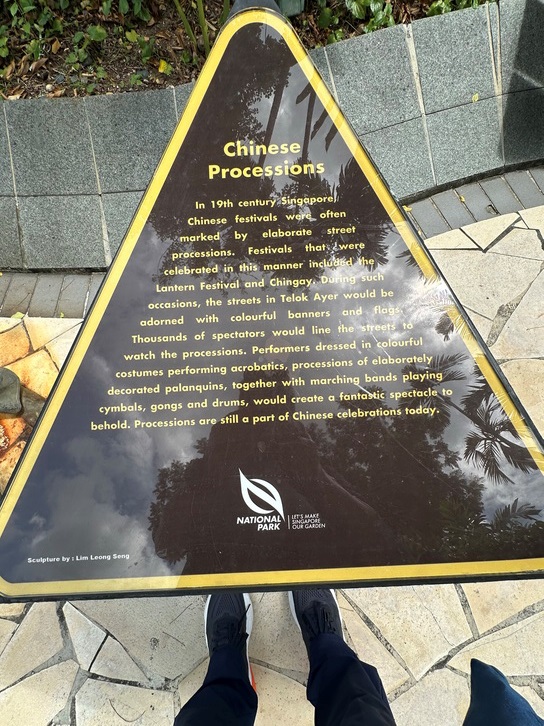THIEN HOCK KENG 天福宫
![]()
|
THIEN HOCK KENG
|
| TG49 | ||||
|
关羽
|
|
||
|
LITTLE RED DOT
|
|||
|
|
|||
各位贵宾,大家好 大家面前的这座庙宇就是天福宫,我们所在的这条街,叫做直落亚逸街 这条马路是单行道,请大家加快过马路的速度并注意从左边驶来的车辆
|
||||||||||||||||||
|
天福宫 直落亚逸的命名,来自马来话意思“海湾”。这个名字早在1822年便出现在莱佛士城市规划中。 直落亚逸街的俗称“源顺街”,因为早期这里有5大猪仔馆,其中一间便是“源顺号”。直落亚逸当时临海,是中国移民来新的第一站,在华工史上占了重要的位置。(首批移民来自厦门的苦力落户于直落亚逸街1821) 新加坡需要大量劳工南来开荒。大部分早期的华人移民都和本地公司立下契约,他们是由苦力代理人代为聘请的。船费由公司代付,苦力需要为公司服务约1到2年,直到还清所有费用为止,才能自由的找工作。也由很多的无良中介,为了赚取中介费,利用各种手段,拐骗当地的劳工南来。这些劳工其实是奴工,也叫猪仔。) 在1877年,殖民地政府规定猪仔馆和劳工经纪必须领牌照后,直落亚逸街附近的劳工客栈数目大减。这之后,源顺街在本世纪初,开始发展为华人的主要经济区和东南亚土产的聚散地。当时的牛车水是华人的住宅区,直落亚逸则是华人的经济区。
二战结束后,各行业逐渐复苏,负责替华人移民汇款回中国的汇兑民信行业兴起,其中以(闽帮的)民信局数目最多,大多数集中在直落亚逸附近。直落亚逸在新加坡经济上的贡献是不可磨灭的。 直落亚逸除了作为早期的华人经济区外,他也是早期一个集中体现各种族文化与宗教的区域。1880年以前,直落亚逸临海,有个提供船只停泊的小码头,中国帆船尤其是闽船都在这里起卸货物。 平安到达的华人,都到寺庙烧香祷告。因此直落亚逸区拥有多间历史悠久的古寺庙。其中,天福宫便是一个极具代表性的华人庙宇。 在新加坡较为著名的妈祖庙有,潮州人士“粤海清庙”1820年建,直落亚逸街尾端。海南会馆的天后宫;除了华人寺庙外,直落亚逸街有两间印籍人士建的回教堂。“阿尔阿布拉回教堂”1827【阿尔阿布拉回教堂:建于1827年,开始时只是一间小茅屋。信徒大多数是来自南印度回教徒,直到1986年大规模修葺后,才出现目前的景观】和“纳宫回教堂”1828;进北京街处“福德祠”1820年左右建) 直落亚逸可说是新加坡华文教育的起源地,最早的两间学堂都在这里创办。“崇文阁”1848年(天福宫的西侧)和“萃英书院”Cuì yīng shūyuàn1854年(天福宫后的厦门街),都是闽商陈金声支持创办的。
坐落于直落亚逸街的天福宫建于1840年。早前天福宫是临海而建,地理位置可说是依山傍水,前面的马路原是临海,后面便是安详山。 当时建庙的费用主要是由陈笃生和陈金声捐献的,共得到402名人士捐款。天福宫的建筑材料,包括石柱,栋梁,砖瓦,琉璃等,据说全是从中国运来的。建筑手法也属于正统闽南风格的庙宇建筑,工艺精细,雕刻手法多样化,建筑形式和题材丰富多彩。层层叠叠的屋顶、精美细致的屋脊装饰、屋檐屋角上的龙、虎、塔、人物、动物等雕刻艺术,完全是一座特显闽南风格的庙宇。 早期天福宫除了是庙宇也是福建人的同乡会馆,住宿的场所。当时的福建会馆就设在天福宫内。福建会馆对新加坡的华文教育有很大的贡献,著名的道南学校便是由会馆创办的。(对面8层楼的商业大厦。属于福建会馆所有,他们出租出去给公司当写在办公室,和其它用途。所得款项用于天福宫日常开销和维护,也用于会馆的经费等。)在2005年4月16日,由新加坡国务资政吴作栋阁下主持开幕典礼。 天福宫在1973年被列为国家古迹(新加坡至今由国家文物局所保留的古迹已有72座)。规模最大的一次修复工程是在1998年,当时耗资400多万元历时3年的庞大修复工程。为了保存原貌,修复过程采用传统的方法和材料多来自于福建。天福宫于2001年在大规模修复后荣获4个奖项,其中就包括:联合国教科文组织颁发的亚太文化遗产表扬奖,成为本地首个国际重点文化遗产。 天福宫所供奉的主神是护海之神“天后娘娘”,福建人也称为“妈祖“。(妈祖原名林默Lín mò,故乡在福建莆田湄洲岛Fújiàn pútián méi zhōu dǎo,相传她精通水性,又能预测气象,知道暴风雨的变化,所以拯救了许多海上遇难的船只。二十八岁[九月初九重阳日】羽化升天。从此以后,每当海难的时候,便传出妈祖显灵的事迹。妈祖因而成为保护海上生灵的神明) 妈祖一生奔波海上,救急扶危,挽救海难,深的民间敬仰,收到历代皇帝褒封Bāo fēng。妈祖的尊称为“天上圣母”,民间奉祀为“海神妈祖”。 建庙的目的:早期中国华人为生存,冒着风险,远渡重洋,来到南洋谋生。当时他们所乘的帆船就停泊在天福宫前不远处,平安抵达后,都会到这里祭拜,要向天后谢恩,报答天后保佑华人漂洋过海,安全抵达。凡南来或北归的华人,都会向妈祖娘娘祈求“海不扬波yáng bō,,平安返国”。取名天福宫是意思是指“神灵默佑如天之福也”。 天福宫也是少数结合道,佛,儒三教合一的华人庙宇。除了供奉的主神妈祖之外,还有供奉的神明就有观世音菩萨,孔子等。正因如此,天福宫也吸引着众多不同籍贯的善信前来参拜,每逢神佛诞辰更为热闹。进去再为大家一一介绍所供神明。
新加坡天福宫(Thian Hock Keng
Temple)是新加坡最古老、最著名的华人庙宇之一,主祀海神妈祖,用于祈求平安与保佑航海者。天福宫的建筑充满传统中华文化特色,其中火珠(也称火球)是屋顶装饰中的重要元素,承载深厚的文化寓意。
他们通常在火珠两旁呈威武的姿态,体现天福宫作为神圣庙宇的庄严与神圣。
天福宫共有3进,自外而内,依序会经过三川殿、中庭、正殿以及后殿,深长幽远,空间变化相当丰富。这种尊贵的“回”字形布局法,只有堂皇的大庙才会采用。早期采用这个设计可能寓意着能到达这里的人就安全了,像回家一样。
三川殿: 天福宫一共有三进,它的主要布局从外殿而内分别是三川殿、正殿(天妃殿)、后殿(观音殿)。 左右护廊和护室是庙宇Miàoyǔ左右两边的走廊,有遮阳避雨的功能。 三川殿,福宫的前殿,屋顶呈三脊型 sān jǐ xíng, ,所以又叫三川殿,这里是庙宇的正式入口,也就是所谓的“门面”:门前步口廊--正面壁堵Bì dǔ 天福宫的宫阁外形、木架结构,整个主体建筑没用一根钌子。Tiānfú gōng de gōng gé wàixíng, mù jià jiégòu, zhěnggè zhǔtǐ jiànzhú méi yòng yī gēn liǎo zǐ. 龙门进虎门出:寺庙门是分“中门”,“龙门”右边,“虎门”左边。在礼仪上一般人去寺庙拜拜比较少从中门进入,因中门大多是神明进出之门。人是从右门进入,从左门出来。寓意:入龙口出虎口,好运来坏运去。也有吉祥如意,消灾解难之意。 殿前的两级石阶:上层踏阶采用“柜台脚”下层为石盘,让人自此一路步步高升。
前廊外围的铸铁栅栏:是1906年专门自英国苏格兰特制,具有西方古典风格,是一般传统庙宇罕见的景观。 瓷砖:崇文阁里有一个专门收藏和售卖这类瓷砖店铺。里面还有卖美味的娘惹糕点。
圆形石窗:龙虎门两旁的圆形石窗,透雕技法,雕刻六只螭虎(6只眼睛),盘成香炉的图案,合称“螭虎围炉”圆窗四角雕刻四蝙蝠,谐音“赐福”,炉谐音“禄”,虎为兽“寿”,整体寓意“福禄寿”也有辟邪,吉祥,香火绵延之意。(螭虎:乃「龍生九子,未成龍」之一)
门神:春节是华族一年一度的传统佳节,不仅帖春联,而且请门神的习俗也延续至今。传统的门神,是唐代的两位武将-秦叔宝和尉迟恭。相传唐太宗李世民夜晚发梦,梦见被自己斩首的冤魂时时骚扰Yuānhún shíshí sāorǎo,坐卧不宁Zuò wò bù níng。于是派守秦叔宝和尉迟恭两个武将守门,果然有效,无奈的是不能将两位武夜夜守门,于是就将此二人的画像贴在门上,以求庇佑Bìyòu。这样的门神画也能凸显Tūxiǎn天福宫的地位,因为在以前这样的画只有宫廷官苑Gōngtíng guān yuàn才具备。
门上绘有太监:古代时,男女有别。在宫廷内院侍奉娘娘的都是太监。天福宫供奉的是妈祖女神,所以中门左右两侧门,门神都是伺候天后的太监,左右各一对,共四位。 四位太监手持神器各有不同。左门两位,一人持锦帛,一人持官印,合为“加官进禄”。右面两位,一人持宝剑,一人持令旗玉版,合为“文武双全”。有趣的是其中有位太监面目黝黑,被认为是异族太监,和传统形象不同,是南洋地域文化风情的体现。 大门上的图案:天福宫供奉的主神是天后妈祖,神格尊贵,所以中门设有最高规格的五爪双龙护卫。
各位朋友,您是否好奇,这些石碑记录了什么故事呢?让我带您穿越到1840年的新加坡。天福宫的建庙,是由福建帮的领袖陈笃生带头发起的。他不仅捐出了大笔资金,还亲自参与庙宇建设的规划和监督。
抱鼓石:是设在木板门槛之前,以稳定门面的石头。有时鼓面刻有螺纹,故又称为罗鼓石。前有彩结,象征好彩头。
门前石狮:中门两侧各立石狮,护卫镇守天福宫,具驱邪镇宅的作用。建筑功能也是稳定门面的石头。石狮造型生动,颈上的圈带系有响铃(红绸),表示已为神明驯服的神狮,石雕一般左雄右雌成对设置。左边雄狮开口含珠披彩,右边雌狮闭口抚幼。 大门对联:上“祥发湄洲,梯航捷至,恩垂北狄”下“德敷嘉里,栋宇聿新,福披南闽”Xiáng fā méi zhōu, tī háng jié zhì, ēn chuí běidí” “dé fū jiā lǐ, dòng yǔ yù xīn, fú pī nán mǐn "Good fortunes are spread to Meizhou, and the voyages are quick. The grace is spread to the northern part of the country, the virtue is spread to Jiali, the buildings are renovated, and the blessings are spread to the southern part of Fujian. 这幅石刻对联篆刻于三川殿正门,为1840年建庙时期原刻。内容赞誉起源仔湄洲的妈祖,保佑南北水陆交通平安顺利,恩福泽遍南北。
左小门对联:“圣德醐醍,光昭海表”“坤仪显耀,祥发闽中”圣神的恩德让人切身感受,光辉照耀四海;天后的尊贵无比光荣显耀,吉祥自福建开始。Shèng dé hútí, guāngzhāo hǎi biǎo kūn yí xiǎnyào, xiáng fā mǐn zhōng The holy virtue shines brightly across the sea. The female virtue is glorious and auspicious in Fujian.
上“圣德流芳万吉,声灵赫曜”“母仪比美千秋,俎豆馨香”神圣的恩德,万年都继续流传,声名非常响亮。圣母的尊贵,千年都继续永存,祭祀香火不断。 Shèng dé liúfāng wànjí, shēng líng hè yào. Mǔ yí bǐměi qiānqiū, zǔ dòu xīnxiāng The saint's virtue is everlasting, and her name is glorious. The mother's model is as beautiful as the ages, and the sacrificial offerings are fragrant.
右小门对联: 除了辟邪的功能,从飞禽走兽论四个方向: 左青龙(东), 右白虎(西), 前朱雀, 后玄武,也是道教的方位神。 传统匠师常将立面墙壁,以拟人化的部位分段,由上至下,称为:顶堵,身堵,腰堵,裙堵,柜台脚,均有彩绘雕刻。 Traditional craftsmen often divide the facade walls into sections according to anthropomorphic parts, from top to bottom, called: top block, body block, waist block, skirt block, and counter legs, all of which are painted and carved. 虎堵:【顶堵】长方画框白色粉底,一株枝叶繁茂的菊花,秋色满盈。古人赞誉菊花有五德,菊有冰清玉洁的品性,是君子的象征。在民间,菊花是吉祥,健康和长寿的象征。在庙宇吉祥图案里,取其“菊”的谐音“吉”大吉大利。【身堵】刻有一对大小双虎图,两虎周围有高耸树木和奇石。大虎俯首向下,眼神透露出慈祥,俯视紧随身边的一只小虎。真实寓意“教子下山”意味教育子孙成长,学习生活,可以继续传承家学,发扬光大。【群堵】一株包括含苞,盛放,莲蓬结子三连景的水上莲花。佛教被认为是净土的象征。中国文化传统中“花之君子”。在吉祥图案里,莲花谐音“清廉”,莲蓬加上莲子“连生贵子”【柜台脚】是承受整幅虎堵重量的基础,雕刻成长条书案状的柜台造型。
龙堵:【顶堵】一株躯干硕壮,枝叶茂盛的山茶花,春意满盈。山茶花吉祥图案中,也象征富贵,招财。和虎堵的菊花,形成春花秋菊的吉庆呼应。【身堵】一对大小双龙图,祥云缭绕,波涛汹涌。两龙对视,中间是熊熊火珠。这幅吉祥图案,一般说法是“双龙戏珠”其实意义是教子升天。图案象征“寿山福海,子孙昌盛”【群堵】花盏盛开的芙蓉花树,在传统文化中象征吉祥,美满,团圆。人们取其芙蓉谐音“富荣”,象征“荣华富贵”。
左右手边(东西两侧墙壁上)的牌匾(恩流海国,光被四表) Ēn liú hǎi guó, guāng bèi sì biǎo赞誉妈祖的恩德传遍四海,妈祖的光芒笼罩Guāngmáng lóngzhào四方。下面的两块碑记,记录了过往修复庙宇的捐款明细,这些都是宝贵的历史文物。也说明当时的福建会馆齐心协力,和庙宇修复好之后立此碑已是记录, 教育后代懂得饮水思源! 为了支撑屋顶,在屋檐璧间梁架需要安装许多附属构件,Wūyán bì jiān liáng jià xūyào ānzhuāng xǔduō fùshǔ gòujiàn这些都成为能工巧匠精雕巧饰的地方。【左右两梁的建筑形式是相同的,没有太大差异。但仔细观察,两面的雕刻和手法并不相同,这两梁架出自两队能工巧匠之手--“抖梁”(比赛式的形式)。】这也是中国南方庙宇的一大特色。梁架有格式木雕漆金吉祥花草,人物,瑞兽。造型各异,丰富生动,色彩绚烂。
左梁架:斗拱最上层束木“卷螺”:粉底绘莲花藕,莲藕同根,象征同心。第二层束木卷螺:彩绘萝卜,红菱,马蹄。萝卜又称菜头,谐音好彩头,象征好运。红菱,马蹄形状如元宝,表财运兴旺,好运连连。三者果肉均白色,象征高洁,生财有道。 承托斗拱的稳定部件,(一般雕刻狮子,故称狮座)。雕刻的是麒麟和运财童子,象征“麒麟运财”。(斗座上的斗拱,雕刻的是手捧珍宝的彩饰飞天,象征“洪福如天”)(鳌鱼是龙的第九个儿子) 衔接内外两柱的通梁看板,黑底擂金绘人物花鸟图案,中间绘历史人物故事;左右小图绘牡丹,芙蓉花鸟,象征富贵荣华。 通梁下的长形雕花板,(称为员光)红底金漆浮雕盛开的月季花,象征“四季如春” Left beam frame: The top layer of the bracket is a
"snails": the pink base is painted with lotus roots, which have the same
root, symbolizing the same heart. The second layer of the bracket is a
snail: painted with radish, red water chestnut, and horse hoof. Radish
is also called "cai tou", which is homophonic to "haocai tou",
symbolizing good luck. Red water chestnut and horse hoof are shaped like
ingots, representing prosperity and good luck. The flesh of the three is
white, symbolizing nobleness and making money in a proper way. 卷螺Juǎn luó:彩绘兔子和萱草。兔子是多产动物,萱草象征情亲,寓意子孙回报亲恩。第二层卷螺:老鼠与葡萄藤曼,老鼠葡萄均多产,藤曼延续,象征子孙繁衍。 承托斗拱的稳定部件,雕刻的是金须鳌鱼和运财童子,象征“鳌鱼运财” 衔接内外两柱的通梁看板,黑底擂金绘的是玉兰花,牡丹和一对白头翁,象征“玉棠富贵,白头偕老”。左小图绘双鲶鱼,鲶谐音年,象征年年有鱼;右小图绘花瓶果实,象征平安。
右梁架:在斗拱最上层束木“卷螺”:盛开牡丹,象征“花开富贵”;第二层的束木卷螺,绘莲花,象征一品清廉。 承托斗拱的稳定部件,(一般雕刻狮子,故称狮座)。雕刻的是金须鳌鱼和善财童子,象征“鳌鱼运善财”斗座上的斗拱,雕刻一株盛开的牡丹花,象征“高居富贵” 衔接内外两柱的通梁看板,黑底擂金绘的是牡丹花和一对白头翁,象征“白头富贵”。左小图红杏瓶花,象征幸福平安;右小图绘蝴蝶蜻蜓,谐音“鹣鲽情深” 通梁下的长形雕花板,红底金漆浮雕梅花和喜雀,象征“喜上眉梢”
Right beam frame: On the top layer of the
bracket, the "snails" are in full bloom, symbolizing "flowers blooming
and wealth"; the second layer of the brackets are painted with lotus
flowers, symbolizing the first-class integrity.
正殿: 香炉:宫内安置4个青铜香炉。主炉安置在对着妈祖像的中庭正中,有一座大型宝鼎香炉,双耳四足,上部作殿堂式设计,形式和正大殿相似。四角悬挂风铃,下部炉身四足为象鼻,代表了四个方向。造型独特体制庄严,铸刻了精美的祥龙图案。
这个香炉叫做四象香炉,正因为香炉的四个脚, 是四个大象头,因此而命名,造型别致。在香炉的最底下有个半圆形的球,叫做寰宇,代表宇宙,意思是你在这里上过香,就相当于 是把全宇宙所有神明都敬拜到了。御路石:拜廊石街正中,有一个雕云龙图案的石板座,称为“御路石”又称“龙阶”起源于皇宫。因为中轴线只有皇帝才可以走,皇帝出入坐轿,于是将阶梯中央做成斜坡,两侧的石阶让轿夫行走。“御路石”主要是供神轿通过,一般人只能从左右石阶上店。妈祖是天后级别神明,所以设置有御路石。
香案:祭祀神明的香案,案和桌的造型相似,一般公堂公事用案。镂空雕琢复杂吉祥图案,有龙凤花草。是民间艺术融合佛道于一体的表现。
晨钟暮鼓:东西两端高处,设有钟(日本制造1906)和鼓,是庙宇的法器,原为古代乐器。后来用于报时。(晨钟暮鼓:钟声可以传到远处提醒来拜的人,已经开了可以来参拜了。晚上用鼓声告诉人们要离开了,参拜时间已到。比较礼貌而又方便的做法。) 大家早上好,请允许我点一下人数,好的大家都到齐了。我是今天的导游xxx,可以叫我x导,欢迎大家参加今天的多元文化之旅。我们现在所在的地方是天福宫, 刚刚我们讲过了天福宫是新加坡最古老的庙宇之一,所以你会看到这里的很多东西都蕴含了不同的文化,其中就包括了我们刚刚经过的鼓和现在看到的钟,你们可以看一下这里,他们被分布在天福宫东西两端的高处,他们也有一个特别的名字叫晨钟暮鼓。顾名思义就是早晨敲钟晚上击鼓。
盘龙抱柱:一对青石雕刻的盘龙抱柱。嘴巴张开含珠的是雄性,另一面的则是雌性(这也说明的了男尊女卑的寓意)男主讲,女听从。柱间祥云,还雕塑有东海八仙,左右各四位,象征东方日出,龙跃东海,八仙渡海祝寿吉祥热闹情景。龙柱下方的圆鼓型称为“柱珠”(防止柱子受潮),四周浮雕4匹姿态各异的骏马。这种蟠龙的雕刻设计理念, 还有一个典故。(鲁班是春秋时期的能工巧匠。一次,他为建造一座壮观漂亮的房屋,去向东海龙王借座宫殿来效仿。鲁班向海龙王说明来意。海龙王赞赏鲁班的好手艺,答应把龙宫借给他三天,日子一到就得归还,一个时辰也不能拖延。这座宫殿庄严富丽,每个细节都异常精巧。鲁班和弟子照样造屋。三天的期限到了,屋子没能完工。鲁班吩咐弟子把龙宫用木桩固定在地上无法搬起。这天晚上,东海龙王果然派虾兵蟹将来搬。龙宫已经被钉上木桩,无法搬动。天亮了,灼热的太阳,把龙晒死了,龙身蜿蜒在屋脊上,鲤鱼粘死在大门的门乳上。鲁班见此景觉得如依照这个方式建造房屋更加壮观,就用泥上塑成栩栩如生的龙头、龙身、龙尾装饰着屋顶,用黄铜打成鲤鱼形状的门乳,使造出的房子比龙宫更气派。)
正殿:大殿内(匾额,栋梁,主神) 是寺庙建筑中地位最尊贵的殿堂,是庙的核心,因此建得特别高耸。天福宫的正殿,从基座到屋顶高达15.65米。正殿金柱耸立,有14根直径46厘米,高8米的圆形金柱,和一对直径为42厘米的八角形对柱(宋代风格),石柱基(青石)可保护木柱防潮与撞击。有圆形与八角形,都刻有吉祥花鸟或暗八仙(八仙的法器,代表吉祥之意)
光绪帝题字牌匾:“波靖南溟”寓意南海风平浪静,匾额上端有御印“光绪御笔之宝”六字方印(只有皇帝的御印在中间,普通都在下款)是清朝光绪皇帝于1907年御赐的匾额。悬挂在正殿最高处。匾额周围雕有5条金龙,其中上段雕着的两条护火珠金龙,龙的前爪捧着一管细长的锡制圆筒,圆筒于1999年天福宫大修时被发现打开,里面有“波靖南溟”原件真迹。真迹修补后现存于新加坡历史博物馆。(得此御赐的除了天福宫还有一处是潮州人捐建的“粤海清庙”。题字:“曙海祥云”)(如何来到新加坡:光绪御弟醇亲王曾于1901年7月31日莅新,并于同济医院接受侨民递送颂词)Prince Chun, the younger brother of Emperor Guangxu, visited Singapore on July 31, 1901, and received eulogies from overseas Chinese at Tongji Hospital. 栋梁:在屋顶的最高处,巨大的彩绘主梁,就是最重要的大梁,以行成屋脊,是传统木结构建筑中一根最主要的完整木头,安放时需要举行隆重的上梁仪式。(大梁彩绘为最高级的“和玺彩画”形式)中间画面为双龙护珠,龙前还有葫芦,仙书等吉祥法宝,周围祥云缭绕,金碧辉煌,十分庄重。彩绘的油漆涂料里含有铜,可以防潮,防腐蚀,防虫蚁。
左右梁架:闽南沿海,古庙宇多因八仙渡海的传说典故,多用八仙装饰 。两端斗座为瑞狮,中间6座为麒麟色彩华丽,上有八仙,左右各四位。(瑞狮斗座,蓝采和手持大拍板;刘海蟾,手持大串金钱;何仙姑,荷叶披肩,唯一女性;汉钟离,坦胸露乳,手持云板,法器与一般手持扇子形象不同;铁拐李,头戴金箍,手持金拐;吕洞宾,披袍持剑,戴冠长须。曹国舅,身穿红袍,头戴纱帽;瑞狮斗座,张果老,头须银白,手持鱼鼓。明朝以前,八仙成员并未确立。以后有韩湘子没有刘海蟾)(八仙代表:男女老幼贫贱富贵,八种不同人群) 祈锦旗求绣球必毛笔应盖印(取其谐音)大殿上方可以看到,寓意着神灵有求必应。
The two ends of the fighting seat are
auspicious lions, and the six seats in the middle are colorful unicorns.
There are eight immortals on the top, four on each side. (Lion fighting
seat, Lan Caihe holding a big clapboard; Liu Haichan holding a big
string of money; He Xiangu, wearing a lotus leaf shawl, the only female;
Han Zhongli, bare-chested, holding a cloud board, the magic weapon is
different from the general image of holding a fan; Tieguai Li, wearing a
golden hoop on his head and holding a golden crutch; Lu Dongbin, wearing
a robe and holding a sword, wearing a crown and a long beard. Cao Guojiu,
wearing a red robe and a gauze hat; lion fighting seat, Zhang Guolao,
with a silver beard and a fish drum. Before the Ming Dynasty, the
members of the Eight Immortals were not determined. Later, there was Han
Xiangzi but no Liu Haichan) (The Eight Immortals represent: men, women,
old and young, rich and poor, eight different groups of people)
主神:正殿妈祖(道教)(诞辰:农历三月二十三日):妈祖是天福宫的主神,是华人海上守护神。安置于粉面妈祖前的黑面妈祖神像,为早年中国帆船上供奉的软身妈祖;是1840年天福宫落成时,由中国请来的,当时还举行了一个隆重的迎神盛会。 如今的新妈祖金身,是2000年庙宇大修时自中国福建特别定制的。以坚固的杉木制成,动员了12个人才能扛进正殿。天后服饰,戴九梳冠冕,端坐宝座,宫娥侍立,宝相庄严。 Dài jiǔ shū guānmiǎn, duān zuò bǎozuò, gōng'é shìlì, bǎo xiāng zhuāngyán
妈祖的前面左右两边还有两位形象独特,红绿肤色的神将。
顺风耳(红身)
,小弟高觉 大哥高明 他们就是千里眼(绿身)能眼窥宇宙万象,检测海平面的情况;顺风耳(红身)能耳听世间众音,二人共同辅佐妈祖救苦救难的圣行。(悬挂在神龛上端的“神昭海表”匾额于1840年由中国福建各县信徒所赠,是天福宫创建时期就有的重要文物)
千里眼和顺风耳典故: 他们是商代时期纣王Qī zhòu wáng的大将大哥高明,小弟高觉。一次与姜子牙交战而身亡,死后阴魂不散四处飘游,盘居在山上危害百姓。 妈祖独自前往收妖。经过一番恶战,二怪投降。从此辅佐妈祖驱邪镇恶,保佑众生。 (千里眼和顺风耳):在妈祖左右的就是顺风耳、千里眼。 为什么会有顺风耳和千里眼在妈祖左右呢?顺风耳和千里眼是兄弟,哥哥 叫高明,弟弟叫高觉,作战身亡,魂归桃花山,然后就变成了扰乱地方、祸害百姓的妖精。后来妈祖经过此山,想为民除害,但是高氏兄弟向妈祖逼婚Bīhūn。妈祖就和高氏兄弟约定斗法,如果妈祖输了就嫁给他们,如果妈祖赢了就收服他们。高氏兄弟表示同意,经过一番恶斗,兄弟两落败,被妈祖收服,以他们的本领,协助妈祖在海上循声觅迹Xún shēng mì jì,解救遇难者。
保生大帝(诞辰:农历三月十五日):妈祖右边供奉的是保生大帝,为北宋福建人士。又称吴真人,是一位神医,医德高尚,一生救死扶伤,深受人民敬仰。 保生大帝中国闽南地区华人所信奉的医神。为信徒祈求平安健康。悬挂“护国庇民”牌匾。Xuánguà “hù guó bì mín” páibiǎn./Hang a plaque with the words "Protect the Country and Protect the People".
关圣帝君(诞辰:农历六月二十四日):妈祖左边供奉的是关圣帝君,原名关羽。为汉末名将,为人忠义正直。为儒释道三教皆供尊,清代以后,商人敬佩关公的忠诚、信义和勇武,把他当作财富的守护神,敬奉为武财神。关公祖籍山西运城,所以悬挂“山西一人”牌匾。 厢廊:衔接三川殿和正殿之间,的有盖走廊。 作用:人们可以避雨遮阳。可以观赏屋顶的吉祥彩饰。(左、右廊位于庙宇左、右两方的走廊,把三川殿和正殿,联结成完整的合院,形成一个“口”字)。(庙宇的建筑装饰语言常以图像为象征,用其读音的谐音,表达吉祥祝福) 一对瑞狮与吉祥花草纹,象征事事吉祥。 梅、兰、菊、竹“四君子”。芭蕉、宝扇拐杖“暗八仙”法宝(以八仙为主题或是代表八仙的暗八仙纹样,代表祈求高寿寓意。 廊道两端托座:飞鹰-英明;蝙蝠-福到;双鲤-盈利;花翎-富贵;香炉-吉祥 瓦当/滴水:下雨小雨时-似瓦当滴水,大雨者形成珠帘,诗情画意。 金莲花吊筒:雕饰大盏金莲花,形如碗莲,象征吉祥如意。并将屋顶的重量传到柱子上。 以子嗣昌盛为征者:求子嗣是华人传统中一项重要的追求,古语云:不孝有三,无后为大。庙宇上的绘画以多子植物或动物为象征。鱼类:产卵量大,人丁兴旺,繁荣昌盛。老鼠:多子多产的象征,多与金瓜合为建筑装饰。“老鼠咬金瓜”象征多子的兴旺与吉祥。 以长寿为象征:动物-鸟雀、仙鹤、鹿。植物-菊花、松柏、仙桃。
敢番抬庙角:天福宫的屋檐下Wūyán xià,,会出现服饰模样似西洋人或蛮人的人物,他们满脸笑容,有的浓眉瞪目,早期华人和西洋人接触影响的结果,建庙时也不忘把他们刻画进来。(古时需要负荷重量的支架,古人会用力量大的动物,大力士等造型装饰。) 鳌鱼:外形龙首鱼身,神采奕奕,象征独居鳌头,出人头地。 官帽:整体感觉做官的官帽,预示走过的贵宾都可以官运亨通,飞黄腾达。 柱子顶上有雕刻虾,蟹,是南方庙宇特有的水族图案,都是壳甲类。在科举时代象征科举成功,象征功名。现在寓意富甲天下。(螃蟹横着走,寓意横行四方) 绘有“黄色的李子”,后面有“桃子”:寓意投桃报李。来而不往非礼也。这是礼仪之邦的习惯和规矩,也是儒家思想的传承。 佛手瓜谐音:福寿;葫芦谐音:福禄;鲇鱼:年年有鱼; 有三元的雕像,连中三元。牡丹象征财富。鹿与禄同音。 天福宫牌匾周围有很多仙女雕像,仙女的肤色还有其他种族的肤色,寓意受南洋文化的影响。 以祥瑞为象征是传统庙宇最重要的装饰语言。匠师们通常以山、川、水、云等自然祥瑞的象征。在庙宇建筑中祥云多会伴随祥龙一起来装饰,因为龙能从云行雨,有利于弄作业,云龙时祥瑞之征。 雕塑是工匠敲碎陶瓷碗后,一片片黏上的,这就是当时极为流行的“剪磁”技术。它的好处是色彩丰富,而且不怕风雨历史岁月的洗礼、风吹雨打都不会褪色。凤凰和牡丹,凤凰是人们心目中的瑞鸟,天下太平的象征(凰鸟为鸟中之王)。古人认为时逢太平盛世,便有凤凰飞来。牡丹花大而艳丽是百花之首,被人们视为富贵昌盛的象。凤凰长于花中之王牡丹相辅相衬。风调雨顺,寓意国泰民安。 东配殿:在建筑布局上,这排建筑也称偏殿,厢房,是供护中央建筑群的外墙。通常采用开放式厅堂格局。(木栅栏:古代中国官府衙门的两边廊间,会设置朱红色木栅栏)
伽蓝菩萨:在梵文里面是寺院的意思。伽蓝菩萨即是保护寺院,拥护佛法的菩萨。中国佛教的伽蓝菩萨,即关公,东汉末年三国时期人。相传隋朝智者大师在玉泉山上入定时,云开月朗,看见两个有王者风范的人,长者就是关羽,年少者为关羽之子关平。父子二人死后灵威在此,向智者大师致意问及上山原因。智者大师告知想在玉泉山上修建道场。关羽愿为智者大师建寺,护持佛法,并请大师安心坐禅,七天之内建立寺院。大师出定后,以所示方向去看,果然有一寺院,大师欣然率众入舍尔住Dàshī xīnrán lǜ zhòng rù shě ěr zhù。一日大师正在说法,关羽来听讲。关羽对大师说:“弟子今日幸闻出世法,愿永修菩提,愿大师为弟子受戒Shòujiè”大师即秉烛焚香,为他受了五戒(第一戒杀,第二戒盗,第三戒邪淫,第四戒妄语,第五戒酒)从此关羽成了佛教护法,镇守伽蓝 qiélán,,也就是中国寺庙里面的伽蓝菩萨。而站立他身后的两人:左者为他儿子关平,手奉关羽大印;右者是其贴身侍卫,周仓,Zhōu cāng手持关羽大刀。 伽蓝菩萨(匾额):1852年立的“威灵昭赫”立匾人黄光传,天福宫建庙三大董事之一,富商闽帮领袖。 孔子殿:原名孔丘,字仲尼,生于鲁国(山东曲阜人)是个伟大的教育及思想家。儒家思想的创始人。他编写的“春秋”是中国最早的史书。孔子的学生也把他的语录编为:论语。孔子端坐中间,金冠宽袍,慈眉善目,面带笑容。左右两弟子,孔子左侧捧书的是孔门最好学的颜回,右侧持剑者是孔门文武双全的子路。看孔子的手势,两掌叠放,掌心朝内,左手在外,右手在内,这是古代人相见礼,表示虔诚恭谦之意。易经上的“爻yao”字,也正是甲骨文“教”字的写法:代表孔子有教无类,平等和谐的教育思想。(不分贵贱)。新加坡本地人会摆上蒜(会算术)葱(聪明)豆腐(福建发音,音译)芹菜(勤奋)来祈求孩子的学业进步,成绩优异! 孔子殿(匾额):“画一轩”Huà yī xuān”这个匾额biǎn'é百年来一直悬挂于此xuánguà yú cǐ,是早年会馆聚会处堂匾 táng biǎn.。2000年翻新过。 祖先排位:(这里供奉的祖先排位比较少,最好在西配殿处讲) 厕所位置在祖先排位殿旁 许愿井:据老香客说,早期天福宫庙内曾有一口井,善信逢到天福宫都会喝一口井水,祈求庇佑和身体健康。此井具体位置不祥,只知靠近此处,已封井多年。天福宫特制作一口类似古井的“许愿井”。让大家祈求心想事成。 许愿方法:轻轻敲打铜钟一次合掌,闭目,默许愿望,将钱币投入许愿井中。 后殿,位于正殿后方,是整座庙宇最后方位置的殿宇:供奉了佛祖和至圣先师孔子,此外,内部也供奉观音、南海佛祖、月亮娘娘和太阳公等神明。 装饰: 后殿屋顶左右,分别装饰有剪贴彩朔的一对鳌鱼,这是成功跃过龙门、龙首鱼身的新龙,规格仅次于正殿的飞龙。后殿屋顶正中的火珠,中间为图案化的“福”字,是颗充满福气的福珠。 观音殿侧墙,1906年重修时所造的三心圆拱窗及饰花壁柱,具有西方新古典建筑主义风格,是传统庙宇中难得一见的西式风格。 匾额: 1856年立“梯航默祐”,立匾人陈金钟,为天福宫第二代领袖,当年东南亚最大米商,自拥船队航行中国与东南亚各港,领导新华闽帮社会近50多年。
观音菩萨(又称观音殿):亦称“观音”从字面解释就是观察世间声音的菩萨。她以大慈悲之心,无时不惦念着世间的疾苦Wú shí bù diànniànzhe shìjiān de jíkǔ,解救众生于苦难之中。救苦救难,普渡众生。是18手的准提观音菩萨,准提为梵语的音译,意思为清静。(四马路观音庙供奉相同)十八臂或千手千眼,各持法器,显示无边法力。 关于观世音的传说有很多。佛教传入中国后,观世音菩萨以女性的化身出现。传说妙庄王女儿妙善,自小一心向佛。妙庄王欲为她招驸马,她是不从而出家。父王极为气愤,从中刁难,又试图放火烧寺。妙善空手灭火,却毫发无伤。妙庄王见状而感到害怕,下令将她处死。慈悲为怀的妙善死后,修成正果,化为观音,得道升仙。她在升天之际,忽然听到身后凡间传来哭声,决定重回凡间,直到救度所有众生脱离苦海。(现今社会,着重财富,内心空虚,常被烦恼与物资所蒙蔽。变得冷漠,我们应向观音菩萨学习慈悲精神,回馈社会)
太阳公(菩萨左手方向):又称日光菩萨,太阳神。他生于东方,巡行天地,划分昼夜,他是世间的守护神之一,帮助驱除黑暗,疾病和敌人。
月宫娘娘(菩萨右手方向):又称为月光菩萨,月神。在夜空中,月亮给人带来光明,也是民间流传最广的神明之一。今时今日,一般未婚少女,比喻她为红娘,姻缘一线牵,祈求找到如意郎君,美满婚姻。已婚妇女则祈求家庭幸福,青春永驻。
西配殿: 祖先牌位:在新加坡我们都是好几个孩子,长辈去世后,如果排位放在大哥家,不方便其它兄弟姐妹祭拜。所以有的家庭就会选择把祖先牌,供奉在庙宇。这里每天都有香火,而其里佛祖近,青云缭绕。(这里也可以讲祖先牌位的由来) 德盛祠”供奉的神明,是福建闽南人最感恩戴德的“开漳圣王”原名陈之光,当时福建漳州一带,是个未开垦的地方。陈之光奉命到闽南开垦荒地,修建水利,截江筑陂。他促使闽南经济繁荣昌盛,人民安居乐业,为老百姓造福。为感恩陈之光恩德,民间造其塑像,并建庙来拜祭。(陈笃生也是漳州人,他们对开漳圣王的恩情相当于新加坡人民对于莱佛士和李光耀的感觉。)殿堂神龛正中,陈元光身着金甲戎装,左右文武部将,神态威武鲜明。
城隍殿:供奉的是地方神城隍爷。城隍一词最早见于“周易” ,是法官的意思。城指城墙,隍指的是城外壕沟水池,环绕城镇保护人民的生命和财产安全,并抵御敌人入侵。城隍后来被赋予生命,演变成保护安民的神明。故此,人民对城隍甚为敬畏。城隍也有许多的下属:文武判官:谢将军,范将军,牛马将军等等。据说城隍在阴间掌管人间善恶的记录和死者亡灵审判的职务。 左右两尊俗称大爷伯和二爷伯的差役: 谢将军(大爷伯,七爷)白无常 范将军(二爷伯,Èr yé bó八爷) 是城隍庙不可缺少的要角。他们专门押送犯人到阴曹地府接受审判。(前面都有放置烟灰缸) 传说:相传两位将军原在福州衙门当差,感情很好,成为结义兄弟。他们行为端正,心地善良,不随便抓人,受到民间百姓的尊敬。有一天,两位将军为衙门出公差,来到南台桥突然乌云密布,七爷建议回去取伞,便和八爷相约桥下回合。不料七爷回家后肚子忽然绞痛,只好躺在床上。八爷不知七爷有事耽误,大雨倾盆,河水不断涨高。八爷心想七爷是个守信之人,就抱住桥梁始终不肯离去,终于被淹没。死时脸色因挣扎而变成赤色,以后手上拿着令牌“见恶便拿”,后人称为“黑无常”。七爷赶到桥边后,认为八爷的死是自己造成的,深感自责,决定以死谢罪。他跳入河中,因个人太高淹不死,只好走到大树上吊解决生命。据说死时舌头伸出很长,以后手上拿着令牌“见笑” 头帽写“一见大吉”,称为“白无常”。世人对不守信着就引用这句“不可抱桥失信”,以示警惕世人坚守信义,善恶分明,自由果报。 匾额“显徹幽明”Xiǎn chè yōumíng/Clear and bright是清朝驻新加坡领事左秉隆所敬献Xīnjiāpō lǐngshì zuǒ bǐng lóng suǒ jìngxiàn,代表大清王朝对天福宫地位的肯定。
天福宫内额外资讯: 右护室,可看到会馆昔日供同乡聚会、住宿的厅房,现在大部分空置着;以往的右翼殿仍旧作为祭祀用途,供奉先人神主牌,称“德盛祠”。 左护室是福建会馆最早的馆所,现在,这里金漆的格扇与大红门框等,都是新郎新娘结婚取景的热门地点。 庆德楼(玉皇宫) 1831
庆德会,土生华人所建,里面奉祀着20个不同姓氏的先人,很可能是土生华人之间用以联络感情的公会组织,但并不属于天福宫。 至于大家右手边的建筑,原名“庆德楼”,曾经是是土生华人商会“庆德会”所在地,1831年建成。现在已经从天福宫独立出来,成为主祀Zhǔ sì道教主神玉皇大帝(也称“玉皇上帝”)的“新加坡玉皇宫”。
在大家右手边的庆德会早期是土生华人的组织,由36位土生华人(峇峇)在1831年所创立的,他们多数来自马六甲,入会时在三官大帝前结拜为兄弟,并每人拿出一百西班牙大元成立救济基金,用来帮助遇难会员的家属。其他的会规包括会籍只传男性后裔,严禁女性上二楼, 每年在五大庆典祭祀祖先(上元节,中元节,下元节,清明和冬至)。 2009年庆德楼正式列入第一批国家古迹中,2011年庆德会迁移至樟宜路,将庆德楼交給新加坡道教协会,现在改名为《玉皇宫》。
崇文阁,最早是新加坡第一间华文学塾,后来改为崇福女校,之后一直空置着。虽然它跟天福宫关系密切,但并不属于庙宇的色彩奖。 大家可以注意到,天福宫左右两边还有两栋风格类似,但比较小的建筑。 大家左手边的是崇文阁,原本是一间私塾Sīshú———私塾指的是中国古代由私人教师开设的学校。这件私塾由陈金生在1849年提议创办,后来成为福建会馆属下的崇福学校,并从崇文阁建筑搬到现在的义顺一带(在新加坡北部)。现在这栋建筑是空置的,所以前面有红线封住。
连接词--- 知道了天福宫的概况和外观,现在让我们更近一步,来仔细了解天福宫。我们需要越过直落亚逸街,这条街是单向车道,请大家留意右手边驶来的车辆,在我举起手的时候和我快步过马路。【带游客们过马路到三川殿前,找合适的站点继续讲解】_
额外资料: 额外资料: 天福宫的壁画:乡情
天福宫的壁画全长40米, 是由本地业余壁画作者叶耀宗, 历时3个月完成的。 壁画的名字为“乡情” 这座壁画是为了福建文化节所绘制的, 她一共分为三个部分 第一部分“过番下南洋”讲述早期中国人为了躲避清朝关税的压迫,下南洋淘金的辛苦;
第二部分重点在于天福宫早期的“游神庙会”早期每逢妈祖诞辰,信徒就会抬着妈祖的像出游,早年也算很大的活动。很多善男信女都跟随妈祖出游,一祈求安康。 第三部分反映现在新加坡的发展,可以看到驳船码头的繁荣和整洁,河边的矮小店屋和身后的高楼大厦相辉映,反映出现在新加坡经济腾飞的景象。
雕像1小帆船:早期小的驳船把货物从大船运到新加坡河两岸的货舱。 雕像2买牛奶的小贩:早期的印度人以畜牧业为生,他们会这样沿街贩卖牛奶。 雕像3早期节日庆典:早期的华人有很多节日,直落亚逸街会举办很多华人节庆活动, 这种传统文化一直延续至今。
开放时间: 每天上午7:30至下午5:30 入场免费
如今,天福宫的香火仍盛,很多善男信女出远门前,仍到天福宫向神灵许愿,祈求旅途平平安安。
|
||||||||||||||||||||||
|
TG49时间: 12 Feb 2019 / good 温馨传递:我们是 49 班的套路群组,我们只愿用自己的时间以节省 你们的时间,诚意之作,不喜勿喷。预祝各位考出好成绩! 天福宫 Set I:市区观光 景点二 请大家随我到马路对面一起观赏天福宫的全貌,这条马路是单行道,请大家加快过马路的速度并注意从左边驶来的车辆。 各位贵宾,大家好,外面现在来到的就是市区观光的第二站,天福宫了。 1. 位置+街名介绍:大家面前的这座庙宇就是天福宫,我们所在的这条街,叫做直落亚逸街,直落亚逸,马来文的意思就是“海湾”,早期的天福宫是临海而建的,大家看到的这些高楼大厦,以前都是大海。而在这直落亚逸街上最显著的华人建筑,就是供奉妈祖的天福宫,也是是新加坡最古老的华人庙宇,在2001年还被列为教科文组织亚太文化遗产建筑。 2. 建庙原因(重点):据说,在1810年就有人在这里设坛供奉妈祖,到1821年发展成一间小土庙,我们现在所看到的天福宫是1839年开始修建,1842年完工的,耗时三年,耗资3万7千多西班牙银元修建的。由当时的慈善家陈笃生等有权势的福建社群领袖筹资筹建的,从而这里也是当时闽帮华商汇集的场所,福建帮总机构所在处。天福宫只要供奉的是护海之神“天后娘娘”,福建人也称为“妈祖宫”,但凡 即将扬帆起航或历经风浪而安全抵岸的华人,都会把船舶碇在宫前,向妈祖娘娘还愿祈求平安。但除了妈祖,天福宫也是少数结合道、佛、儒三教合一的华人庙宇。因为在这里你既能供奉主神妈祖之外,其他供奉的神明还有观世音菩萨、孔子等。 3. 全局介绍:天福宫一共有三进,它的主要布局从外而内分别是三川殿、正殿(天妃殿)、后殿(观音殿)。左右护廊和护室是庙宇左右两边的走廊,有遮阳避雨的功能。 那一定有贵宾好奇什么是三川殿?三川殿就是天福宫的前殿,也是三进里的第一进。大家请看天福宫的屋顶,它分为三段,中间高两边低,是很典型的三川殿的特色。四个燕尾称为三川脊。中间的叫正脊,是屋顶中央最高的脊梁,常在这里建有双龙抢珠,双龙护塔或者福禄寿三星,天福宫是双龙抢珠。竖着的四条叫做规带:又叫垂脊,就是屋顶上面前后随瓦垂下的脊,最前面的叫做牌头,位于规带的末端,常有华丽装饰,中间的叫板瓦和筒瓦。前面的叫瓦当和滴水,一到下雨天,雨水打在瓦片上发出叮叮当当的声音非常悦耳啊,然后顺着圆瓦和板瓦汇集到滴水,一滴滴顺流而下像断了线的珍珠,堪称是难见的美景。 (请大家看你们的左手边是崇文阁,右手边是庆德会) a)(崇文阁:过去现在:)崇文阁1849年建起后,作为私塾使用,是新加坡最早的华文学校,也是具有慈善性质的学校,为福建人提供学习的地方,所以早期的教学语言还是福建话。崇文阁之后改为崇福女校,崇福女校搬走之后,现在的崇文阁里面已经改建成音乐盒博物馆,楼下是卖漂亮的娘惹瓷砖和美味的娘惹食物和咖啡厅,如果大家有兴趣,等一下可以进去参观一下。 b)(庆德会:过去现在:)在大家右手边的庆德会早期是土生华人的组织,由36位土生华人(峇峇)在1831年所创立的,他们多数来自马六甲,入会时在三官大帝前结拜为兄弟,并每人拿出一百西班牙大元成立救济基金,用来帮助遇难会员的家属。其他的会规包括会籍只传男性后裔,严禁女性上二楼,每年在五大庆典祭祀祖先(上元节,中元节,下元节,清明和冬至)。2009年庆德楼正式列入第一批国家古迹中,2011年庆德会迁移至樟宜路,将庆德楼交給新加坡道教协会,现在改名为《玉皇宫》。玉皇宫分为前方的山门,中间的玉皇阁和后方的庆德楼。 (连接词:由于天福宫是华人庙宇,华人庙宇又对建造非常考究 精美,接下来我们走近它,去欣赏一下) 第二站点:中门台阶下 首先,天福宫的精美我要先从它的名字开始说起。大家知道吗?(指向天福宫的牌匾)天福宫这三个字来自“神灵默佑如天之福也”,意思感谢天后妈祖的保佑,使得华人漂洋过海,安然南来,这也是当初建庙的原因。 那建庙后自然就需要有人来守护了,它们就是这一对造型可爱的石狮子。它们是用来辟邪镇宅的,大家知道哪一只是母狮子吗?对了,左边这只正在抚摸幼狮子体现母爱的就是母狮子,右边这只脚下踩绣球的是公狮子。它们还是乖巧的狮子呢?为什么呢?大家看它们都戴着铃铛,表示了它是被神明驯服过的狮子。 我们再往下看,来瞧一瞧这地砖和铁栏杆。因为天福宫从1839年到现在已经100多年历史了,大家看到现在的天福宫还是这么完好是因为在这么多年中也经历过翻新。而在1906年的大翻新中,天福宫加入了一些西方元素,例如这铁栏杆和地砖。铁栏杆是来自苏格兰的,十分的牢固, 而且在那时候是无比的昂贵,只有名门贵族才用得起,也说明了天福宫的崇高地位。还有栏杆前五彩图案别致的地砖是来自荷兰的,色彩鲜艳还耐磨防滑,便于漂洋过海来祭拜的人 们。 一般我们看到的庙宇的三川殿都只有三个门,而天福宫有五个门,这也是象征主神身份地位的很高。最中间的大门,一般是给神明(或者身份地位很高的人:括号是觉得就说神明比较好,怕冒犯到游客觉得我们说他们身份不够高)走的。那我们该从哪个门进庙呢?其实进庙也是很有讲究的,请大家随我移步。 我们应该从这个门进!为什么呢?因为根据风水,最好的进庙方式 就是进龙门,出虎口。那怎么知道这扇门就是龙门呢?请大家看这面墙,(龙虎堵,青龙白虎石雕)这整面墙叫做龙虎堵,根据古代道教的方位学说,他们认为天上有28星宿,分为四组代表四个方位也就是我们所说的四象,每个方位有七个星宿,东:青龙,西:白虎,南:朱雀,北玄武(龟),我们所看到的这副石雕就是青龙石雕,对面的就是白虎石雕了。所以这扇门,就是龙门。民间有跃龙门,脱虎口之说。所以我们从龙门进,沾沾好运,等下从虎口出,去去晦气。 那在进庙之去之前再看看看这些很有特色的石窗和石柱,它们有什么特别寓意吗?这一扇窗叫做螭虎石窗,主要是通风兼具着美观装饰的作用。我们来看一下他的花纹,四个角各有一只蝙蝠,就是4只蝙蝠,取谐音为赐福。中间圆圆的花窗其实雕刻着六只螭虎围着香炉,香炉上面还有一只蝙蝠。整幅石雕的意思就是,福禄寿。福就是蝙蝠,禄就是香炉,寿就是螭虎猛兽的兽。 这两座石柱是抱鼓石,其实也叫做门枕石的一种,是为了稳定这个门柱,这里雕刻的是卷螺纹和花草的图案。(民间传说)据说,这是传说中的门当户对的门当了,古人重视门弟等级观念,婚姻大事更是如此。千百年来的中国社会当中,人们给自己的孩子寻找联姻对象都是请媒人来进行的。古时候媒人在说媒前都要先观察一下这家人的“门当”纹饰、形状和“户对”数量。官找官,商找商, 老百姓就找老百姓,古时叫做门当户对,现在叫做价值观相同,有共同语言。话说它们的设计看起来像是彩结,寓意着好彩头的意思。 连接词:说了这么多大家应该迫不及待的想进庙一探究竟了吧?那就请大家跟我一起跃龙门吧。这个门槛,有点高,请大家小心脚下。 (门槛):大家有注意到吗?当我们进来迈过门槛的时候,身体会自然前倾,这个过程其实是完成了第一拜,表示对各方神灵的恭敬之意。 (石碑):请大家看这个墙上的最大块的石碑,上面记录着在1839年修天福宫,所筹集的所有钱,共3万7千多西班牙银元修建,由当时的福建会馆陈笃生筹建的,捐款人共402人,大部分来自福建会馆和船务公司等。对面的碑是所有支出,一条条都有详细的记录,账目全部公开也显示着福建会馆严明的管理制定。 (门神——带出唐太宗故事):这边所有的门上都有装饰,而且各有讲究。我们面前的就是门神。是唐朝时期的两员大将秦叔宝和尉迟恭,也是唐太宗的得力爱将,在玄武门事变之后,李世民得到皇位,但天天晚上做噩梦,夜不能寐,头痛异常。在长孙皇后的建议下,李世民就让大将秦叔宝与尉迟恭来给他站岗守护他。说来也神奇,他们站岗后,李世民就不再做噩梦了。但是呢,两位大将,白 天办公晚上站岗,时间一长身体吃不消了,有人出主意,请画师按照秦叔宝和尉迟恭的样子做出了两幅他们的人像画,贴于寝殿宫门之上。所以慢慢地民间也开始流行门神镇宅,逐渐演变成除恶辟邪的寓意了。 连接词:刚刚我提到这边所有的门上都有装饰,而且各有讲究。那大家请我移步,再继续看看别的装饰。 (门上金龙):大家请看这扇门上有条五爪金龙,古时候只有皇帝才可以使用五爪金龙,这里画了五爪金龙也凸显了天后娘娘身份地位。 (太监):而左右侧门上面一共画了四个太监,一边手拿宝印和圣旨,另一边两只手拿令旗和宝剑,加起来就是,加官进爵文武双全 意思。这幅画描述的是太监来给妈祖娘娘追封为天后的场景。那太监的脸为什么是黑色的呢?据说是当时建庙的工匠没有见过太监。那怎么办呢?工匠想着,太监应该就是从事保安人员的人,所以他就参照当时从事保安的印度人和马来人来画的,他们的就是偏黑的,想着看看也非常具有新加坡特色呢。
布局: 各位贵宾现在我们面前的就是天福宫中最主要的殿堂——正殿,也是庙的核心,同样是三进里的第二进,因此与前殿、后殿、左右两护室比起来建得特别高耸,醒目。从基座到屋顶高达15.65公尺, 也凸显主神妈祖娘娘崇高的地位。那我刚刚提到的左右护室也是有讲究的,它们是以妈祖娘娘为主,她的左边是左护廊,左护室;她的右边是右护廊,右护室。前面这个小院子就是中庭,在中庭的最中间摆放着香炉。这个香炉叫做四象香炉,正因为香炉的四个脚,是四个大象头,因此而命名,造型别致。在香炉的最底下有个半圆形的球,叫做寰宇,代表宇宙,意思是你在这里上过香,就相当于 是把全宇宙所有神明都敬拜到了。 盖子,中国风(这一块不晓得请补充) (御路石):在香炉的前方,有一块刻有祥云龙腾的御路石,是只有皇帝才能走的路,一般人是不能走这样的路。这块石头非常小,只是为了显示主神妈祖娘娘的尊贵地位。(官帽、管道:走过升官发财,凑时间可以补进去) 连接词:说了这么多关于天福宫讲究的建筑特色,现在请随我移步来看看主神—妈祖娘娘吧。 第七个站点: 主神(下面的神话故事大家取舍着用,留着给大家作 参考): 正中间的这两尊神像就是天福宫的主神——妈祖娘娘。一尊黑色的 用青铜做的在前面,一尊白色的在后面。这两尊是分别在1840年和2000 年先后从妈祖的家乡福建莆田湄洲岛“分灵”来的。 据说,历史上的确是有其人的,原名林默娘,生于宋太祖建隆元年也就是公元960年三月二十三日,是来自福建莆田湄洲岛。因为妈祖出生时不啼哭,因此取名默,小名默娘。相传天后出生时有祥光,能熟悉水性,通晓占卜,还能预测气象,预报狂风雨变化,经常拯救海上遇难的渔舟商船,二十八岁羽化成仙。从此成为历代船工、海员、旅客、商人和渔民共同信奉的神明。妈祖在他们心里的地位非常高,在船舶启航前要先祭天后,祈求保佑顺风和安全,在船舶上还立天后神位供奉。 关于妈祖的神话传说有很多,我给大家讲一个广为流传的妈祖故事。相传妈祖十六岁那年,她的父亲和哥哥出海时,海上掀起狂风恶浪,船只遭损,情况危急。这时妈祖在家织布,忽然闭上眼睛,使劲全力扶住织机,母亲见到此情形,忙的叫醒她,便问她怎么了。妈祖醒来时失手将梭掉在了地上,见梭掉在了地上,妈祖哭道:父亲得救,哥哥死了!不久有人来报,情况属实。哥哥掉到海 里后,妈祖陪着母亲驾船前去大海里寻找,突然发现有一群水族聚集在波涛汹涌的海面,众人十分担心,而妈祖知道是水族受水神之命前来迎接她,这时海水变清,她哥哥的尸体浮了上来,于是将尸体运回去。此后每当妈祖诞辰之日,夜里鱼群环列湄屿之前,黎明才散去,而这一天也成为当地渔民的休船之日。到今天只要有华人的地方就会看到妈祖的神像,可见她在华人心目的地位是不可比拟 的。 (牌匾“波靖南溟”):代表天后娘娘地位的还有这块悬挂在正殿最高处金碧辉煌的牌匾,上面写着“波靖南溟”。这牌匾是清朝光绪皇帝于1907年所御赐的,“波靖南溟”,这四个字也出自清光绪皇帝的亲笔,真迹已捐赠给国家文物局珍藏。现在我们看到这个牌匾是经过翻新过的。那这几个字又是什么意思呢?波是波浪,靖代表平安,南指的南方,溟指的大海。寓意着希望南方的海洋风平波 息, 光绪帝祝福去南洋的百姓平安。这幅具有历史价值与艺术的匾挂在正殿15.65公尺最高处,清晰明亮金碧辉煌,照亮了整个天福宫,也显出妈祖娘娘的崇高地位。 (千里眼和顺风耳):在妈祖左右的就是顺风耳、千里眼。为什么会有顺风耳和千里眼在妈祖左右呢?顺风耳和千里眼是兄弟,哥哥 叫高明,弟弟叫高觉,作战身亡,魂归桃花山,然后就变成了扰乱地方、祸害百姓的妖精。后来妈祖经过此山,想为民除害,但是高氏兄弟向妈祖逼婚。妈祖就和高氏兄弟约定斗法,如果妈祖输了就嫁给他们,如果妈祖赢了就收服他们。高氏兄弟表示同意,经过一番恶斗,兄弟两落败,被妈祖收服,以他们的本领,协助妈祖在海上循声觅迹,解救遇难者。 (保生大帝:摘自明明,可讲可不讲):在妈祖左边的就是保生大帝了,为什么会供奉保生大帝呢? 保生大帝原名叫吴tao,也有人叫他:吴真君或者大道公。他是宋朝人,传说保生大帝一生救死扶伤,为老百姓治病消灾,医术非常高明,他曾治愈了很多危在旦夕的重病者。据说他曾治好了宋仁宗的皇后,宋仁宗非常感谢他,在他去世之后就给他修庙宇以此来纪念他。保生大帝主要是在南方一带行医,深受南方人的信奉。所以当福建人下南洋的时候也把保生大帝这个信仰带到了新加坡。以此来保佑她们身体健康,消除瘟疫百病。供奉保生大帝除了让人们向他祈求身体健康、早日康复以外还有两层意思。第一就是以此来表扬保生大帝高尚的医德和高超的医术,给后世的行医者一个榜样和借鉴。第二就是告诉大家如果生病了就要及时行医,不要听信于没有科学根据的医术,以免引来灾禍。所以,如果各位贵宾要祈祷身体健康就可以拜保生大帝。###在民间还有一种传说神界的保生大帝还与妈祖曾有一段友谊史,保生大帝得道后见妈祖端庄贤淑,便展开对妈祖的追求。妈祖见保生大帝外表风流倜傥,对保生大帝也产生好感,于是两神便开始交往。 但有一日,妈祖看见母羊产子之苦,毅然决定斩断与保生大帝的情丝。保生大帝无端被抛弃非常懊恼也拉不下面子,就在妈祖诞辰(农历三月二十三日),就决定施法下大雨将妈祖脸上的粉洗下来,让她也体会没面子的感受。妈祖不甘示弱,也在保生大帝诞辰(农历三月十五日)神驾出巡时作法刮风,要吹落大帝头上的帽子。因此每逢妈祖诞辰便经常下雨,而保生大帝诞辰则常会刮风, 此即民间气象谚语:“大道公风,妈祖婆雨”的由来。 连接词:话说山西一人读春秋,山东一人写春秋。大家知道他们都是谁吗?那大家请随我移步,先来看看这山西一人吧。 第八个站点:晨钟前能看到山西一人的地方 (关圣帝君):山西一人指的就是关羽,也称为关圣帝君。相信大家对关羽都很熟悉,就是我们所知道的关公。关羽 -字云长,山西省运城人,汉末三国时,他是刘备的重要将领。因为他是山西境内最杰出,最具影响力,代表力的人物,所以也称”山西一人”。 (晨钟暮鼓):请大家抬头看这个鈡和刚刚我们经过的鼓吗?这一对被称为晨钟暮鼓。它有两层含义:第1,指寺庙中早晚报时的钟 鼓声,可以用来形容寺院僧人的生活。第2,比喻可以使人警觉醒悟的话,也形容时光的流逝。敲这个鈡和鼓也是有讲究的。每次紧 敲18下,慢敲18下,不紧不慢再敲18下,如此反复两遍,共108下。那为何要敲108下?一说是以应12个月,24个节气,72个候 (五天为一候)之数,合为108,象征一年轮回,天长地久;二说 佛教认为人有108种烦恼,敲108下便能解除忧愁,所以念经或诵咒108遍,佛珠也是108 颗,就连菩萨也是108尊,这些都是为了 清除人们的烦恼而达到极好、吉祥之意。现在我们所看到的这个大钟和鼓是来自于日本。大钟和鼓的作用有四种:报时、法器、乐器、礼仪。 (龙柱):请大家看这根与众不同的柱子,这个柱子叫龙柱,顾名思义上面有很多惟妙惟肖的龙盘旋在上面,还可以看到许多栩栩如 生的鱼、虾。那为什么龙柱上会有这些东西呢?这里面是有个故事的。传说 鲁班师傅造房子的手艺天下第一,举世无双,但是,天下 最好看的房子是什么样子的呢?鲁班师傅想破脑袋也想不出来。鲁 班的妻子就建议说:我听说东海龙王的龙宫蛮好看,不如你下东海 去,借个龙宫来做样子。鲁班就跑下东海,问东海龙王借龙宫 ,鲁班师傅大名鼎鼎,东海龙王推托不过,只得借给他:“龙宫可以借 给你,不过,三天期限一到,你就要还回来。” 鲁班答应便把龙宫扛了回家,放在花草地上,前面是水,后面是山。鲁班师傅目不转睛看着龙宫,围着那龙宫转。时间飞逝,三天一眨眼就过去了,鲁 班才刚刚打好地基,没来得及把房子建好。可另一边龙王眼看时限 到了,就派龙太子、金鲤鱼大将还有所有的虾兵蟹将,连夜来鲁班家要回龙宫。可是龙宫刚刚被钉好,不管他们怎么用力搬也搬不动,用力推也推不動 ,怎么扯,怎么撞,龙宫还是一动也不动。天越来越热了,太阳越来越大。龙太子和那些虾兵蟹将无路可逃,就在屋顶被太阳晒住了,龙太子的头扑在屋角上,龙身沿着瓦背横睡着,龙尾晒干了,高高翘起来。鲁班师傅一看,觉得房子这个样子非常棒。他连忙照着样子,把图纸画好了。从那会儿起,這就是今大廟宇絕少不了龍的由來 。 (吊筒):大家请看龙柱旁这些精巧的木雕其实是悬挂在梁下的短柱,作用是将屋顶的重量转到柱子上,它们通常雕成倒垂的白菜、 莲花或花篮,所以也叫做“垂花”。 连接词:接下来,请各位贵宾随我移步一起来参观天福宫的左护室,它是福建会馆最早的馆所。现在除了供奉神明,因为这里有金 漆的格扇、大红门,所以成为很多新人结婚取景的热门地点。现在我将带领大家一起来了解这里所供奉的神明以及他们的故事。 (伽蓝菩萨):各位贵宾,现在我们看到的神明就是伽蓝菩萨。伽蓝是寺院的意思,伽蓝菩萨就是指保护寺院,拥护佛法的菩萨。中 国佛教的伽蓝菩萨就是关羽。那为什么关羽会变成护法菩萨呢?这跟天台宗祖师,智者大师有关。传说智者大师一次在荆州的玉泉山 入定时,遇上一个到处惨叫着寻找自己头颅的厉鬼,这个厉鬼就是关羽。关羽愤恨不平,智者大师安抚他,并为他讲说佛法。关羽就 被智者大师感化,就开始皈依受戒,成为佛弟子,并愿意作为佛教的护法。从此天台宗的寺院开始供奉关羽。自天台宗寺院开了供奉 关羽的先例后,各宗寺院争相效法,渐渐地,关羽被捧成伽蓝菩萨,跟韦驮菩萨并称,成为中国佛教寺院的两大护法神。站立在他 身后的两人,左边的是他的儿子关平,手捧着关羽打印。右边是他的贴身侍卫,名叫周仓,手持关羽大刀。 (孔子):各位贵宾,前面我有提到天福宫是少数结合道、佛、儒三教合一的华人庙宇。刚才我们看了道教和佛教的神明,现在在我 们旁边的这位神明就是儒家“文圣人”——孔子。相信大家对孔子都是比较熟悉的,他是影响中华文化最深远的圣人之一。孔子原名 孔丘,字仲尼,公元前551年出生于鲁国(今山东曲阜fu),是儒家思想的创始人,也是位伟大的教育及思想家。 (可讲可不讲,作参考:孔子在一个贫苦的家庭中长大,他做过文员和记账员。在他53岁那年,他升为鲁国大官。后来,他辞官,开 始在杏坛开班授课,实行有教无类的普及教育,并带领学生周游列国,为现代的教育及知行合一开创了先河。他的基本人文哲学理论 「学无止境」启迪求学的学生,不断掌握现代知识机制,为国为民做出不朽的贡献。孔子一生致力于教学,晚年更著书立说,他所编 写的「春秋」是中国最早的史书。孔子的学生也把他的语录编为「论语」,对中华文化的影响既深又广。所以我们华人重视学业这 个价值观也是深受孔子的儒家思想的影响。孔子身旁的两位便是他的得意弟子,名为颜回和子路。颜回手里持剑,子路手握书卷。孔 子的超人智慧获得民间敬仰。中国历代皇帝都赐予孔子册封,记有“文成至圣先师”,“万世师表”以及“文成公”等。) (后殿):各位贵宾,现在我们来到的是天福宫的后殿,也是第三进。后殿这里供奉了三位神明。有观世音菩萨、太阳公、月宫娘 娘。 (观世音菩萨):正中间的就是千手观音”全称“千手千眼观世音菩萨”,又称“千眼千臂观世音菩萨”,是佛教六观音之一。 【(关于观音的传说有很多,大家可以引用观音堂的任一观音故事。) 佛教里面的观音本身是男儿身,传到中国后就变成女儿身了。传说古代有一个妙庒王有一个女儿叫妙善,她喜欢修行,就出家在白雀 庵为尼。父亲妙庄王为了逼迫她还俗嫁人,就火烧白雀庵,而妙善就乘白虎远走苍岩山修行。后来因为父王得怪病——人面疮,需用 亲生女儿的手和眼作药引子,妙善便舍出自己的手和眼为父王治病。妙庄王病愈后,想把妙善封为全手全眼菩萨,为其建造庙宇,更塑金身,由于过分激动,竟说成“千手千眼”。妙庄王本是天神下界,真龙天子都是“金口玉言”,一句“千手千眼”,传达圣旨 给修筑者,于是建造庙宇时就给妙善的金身多出许多手眼,手里又长眼,即为如今的“千手千眼”菩萨。】 (太阳公):在观音菩萨左边的这尊神明就是太阳公。太阳公又稱“日光菩萨”“太阳神”,他生于东方,它划分昼夜,驱逐黑暗、 疾病和敌人,他是世界的保护神之一。太阳照耀大地,把世界充沛无量的热能,带给民间温暖、光明与信心。也是启发我们要向太阳 学习,刚强勇猛,不屈不挠的精神。鼓励我们排除万难、驱走内心恐惧,烦恼,忧虑,迈向前进。 (月宫娘娘):在观音菩萨右边的这尊神明是中国道教神话中的月神,俗称太阴娘娘、月姑等。民间传说月神常化为月华,降临人间, 只要遇到她的人求福禄都可以得到,是中国民间流传最广的神明之一。到今天,一般未婚少女,比喻她为红娘,姻缘一线牵,祈求找到如 意郎君,美满婚姻。已婚妇女则祈求家庭幸福,青春永驻。所以拜一拜月宫娘娘有助于家庭美满幸福哦。 (右护室):各位贵宾现在我们来到的天福宫的右护室,它曾经的功能是给那些下南洋的同乡聚会、住宿的地方,也是提供给刚刚抵达 新加坡的南来移民。现在是供奉开漳圣王,城隍爷还有黑白无常的神像。 (开漳圣王):现在我们看到的就是开漳圣王的神像,这位神明对于福建沿海的朋友们来说并不陌生。开漳圣王, 是清朝乾隆皇帝赐封 给他的,圣王原名陈之光,生于公元657年出生,唐朝人。他是将军陈政之子,精通经史,自著兵法,巧通儒术。陈之光奉命到在闽 南漳州任州刺史,当时福建漳州一带是一个未开垦的地方,叫做南蛮之地。陈之光在任官26年期间,开渠修水利,开垦荒地,也把中 原的农业,晒盐,制茶,造纸,纺织等技术带到这一带,造福闽南百姓,是位伟大历史人物。为了感激陈之光,福建一带就造其塑 像,并建庙来拜祭。他也成为闽南人最感恩戴德的地方神袛。 (城隍爷和黑白无常):大家面前正中间这尊就是城隍爷,他的左右就是黑白无常。想必大家对城隍爷也不陌生,可对他的故事应该知 道吗?据说,古代相传守护城池的神称为城隍 ,它是神鬼世界中的一城之主,它的职权范围相当于人世间的县官老爷。道教把城隍当 做“剪恶除凶,护国保邦”之神,说它能应人所请,旱时降雨,涝时放睛,保谷丰民足。据史料文献记载,早在三国时,即公元239 年就有了城隍庙。我国民间的想法认为,阴间和阳间一样,有中央主管(阎罗王)有地方主管(城隍爷)和各个行政单位,人死了以后, 要到阴间拜会城隍爷,城隍爷就会本着「善有善报,恶有恶报」的 原则,把人生前的善恶是非分得清清楚楚。所以善男信女都烧香拜祂,把他当作辨别善恶是非的神。 至于黑白无常为什么会成为城隍爷的部将呢?传说黑白无常这两将军原本是衙门的差人,黑脸叫范无救,白脸叫谢必安。有一次因押解 的要犯在途中脱逃了,二人商议分头寻找,并约定在桥下会合。不料到了约定时辰,谢必安因大雨耽搁,无法赶到桥下会合;范无救 在桥下苦等,见河水暴涨,不敢离去而失信,最后溺毙桥下(因此范神像,脸色为黑色)。后来谢必安赶到,见兄弟范无救殉难,痛 不欲生,于是上吊自尽(因此谢神像,舌头长)。天帝知道两人的事情后,非常欣赏他们的信守承诺的情操,就派他们二人协助城隍 爷,管理分别善恶正邪的事,这就是七爷八爷随侍城隍左右的原因。 有时候黑白无常前会摆放香烟和啤酒,这是为什么呢?因为黑白无常是阴间的神明,这是是用来供奉阴间神明所使用的贡品。 各位贵宾,关于天福宫的讲解就结束了,谢谢大家的聆听。请大家随我上车,到我们的下一个景点花柏山,我再为大家继续讲解。谢 谢大家!
|
||||||||||||||||||||||
|
|
||||||||||||||||||||||
|
|
||||||||||||||||||||||
|
|
||||||||||||||||||||||
|
|
||||||||||||||||||||||
|
天福宫 开场(在天福宫对面下车集合时) 各位贵宾大家好,我是你们的导游【自我介绍全名+昵称】。 请容许我清点一下人数……【用拇指/手掌点算游客人数,亲自确保大家到齐】 好的,所有贵宾都到齐了,我们可以开始。 【确保自己背向天福宫,让游客们在适合(安全、不挤、不晒、不吵、不臭)的角落,面向景点, 在自己周边围成半圆】 欢迎大家来到我们的【行程主题】之旅! 地理位置、历史沿革 大家所在的这条街道就叫“直落亚逸街”。“直落亚逸”是马来语Telok Ayer的音译,telok(teluk) 是“湾”的意思,ayer(air)则是“水”的意思,合起来就是“海湾”的意思。取名叫Telok Ayer,是因 为这里原本面向大海。现在大家所站的位置,以及大家后面的土地,都是填海造出来的地。 在大家对面这座古色古香的庙宇,就是新加坡现存历史最悠久的华人庙宇:天福宫。这座儒 释道三教合流的庙宇,由福建(闽南)人建立,主要供奉的是海神妈祖娘娘。它原本只是一间简 陋的小庙。由于这里面向海岸,从福建等中国东南沿岸省份下南洋的华人,为了感谢妈祖保 佑他们的船只安全航行,一上岸就会来到这座庙宇拜拜,酬谢妈祖。随着下南洋来到这里的华 人,尤其是福建人人数不断增加,本地的福建人(闽帮)就提议要重建妈祖庙,为更多中国移民 服务。他们在1840年(大清道光二十年)开始重建,从中国引进了木材和妈祖雕像,并正式为 妈祖庙起名叫“天福宫”。 闽帮当中对天福宫建设贡献最大的就是大商人、慈善家陈笃生先生 ,他在天福宫落成后就任天福宫大董事。此后他的两代儿孙:陈金钟和陈武烈,也继承了大董 事的职位。这座历史悠久的庙宇在1973年指定为新加坡国家古迹。1998年曾经经过大规模的 修复,质量很高,所以在2001年获得联合国教科文组织(UNESCO)的亚太区文物保护奖。 外观、三川殿、火珠 天福宫以青色的瓦片组成屋顶、红褐色的横梁加上镀金装饰、花岗岩组成外墙和龙柱,形成 了它多姿多彩的外观。天福宮的建设,连一根钉子都没有用到,而是采用了中国传统的榫卯 技巧,也就是把一块木或者石头凸出来的地方,紧紧地嵌在另一块木或者石头的凹洞里面。如 果从空中俯瞰整座庙宇,可以发现它是有内、外两座四合院,形成了一个“回”字,寓意着当初 的华人虽然身在狮城,但终究未曾忘记回到中国的家乡去。 天福宫的正门叫做“三川殿”或“三川门”。“川”写作“四川”的“川”,但原本的意思是“穿越”的“穿”, 因为三川殿有三道门可以穿过。大家可以看到,中间有一个最大的“门”,但是大家会发现这一 个门前面有红线把它封起来。这是因为三川殿中间的门是保留给神明进出的,信众和访客为 了礼貌,不会使用这道门。大家右手边的门叫“龙门”、左手边的叫“虎口”。我们待会儿要进入 天福宫,得从龙门进、虎口出——毕竟“跃龙门”比“入虎口”更加有理和吉利。(马上要进入宫 殿前,我会再提醒大家。) 大家有没有注意到三川殿屋顶正中央有一个圆形的洞,外面有类似火焰的造型?这一个“洞” 叫做“火珠”,它是佛法至尊的象征。洞里面其实是透明的玻璃,代表清凉光明普照世界。火珠 两边有双龙护珠,属于剪贴艺术。飞翔在云天的祥龙,专注于火珠,两根长须伸向天空,气势 非凡,也让屋顶的轮廓显得更加优美。 崇文阁、庆德楼(玉皇宫) 大家可以注意到,天福宫左右两边还有两栋风格类似,但比较小的建筑。 大家左手边的是崇文阁,原本是一间私塾——私塾指的是中国古代由私人教师开设的学校。 这件私塾由陈金生在1849年提议创办,后来成为福建会馆属下的崇福学校,并从崇文阁建筑 搬到现在的义顺一带(在新加坡北部)。现在这栋建筑是空置的,所以前面有红线封住。 至于大家右手边的建筑,原名“庆德楼”,曾经是是土生华人商会“庆德会”所在地,1831年建 成。现在已经从天福宫独立出来,成为主祀道教主神玉皇大帝(也称“玉皇上帝”)的“新加坡玉 皇宫”。 串场 知道了天福宫的概况和外观,现在让我们更近一步,来仔细了解天福宫。我们需要越过直落 亚逸街,这条街是单向车道,请大家留意右手边驶来的车辆,在我举起手的时候和我快步过马 路。【带游客们过马路到三川殿前,找合适的站点继续讲解】 铁栏杆、地砖 天福宫的栏杆和地砖原本都是用木头做的,但是因为这里原来面朝大海,木头容易受海水腐 蚀,所以1906年翻新天福宫的时候,庙方决定用更坚固的材料,重新铺设栏杆和地砖。现在 大家眼前这些青色的栏杆,是用苏格兰进口的铁制成的。顺带一提,老巴刹小贩中心和新加坡 河上加文纳桥所用的铁也是从苏格兰进口的。待会儿大家脚下的地砖,则是从荷兰进口的,设 计简约典雅,除了美观也更能够防滑。天福宫在这些细节上,体现了清末民初华人“洋为中用” 的精神。 石狮子、石窗 大家有没有注意到三川殿前面的一对石狮子,脖子上挂上了红绳子和铃铛?红绳子和铃铛代 表这些狮子是被神明驯服,用来看门、镇邪的。除了宗教的含义外,石狮子也起到了稳定门面 的实际作用。如果再看得仔细一点,可以发现大家右手边的狮子,嘴巴是张开的;左边的狮子, 嘴巴是关起来的,脚下还有一只小狮子。大家猜得出来,哪一只是雄的、哪一只是雌的?为大 家揭晓——开口的是雄狮、闭口带小狮子的是雌狮。我们接着来看石窗——请各位贵宾随我 来。(移步到其中一个石窗前) 作为窗口,石窗的主要目的是为天福宫内部采光和通风。大家注意看一看石窗的设计——里 头融入蝙蝠、香炉还有螭虎的形象。(一一指给游客们看)六只螭虎围着香炉的图案,叫做“螭 虎围炉”,寓意是“祈求福禄”。角落的四只蝙蝠则代表“赐福”。蝙蝠、香炉和螭虎“兽”也分别谐音 “福禄寿”,有辟邪、吉祥、香火绵延的寓意在里面。 好的,让我们移步到龙门前面。(带大家到) 青龙、白虎、门槛 大家可以注意到,龙门一旁有一座龙的雕像;对面,也就是左手边,则有一座虎的雕像。它们分 别叫做“青龙”和“白虎”,代表了庙宇的东方和西方。除了标志“龙门”和“虎口”的位置,起到守 门、辟邪的作用,它们也为没有指南针的信众,指出东方和西方的位置,方便他们出行。 在正式进入天福宫之前,请大家留意门前的门槛。大家可能会好奇,庙前怎么会有这么高的 门槛呢?大家回想一下,天福宫前面曾经是一片海滩,会有许多生活在海边或海里的小动物 爬上岸来。门槛建得比较高,可以防止这些小动物爬进庙宇内,确保庙内整洁。另外,门槛建 得高也让信众不会直接踩在上面,而是慢慢跨过,起到缓冲步伐,阻挡外力的作用,预防门槛 因为一直被踩而变形、破损。同时,因为华人传统相信“男左女右”,跨过门槛时,男生要先用 左脚跨过,女生则要先用右脚跨过。大家记得了吗?(等大家做出点头等肯定反应)好的,让 我们来跨过门槛,进入天福宫。 石碑、门神、太监 我们来到的三川殿的内部,两边可以看到有一对石碑,刻上天福宫1840年建立、以及1906年 重修的时候,多数捐助者的名单。当中以大董事陈笃生的贡献最大,他在初建天福宮的时候 带头捐了三千多西班牙银元。 我们转过头来看——龙门和虎口上面画的是一对门神,起到看门、镇邪的作用。门神的身份 和来历有两种说法。比较古老的传说是,他们的名字是神荼(Shēn Shū)和郁垒(Yù Lǜ),本来 就是把守鬼门关的神明。他们会把邪恶不正的鬼魅,用芦苇绑起来,喂给老虎吃。于是三皇五 帝之一的黄帝,让百姓在家门口用桃木制作神荼和郁垒,以驱魔逐魅,就成为了门神的原型。 不过比较广为流传的说法,则是源自《西游记》撰写的“梦斩泾河龙”。根据这个故事,唐太宗 李世民在位时,有一只住在泾河的龙王,为了挑战一位算命卜卦非常灵验的高人,化身为秀才 ,问高人下一次下雨是在什么时候、什么地方、会下多少雨。之后,这位龙王接到天庭的命令, 要根据高人算出来的时辰、地点和雨量降雨。龙王为了赢过高人,不惜触犯天条,改动了下雨 的时辰、地点和雨量。下了雨之后,龙王再次化成秀才,到高人的摊位炫耀,说高人也有失误 的时候,却被高人告知,因为犯了天条,天庭会在某日某时,派武曲星魏徵,也就是当时的宰 相,将他斩首。龙王为了保命,向唐太宗求救。唐太宗答应,于是在原定斩首的当天,召见魏徵 和他一起下棋。棋下着下着,魏徵竟然在天庭定下的时刻睡着了,但唐太宗不疑有他。魏徵醒 来之后,向唐太宗请罪,说是在梦中把龙王给斩首了。此后唐太宗经常梦到没有头的龙王向他 索命。唐太宗为了保护自己,命令他的属下将领秦叔宝和尉(yù)迟恭,为他看守卧室,不让龙 王闯入,果然见效,唐太宗不再噩梦连连。由于秦叔宝和尉迟恭无法一直站在卧室门前看门, 所以后来改成在门前挂上两位将军的画像,同样见效。这种做法传入民间,他们就成为了现在 的门神。当然,门神的身份还有各种不同的说法,但上面提到的两个是比较广为接受的。如果 根据《西游记》的说法,那么大家右手边,就是盾牌上有鹤的,就是秦叔宝,另一位盾牌上有鹿 的就是尉迟恭。鹤代表长寿,鹿则代表官禄。 我们再走到中间,可以看到四幅黝黑的人像。他们是为天福宫看门的太监,但看起来不像华 人。据说庙方委托画师的时候,说要有四位看门的太监,画师却联想到当时新加坡看门的大多 是印度人,结果就把这四位太监化成黑皮肤印度人的样子了。从大家的左手边到右手边,这四 位太监手上拿的分别是玉玺、玉帛、奏折和宝剑。玉玺是为妈祖娘娘加封为天妃用的;玉帛 代表了呈给妈祖的俸禄。奏折和宝剑分别代表太监的文官和武官身份。 御路石、四象香炉 请大家转过头来看一看庙内。正殿前面中央有一座石制、画上许多图案的斜坡,叫做“御路 石”。“御”是皇帝的意思,顾名思义,“御路石”是专为皇帝或同等地位的人神过路使用的石坡。 虽然没有皇帝亲自来过这里,但刚才提到,妈祖也是御赐的“天妃”,和皇帝享有同等的地位, 所以天福宫的御路石是为妈祖娘娘而设的。御路石后面有一个镀金的屏风,除了美观之外,更 重要的是预防平民从御路石出入正殿,免得他们因为大不敬而被杀头。如果遇到妈祖出巡, 这个屏风则会移开,让载有妈祖圣像的轿子可以从御路石上面通过。抬轿的信徒们则会横着 轿子,从御路石两旁的石阶出入正殿,所以他们也不会踩到御路石。 御路石前面的香炉,供信徒上香。上面刻有四只动物的图样。面向北面的是一只乌龟,叫“玄 武”;南面有一只“朱雀”鸟;东边和西边则分别是青龙和白虎,和三川殿前一样。这四只动物统 称为“四象”,主要是让信众辨认四方,烧香时也能够同时供养四方,同时起到镇邪的作用。“四 象”是道教宇宙观:“太极生两仪、两仪生四象、四象生八卦”的一部分。“太极”是万物的起源, “两仪”就是阴阳,八卦则代表天地、水火、雷风、山泽等互补的自然状态。请各位贵宾随我 来。【带游客们走入右廊】 左右廊 大家所在的位置就是连接天福宫三川殿和正殿的走廊。左右两大走廊不但将三川殿和正殿连 接成完整的合院,行成“回”字里的小口,还起到了遮阳挡雨的重要作用。脚下的几何形地砖, 大家还记得刚才提到是从哪个国家进口的吗?——对了,就是荷兰。地板除了地砖,还有大 量的花岗岩,和柱基的青石、柱身的楠木、屋檐精美雕刻的樟木,都来自中国。这种中西的融 合,造就了天福宫的建筑特色。门廊底下的基础,是四方形的花盆状,雕刻精美图案的青石。 柱身下半部用花岗岩,上半部采用木头。这是为了防止海水侵蚀整个柱子,所以拥了坚固的 石材来巩固地基。大家再抬头看看门廊的上面,屋檐其实是以官帽的形状雕刻出来的,寓意是 让走过底下的人们加官进爵,步步高升。 我们现在就要走进正殿了。为了尊重主神妈祖娘娘,请大家不要在里面摄影或录像。好的,各 位贵宾请随我来。【带入正殿】 妈祖、千里眼、顺风耳 我们来到了正殿(也称拜殿、中殿),就是供奉妈祖娘娘的所在。大家可能会好奇,妈祖是何方 神圣呢?容许我为大家介绍介绍。 妈祖原名“林默娘”,生于宋朝建隆元年(公元960年)三月廿三 ,殁于宋太宗雍熙四年(公元987 年)九月初九(重阳日)。林默娘生长在福建莆田湄洲岛,相传她熟悉水性,通晓 占卜,能预测 气象和暴风雨变化,经常拯救传上遇难的渔夫商船。十六岁那年,他的父亲和哥哥出海,遇到 大风浪。她急乘小船出海救父兄,结果救了父亲一命,捞起哥哥时,哥哥已经是一具尸体了, 没有办法,只能把哥哥安葬。这件事情之后,乡亲们都赞赏她的孝心,称她为“孝女”。 九月初九,时年廿八岁的默娘告知家人自己要出门远游,于是独自登上湄洲岛山峰,羽化升天 ,与世长辞。当天岛民有的说,看到彩云冉冉升天,有的说天上传来一阵阵悦耳的音乐。 常舍 身险救出航者的林默娘,深得民间敬仰。历代皇帝褒奖册封达四十次,由“天妃”“天后”“顺济” “崇福夫人”“天后圣母”至“护航女神”。天福宫的妈祖塑像于1840年,由中国运抵新加坡天福宫 安奉。所以那时乘船南来北往的福建人,来到这里时都会把船停在天福宫前,感谢妈祖的庇护 ,并向妈祖娘娘祈求回去时海不扬帆,平安返回中国。 在妈祖稍微前面一点,左右两旁的守护神,就是千里眼和顺风耳。一只手放在眼前作远望状的 就是“千里眼”,一只手放在耳边作聆听状的就是“顺风耳”。民间传说“千里眼”及“顺风耳” 原本是一对兄弟。兄名“高明”,弟名“高觉”,原为棋盘山的桃精与柳精幻化成人形 ,下山投靠了商纣王。他们在与周文王的军师姜子牙交战时身亡,死后阴魂不散,四处飘游, 最后盘据在湄洲岛 西北方的桃花山上,时常出现在民间伤人性命。默娘听到桃花山有二怪扰民, 危害百姓,就独自前往收妖,在山中遇到二怪,力劝他们修道爱民。千里眼与顺风耳勃然大怒, 以为默娘只是寻常的村姑,竟敢前来训示,心中不服,就使出法宝与默娘交战。默娘手提铜符, 口念神咒,千里眼和顺风耳就全身无力,四肢不听使换,只得认输屈服,并恳求默娘开恩 ,表示愿意随之修道, 一同救济天下苍生。千里眼与顺风耳被默娘收服以后就在桃花山修道,静待她成神得 道。后来玉皇大帝封妈祖为天后,也将千里眼和顺风耳封为妈祖身边的驾前将军。 “波靖南溟” 妈祖圣像上面最高的匾额,上面写着“波靖南溟”四个大字,意思是妈祖保佑南海风平浪静。 这四字是由清朝的光绪皇帝御赐给天福宫的。为什么要赐这块匾额呢?原来1905年,福建泉 州一带发生水灾,本地闽帮为了帮助家乡,发起募捐,帮助家乡同胞们度过难关。光绪帝得知 后,为了表示嘉奖,就在1907年御笔写了“波靖南溟”四字,通过邮寄的方式赐给天福宫。庙方 把光绪皇帝的真迹复刻在匾额上,之后把真迹所在的黄绢墨书再卷起来,藏在匾额上方的匣 子里。之后未曾动过,直到1999年大翻新,才把整个匾额拿下来,打开匣子,确认里头的确是 光绪帝的真迹墨宝。福建会馆在2005年把修复过的“波靖南溟”御赐墨宝赠送给国家文物局收 藏;2023年,晚晴园获得国家文物局批准,将墨宝限期展出。 保生大帝 大家左手边还有一座神像,供奉的是保生大帝。保生大帝名讳“吴夲(tāo)”,是北宋时福建同安 人。他十三岁时,父亲因病去世,母亲因丧夫忧伤过度,也在不久后死去,因此他立志学医。他 从抓蛇、采草药学起,逐渐掌握了针灸、汤药等中医技术,并且妙手回春,获得同乡的敬重。有 一天,他为了帮助急症病患采药,到了青礁的大雁东山,却失足掉下山崖,享年五十八岁。当 地人认为他羽化成仙了,便开始供奉他,也称他为“大道公”、“吴真人”、“花桥公”。天福宫给保 生大帝的匾额是“护国庇民”,体现了他保护国家、治愈人民的伟大精神。 关圣帝君 大家右手边供奉的是关圣帝君,也就是《三国演义》里耳熟能详的大将——关羽,字云长。他 出生在今天山西省运城市,所以天福宫给他的匾额上写的是“山西一人”。由于传说他和刘备、 张飞在桃园三结义,始终忠于蜀汉和他的两位义兄弟,同时善于征战,后世仰慕他忠义勇武、 捍卫正统的形象,将他封为神明,尊称“关公”“关老爷”。除了“关圣帝君”及“关圣帝”“关帝君”“关 帝”等简称,历代帝王也封他作“武圣”,和“文圣”孔子齐名。 晨钟暮鼓 请大家转过身来——大家左手边的钟,右手边的鼓,合称“晨钟暮鼓”。顾名思义,钟是在早上 敲响,鼓是在晚上击打。除了报时,钟鼓也起到了净化庙宇环境和信徒心灵的作用。 龙柱、力士托拱(憨番扛架) 现在请大家稍微往前,看看天福宫的龙柱。先看柱基——大家是否察觉到,从外面到里面,不 同的龙柱柱基有不同的形状?有四角、六角、八角,还有圆形的。基角的数量越多,龙柱就越 高贵,而圆形柱基则代表最高等级。大家如果细看柱子上的龙,可以发现有的头朝上,有的头 朝下。头朝上的龙是“翻天龙”,代表飞黄腾达。头朝下则称为“覆地龙”,代表天恩覆盖万民。当 然,这些龙柱实际上也起到支撑天福宫屋脊的作用。 请大家随我来看横梁间的这些人像——他们称为“力士托拱”,但福建人更常称他们为“憨番扛 架”。“憨”(gong)就是“傻”的意思,“番”指外国人、非汉族。天福宫的憨番扛架除了支撑横梁之 外,也纪念了本地印度族群建设庙宇的贡献。 垂花/吊筒 大家再看看横梁上,有一些看似灯笼的造型。但是它们不会发光,而是不触底的柱子,叫“垂 花”或者“吊筒”。“吊筒”的意思是吊起来的圆筒,和结构有关;“垂花”意思就是“倒垂的花”,和造 型有关。吊筒有三个部分,上面是斗形的挑担檩(lǐn),起到固定衡量的作用。中间是圆筒形, 腰部有一个凹洞,用来榫接横梁的后端。为了遮住这个洞,这一圆筒部分通常刻有神仙、动物 或者花瓣等图样。吊筒下面的部分纯粹用来装饰。天福宫的正殿有六个吊筒,三川殿前有十 个,崇文阁和庆德会前各有四个,所以天福宮的范围共有24个吊筒。这些吊筒主要分为“垂莲 式”、“牡丹式”和“花篮式”。 垂莲式的吊筒造型是倒着的莲花,代表出污泥而不染,下面有许多 种子组成莲蓬,象征多子多孙。牡丹式的吊筒造型就是倒着的牡丹,象征富贵。花篮式的吊 筒会在圆筒部分刻上许多不同种类的花朵图案,所以叫“花篮式”,代表繁荣昌盛。 看过了正殿,我们下一步就要探索天福宫的后殿了。请各位贵宾随我来。【带游客们走进伽蓝 菩萨殿,找合适的站点继续讲解】 伽(qié)蓝菩萨 这尊伽蓝菩萨其实是关圣帝君的文官形象。传说佛教天台宗的祖师智者大师,有一晚在山中 坐定的时候,关羽显现,表示愿意帮助大师建造寺庙,就是后来的玉泉寺。自此以后,中国的 佛教徒开始奉关羽为寺院的守护神,并根据寺院的梵语“伽蓝”称他为“伽蓝菩萨”。伽蓝菩萨左 右两边是他的随从,白脸的是他的儿子关平,和关羽一起被敌军斩首;黑脸则是部将周仓,在 得知关羽父子遇害之后,自尽殉难。后人为了纪念关平和周仓的忠孝精神,把两位奉为关公 (无论文武形象)的护法。 请各位贵宾随我了解下一位“圣人”。【带游客们到孔子殿】 孔子 现在我们来到供奉儒家“至圣先师”孔子的地方。孔子名丘,字仲尼,是春秋时代鲁国的思想家 和教育家。他自述人生“十五而志于学,三十而立,四十而不惑,五十而知天命,六十而耳顺, 七十而从心所欲不逾矩”。史书记载他身高九尺六寸,约为一米八到一米九,因为常年干活,也 练就了一身健子肉,非常高大魁梧的形象,所以不是肩不能挑、手不能提的文弱书生。后世尊 称他为“孔子”,因为“子”是对知识渊博、道德高尚的人所赋予的尊称。他的教育理念是“有教无 类”,就是不管什么类别的人,只要有一颗求学的心,都可受到教育,学费也是随意。 站在两边的是他得意门生,他的右边(大家的左手边)手持剑的是颜回、左边(大家的右手 边)手握书卷的叫子路。他的学生中有72位成绩非常拔尖的,史称“孔子七十二贤”。据记载, 他的学生有三千多人——大家可能会说三千不多呀!但按照当时的人口比例,再换算到现在 ,大概是有60多万人,所以是非常庞大的数量,可谓桃李满天下。 说到他的学生,有个传说跟大家分享。有一天,他的学生子贡在门口打扫时,来了个客人,问 他:”一年有几季啊?”子贡心想:这么简单的问题,还要问么。但还是很谦虚的回答了:“一年有 春、夏、秋、冬四季”。那人说:“不对不对,一年只有三季。”三季、四季、三季、四季地争论了很 久,客人说:“这样吧,我们再找个人问问。如果我说的对,你就向我磕三个头,如果你说的对, 我就跟你磕三个头。”这时正好孔子出来了,子贡就问道:“老师,一年有四季对吗?不是三季 吧。”孔子上下打量了客人,便说:“你说的对,一年有三季。”子贡听到答案都蒙圈了,但也懂得 尊师重道,并没有在外人面前反驳老师。客人赢了赌局很开心,得到了他满意的答案,非常高 兴地离开了。子贡疑惑地问:“老师,您确定一年是三季吗?”孔子说:“你没看到那人一身的绿 色吗?他是蚱蜢,从春天出生,秋天就死了,根本就不知道还有个冬季。你跟他争辩到今晚都 不会有结果,还不如给他个满意的答案,让他开心。”这个故事可以让我们学到:“智者不辩、 仁者不责、善者不评”。【按:这个传说很可能是现代人杜撰,不见于《论语》《孔子家语》《史 记·孔子世家》等记载孔子生平言行的典籍,因此要小心分享。】 大家或许也看到孔子上面的牌匾,写的是“画一轩”。原来这里以前是福建会馆开会的场所,会 馆领导们在这里各抒己见后,还得统一意见,才能顺利地完成任务,所以将这一地方美其名曰 “画(=划)一轩”。 请大家随我来了解另一位神明。【带大家到观音殿】 观音菩萨、太阳公、月宫娘娘 我们现在来到了供奉观音菩萨的部分。观音菩萨,全名观世音菩萨,意为“观察世间声音的菩 萨”。她是慈悲和救苦救难的象征。大家看到她有这么多的手,人们常说千手观音,表示她能 够看到世间的一切苦难,并伸出援手去帮助每一个需要帮助的人。这种形象不仅仅是为了视 觉上的震撼,更重要的是传达了观音菩萨无尽的慈悲和智慧。她的千手千眼象征着她能够同 时关注和帮助无数的众生,体现了她的全知全能和大慈大悲。观音菩萨的前身据说是妙善公 主,她以无比的孝心和慈悲感动了天神,最终被赐予神力,成为观音菩萨。她常常化身为不同 的形象,救助那些在困境中的人们。无论是海难、火灾还是其他灾难,只要有人呼唤她的名 字,她都会前来救助。信众前来向观音菩萨祈求健康、平安、家庭和睦,以及度过难关。观音菩 萨的慈悲形象吸引了大量前来祈求福佑的信徒,特别是女性和家庭主妇。总的来说,观音菩 萨是慈悲和救苦救难的象征,这样反应当时的人民想要从当时的环境中得到解救的一种愿 景。 千手观音左手(大家的右手)边是日光菩萨,身体赤红,左掌安日轮,右手执蔓朱赤花,象征着 他无尽的慈悲和智慧。他是华人道教中的太阳神,象征光明、生命力和健康。太阳公的崇拜源 于人类对太阳的依赖,太阳为万物提供能量与生命。在道教信仰中,太阳公掌管着阳光和男性 力量,代表阳刚之气。 而在千手观音右手(大家的左手)边是月宫娘娘,中国道教月亮之神。民间传说月宫娘娘居住 在月宫中,大家猜一猜是谁——就是嫦娥。嫦娥是谁,还得从“后羿射日”说起。相传在远古时 期,天上突然出现了十个太阳,晒得大地直冒烟,百姓无法生活。英雄后羿射下了九个太阳, 拯救了人们。后羿的妻子嫦娥是一位美丽善良的女子。一天,后羿从西王母那里得到了不死 药,但他不愿离开嫦娥,于是将药交给她保管。然而,后羿的徒弟逢蒙知到有了这个不死药, 企图夺取。嫦娥为了不让逢蒙得逞,便吞下了仙药,飞升到了月宫,成为月亮上的仙女。农历 八月十五中秋节,也就是华人相传嫦娥飞升的那一天,人们会在月下祭拜嫦娥,祈求团圆和幸 福。一般未婚少女也比喻她为红娘,姻缘一线牵,祈求婚姻上找到好郎君,美满良缘。已婚妇 女拜她,则是盼望家庭美满,青春永驻。 好了,请各位贵宾随我到开漳圣王殿。【带游客们到开漳圣王殿】 开漳圣王 我们来到了开漳圣王殿。开漳圣王姓陈名元光,在唐朝强盛的时期,出生在现在河南省固始这 一个县。他受朝廷命令,平定潮州的叛乱,但他觉得当地土著和汉族混杂,不能只用暴力镇压 异己,还需要通过教化来驯服泉州和潮州之间的人民,让他们安居乐业、忠于朝廷。朝廷听取 了他的意见,把潮州东部临近泉州的地方设置为漳州,并任命陈元光为漳州刺史兼任漳浦县 令。陈元光在任内,除了平定叛乱,还把中原陷阱的农耕技术传给当地农民,让漳州这一相对 贫瘠的土地竟然可以年年丰收。因此,漳州人以及祖籍为漳州的海外华人至今仍感念他的功 绩,尊他为“开漳圣王”。天福宫供奉开漳圣王,证明了祖籍漳州的新加坡闽南人活跃、兴旺, 在社会上占据重要的地位。 我们最后来看看守护天福宫的重要人物还有谁。【带游客们到城隍殿】 城隍爷、大二爷伯 这里供奉的是城隍爷,还有大二爷伯,也就是黑白无常。 城隍一词,最早见于《周易》,是法官的名称。“城”指城墙、“隍”是指护城河,环绕城镇,保护人 民的生命和财产安全,并防止敌人入侵。古代城隍因地理形势和位置有所区分, 明清时期分 京都城隍、省城隍、府城隍、州城隍跟县城隍。历朝历代皇帝对城隍的称呼也有所不同。“城隍” 原不具有任何神化的意味,但在祭拜与灵魂相互结合下,逐渐被赋予生命,由人升格成神。这 种趋向起源于宋代以后,多以生前保境安民,造福一方的英雄,奉为城隍神。以福建为例,明 孝宗年间就封了莆田抗元英雄陈问龙为福州城隍爷;陈瓚就被封为兴化府的城隍爷。人们对 城隍甚是敬畏,为了完成重大的任务,他有许多的下属:有文武判官、谢将军、范将军、牛马 将军、日夜巡差、二十四爷、城隍夫人及虎爷。站在两旁的是文武判官,劝世人诸恶莫做,众 善奉行。早在三国时,即公元239年,就有了城隍庙。据传人死了以后要到阴间拜会城隍爷, 城隍爷就会本着“善有善报,恶有恶报”的原则,把人身前的善恶是非分得清清楚楚,所以善男 信女都来烧香拜他,把他当作辨别善恶是非的神。 大二爷伯,或称为黑白无常,是城隍庙不可缺少的配角。他们专押犯人到阴曹地府,接受审 判。大爷白无常,心地善良,就算得罪他,他也不会计较,所以称他“谢必安”。二爷黑无常,是 一个脾气暴躁的人,得罪他之后,无论怎样向他道歉,他都不会原谅,所以称“范无救”。他们有 一个“不可抱桥失信”的故事:这两位将军原本是福州衙门的一对小差役。感情非常好,也是品 行端正、善良、充满正义感,不会随便抓人,所以受到民间百姓的尊敬。一天,这两位将军押送 囚犯途中,囚犯逃跑了,于是二人商量,分头寻找,并约定在南台桥下会合。不料到了约定的 时间,大爷因为暴雨耽误了时间,无法赶到桥下与二爷会合。二爷在桥下苦等,倾盆大雨,河 水暴涨。在二爷的心里面,大爷是一个信守承诺之人,于是就抱住桥梁,死也没有放手,死后 身体都变黑色。他手上拿的令牌是:“见恶便抓”,称它为黑无常。等大爷赶到桥下后,看见好兄 弟殉难了;他认为二爷的死是他造成的,非常自责,于是就上吊自尽了,死状凄惨——身体变 得惨白,舌头长长地伸了出来。他手上拿的令牌是“见笑”,头帽写着“一见大吉”。玉皇大帝知道 他们俩的事后,非常欣赏他们信守承诺,就派他们去协助城隍爷,处理善恶正邪的事。这就是 大爷、二爷待在城隍爷身边的原因。从这个故事,世人对不守信约者,就用这句“不可抱桥失 信”来提醒自己,要坚守信义,善恶分明,自有果报。我们看到黑白无常的前面会摆放香烟和 啤酒,是因为他们也是阴间神明, 这些就是用来供奉阴间神明的贡品。 总结 好的,我们从天福宫的外观和里面供奉的多座神明,看到了新加坡华人的多神崇拜,反映了传 统宗教和信仰的融合性,包括佛教、道教和民间信仰。同时也体现出新加坡不同族群的互相交 流,编织出新加坡历史和文化中浓墨重彩的一笔
|
||||||||||||||||||||||
|
抱⿎⽯ 抱⿎⽯⼜称⻔⿎⽯,是设置在⽊板⻔槛前稳定⻔⾯的⽯头。 在传统⺠宅⼤⻔前很常⻅。在传统牌楼建筑(如牌坊)中也有类似抱⿎⽯的夹杠⽯, 主要是起稳固楼柱的作⽤。 抱⿎⽯早期形状为⽅形,故称为⻔枕⽯,后来经艺术化,雕成圆形,形状如⿎。抱⿎ ⽯刻有螺旋纹,前有彩结,象征好彩头。后期的抱⿎⽯由于受到儒家⽂化的影响,演 变成了标志着屋主社会等级地位的建筑装饰符号。地位等级⾼的官员宅⻔前的抱⿎⽯ 形制复杂,雕饰繁复,⽽等级低的官员或者商贾⼤户宅⻔前的抱⿎⽯相对质朴,普通 百姓则只能摆放⻔墩。 如上所述抱⿎⽯并⾮是单纯的装饰品,⽽是⼀组有机的构件,⽤以⽀撑两扇⻔板,使 ⼤⻔板⻔扉能够稳定地直⽴与转动。具体功效有三点: 功能构件 抱⿎⽯是作为承托和稳定⻔板⻔轴、加固或安装⻔槛的⼀个构件,有利于防⽌⻔板受 外⼒晃动,⼤⼤增强⻔框的稳定性,起到联系⻔槛的作⽤。另经枕⽯垫⾼后还可以防 ⽔防潮。外部抱⿎⽯主要是承担着⼤⻔板的平衡重功能,以其前部的重量来平衡⻔板 转动时的重⼒。 装饰效果 和⻔簪、⻔槛、⻔扇、⻔框⼀起产⽣整体的装饰效果,以增强美感,有祈福、吉祥、 辟邪等装饰作⽤。 ⻔第符号 显贵的⻔第形式,是标志建筑居所拥有者社会、经济、政治等级和地位的象征。抱⿎ ⽯是具有中国宅⻔特⾊的建筑装饰⼩品,可以作为⼤宅⻔的标志物。 太监 天福宫供奉的是⼥神,所以中⻔左右两侧⻔,⻔神都是伺候天后的太监,左右各⼀ 对,共四位。有趣的是其中有太监⾯⽬黝⿊,被认为是异族太监,和传统形象不同, 是南洋地域⽂化⻛情的体现。 太监的身上都搭着⼀柄浮尘,除此之外,还各携宝器,代表着不同的喻意: 1.⽟玺:代表皇帝对妈祖的加封,并授予其权利 2.⽟帛:皇上给妈祖的俸禄 3.宝剑:代表武官 4奏板:代表⽂官 ⻔神 跨过天福宫的⻰⻔,我们可以看到两幅⻔神的画像,他们分别是尉迟恭和秦琼。两个 ⼈的造型都是背着剑鞘,该如何分辨呢? ⼤家可以看⼀看他们⾐服上的花纹,有⻥的就是尉迟恭,⽽另⼀位就是秦琼。 有的朋友可能会问了,这两位不是唐代的⼤将吗,是怎么成为⻔神的呢? 据记载,由于太宗误杀⻰王,⻰王冤魂怨太宗⾔⽽⽆信,夜夜在宫⻔外哀号讨命,扰 得太宗整夜⽆眠,忧思成疾,太医束⼿⽆策。 秦叔宝、尉迟敬德⻅此,便⾃告奋勇为太宗把守宫⻔,驱魔除妖。靠着⼆将镇守,太 宗⼀夜安寝⽆事。 太宗为免⼆将劳累,于是,李世⺠让画师为⼆将画像,把画像张贴在宫⻔前,⽤他们 犀利的眼神震慑住⻤怪。 这就是秦叔宝、尉迟敬德化身⻔神的最初起源之⼀。 ⽯碑 三川殿内部的左右两侧,共有三⾯⽯碑。两⾯是刻于1850年详细记载当年捐钱建庙 者名字的“建⽴天福宫碑记”,⼀⾯是“重修天福宫碑记”。碑上匾额“⾮后胡戴”,写于 光绪年间,意思是“没有⼈能取代天后娘娘”。 在正中的⽯碑中,详细地记录了当年捐⾦建庙者的芳名。于中有七⼗多个“某某鸼”、 “某某船”和“某某双层”的名字,⽆疑这些都是舶主的⼤号。⽽作为天福宫⼤董事的陈 笃⽣,他捐⾦三千零七⼗四元七⻆七分,为当年捐建天福宫最⼤的⼀笔资⾦。 同时,在右侧的⽯碑旁,还有天福宫获得的⼀个特别的荣誉:在1973年,天福宫被 列为新加坡国家古迹。
|
|
天福宫—景点 停车点---单行道,如果车辆不多是会停在左边(天福宫马路对面) 下车直接带人到商场门口阴凉处 各位贵宾大家好,我是你们的导游【自我介绍全名+昵称】。 请容许我清点一下人数……【用拇指/手掌点算游客人数,亲自确保大家到齐】 好的,所有贵宾都到齐了,我们可以开始。 【确保自己背向天福宫,让游客们在适合(安全、不挤、不晒、不吵、不臭)的角落,面向景点,在自己周边围成半圆】 欢迎大家来到我们的「行程主题」之旅,今天带大家走天福宫
地理位置、历史沿革 大家所在的前面这条街道就叫“直落亚逸街”。“直落亚逸”是马来语Telok Ayer的音译,telok(teluk)是“湾”的意思,ayer(air)则是“水”的意思,合起来就是“海湾”的意思。取名叫Telok Ayer,是因为这里原本面向大海。现在大家所站的位置,以及大家后面的土地,都是填海造出来的地。在大家对面这座古色古香的庙宇,就是新加坡现存历史最悠久的华人庙宇:天福宫。这座儒释道三教合流的庙宇,由福建(闽南)人建立,主要供奉的是海神妈祖娘娘。它原本只是一间简陋的小庙。由于这里面向海岸,从福建等中国东南沿岸省份下南洋的华人,为了感谢妈祖保佑他们的船只安全航行,一上岸就会来到这座庙宇拜拜,酬谢妈祖。随着下南洋来到这里的华人,尤其是福建人人数不断增加,本地的福建人(闽帮)就提议要重建妈祖庙,为更多中国移民服务。他们在1840年(大清道光二十年)开始重建,从中国引进了木材和妈祖雕像,并正式为 妈祖庙起名叫“天福宫”。闽帮当中对天福宫建设贡献最大的就是大商人、慈善家陈笃生先生,他在天福宫落成后就任天福宫大董事。此后他的两代儿孙:陈金钟和陈武烈,也继承了大董的职位。这座历史悠久的庙宇在1973年指定为新加坡国家古迹。1998年曾经经过大规模的修复,质量很高,所以在2001年获得联合国教科文组织(UNESCO)的亚太区文物保护奖。
外观、三川殿、火珠 天福宫以青色的瓦片组成屋顶、红褐色的横梁加上镀金装饰、花岗岩组成外墙和龙柱,形成了它多姿多彩的外观。天福宮的建设,连一根钉子都没有用到,而是采用了中国传统的榫卯技巧,也就是把一块木或者石头凸出来的地方,紧紧地嵌在另一块木或者石头的凹洞里面。如果从空中俯瞰整座庙宇,可以发现它是有内、外两座四合院,形成了一个“回”字,寓意着当初的华人虽然身在狮城,但终究未曾忘记回到中国的家乡去。 天福宫的正门叫做“三川殿”或“三川门”。“川”写作“四川”的“川”,但原本的意思是“穿越”的“穿”,因为三川殿有三道门可以穿过。大家可以看到,中间有一个最大的“门”,但是大家会发现这一个门前面有红线把它封起来。这是因为三川殿中间的门是保留给神明进出的,信众和访客为了礼貌,不会使用这道门。大家右手边的门叫“龙门”、左手边的叫“虎口”。我们待会儿要进入天福宫,得从龙门进、虎口出——毕竟“跃龙门”比“入虎口”更加有理和吉利。(马上要进入宫 殿前,我会再提醒大家。) 大家有没有注意到三川殿屋顶正中央有一个圆形的洞,外面有类似火焰的造型?这一个“洞”叫做“火珠”,它是佛法至尊的象征。洞里面其实是透明的玻璃,代表清凉光明普照世界。火珠两边有双龙护珠,属于剪贴艺术。飞翔在云天的祥龙,专注于火珠,两根长须伸向天空,气势非凡,也让屋顶的轮廓显得更加优美。
崇文阁、庆德楼(玉皇宫) 大家可以注意到,天福宫左右两边还有两栋风格类似,但比较小的建筑。 大家左手边的是崇文阁,原本是一间私塾——私塾指的是中国古代由私人教师开设的学校。这件私塾由陈金生在1849年提议创办,后来成为福建会馆属下的崇福学校,并从崇文阁建筑搬到现在的义顺一带(在新加坡北部)。现在这栋建筑是空置的,所以前面有红线封住。至于大家右手边的建筑,原名“庆德楼”,曾经是是土生华人商会“庆德会”所在地,1831年建成。现在已经从天福宫独立出来,成为主祀道教主神玉皇大帝(也称“玉皇上帝”)的“新加坡玉皇宫”。 连接词--- 知道了天福宫的概况和外观,现在让我们更近一步,来仔细了解天福宫。我们需要越过直落亚逸街,这条街是单向车道,请大家留意右手边驶来的车辆,在我举起手的时候和我快步过马路。【带游客们过马路到三川殿前,找合适的站点继续讲解】_
停车点---单行道,如果车辆多是会停在右边(天福宫这边)--大家平常需要准备/练习万一停在右边,开始讲解 各位贵宾大家好,我是你们的导游【自我介绍全名+昵称】。 请容许我清点一下人数……【用拇指/手掌点算游客人数,亲自确保大家到齐】 好的,所有贵宾都到齐了,我们可以开始。 【确保自己背向天福宫,让游客们在适合(安全、不挤、不晒、不吵、不臭)的角落,面向景点,在自己周边围成半圆】 欢迎大家来到我们的「行程主题」之旅,今天带大家走天福宫
地理位置、历史沿革 大家所在的前面这条街道就叫“直落亚逸街”。“直落亚逸”是马来语Telok Ayer的音译,telok(teluk)是“湾”的意思,ayer(air)则是“水”的意思,合起来就是“海湾”的意思。取名叫Telok Ayer,是因为这里原本面向大海。现在大家所站的位置,以及大家后面的土地,都是填海造出来的地。在大家对面这座古色古香的庙宇,就是新加坡现存历史最悠久的华人庙宇:天福宫。这座儒释道三教合流的庙宇,由福建(闽南)人建立,主要供奉的是海神妈祖娘娘。它原本只是一间简陋的小庙。由于这里面向海岸,从福建等中国东南沿岸省份下南洋的华人,为了感谢妈祖保佑他们的船只安全航行,一上岸就会来到这座庙宇拜拜,酬谢妈祖。随着下南洋来到这里的华人,尤其是福建人人数不断增加,本地的福建人(闽帮)就提议要重建妈祖庙,为更多中国移民服务。他们在1840年(大清道光二十年)开始重建,从中国引进了木材和妈祖雕像,并正式为 妈祖庙起名叫“天福宫”。闽帮当中对天福宫建设贡献最大的就是大商人、慈善家陈笃生先生,他在天福宫落成后就任天福宫大董事。此后他的两代儿孙:陈金钟和陈武烈,也继承了大董的职位。这座历史悠久的庙宇在1973年指定为新加坡国家古迹。1998年曾经经过大规模的修复,质量很高,所以在2001年获得联合国教科文组织(UNESCO)的亚太区文物保护奖。
外观、三川殿、火珠(看到不到外观,就要准备照片大概介绍,不可以不讲) 天福宫以青色的瓦片组成屋顶、红褐色的横梁加上镀金装饰、花岗岩组成外墙和龙柱,形成了它多姿多彩的外观。天福宮的建设,连一根钉子都没有用到,而是采用了中国传统的榫卯技巧,也就是把一块木或者石头凸出来的地方,紧紧地嵌在另一块木或者石头的凹洞里面。如果从空中俯瞰整座庙宇,可以发现它是有内、外两座四合院,形成了一个“回”字,寓意着当初的华人虽然身在狮城,但终究未曾忘记回到中国的家乡去。 天福宫的正门叫做“三川殿”或“三川门”。“川”写作“四川”的“川”,但原本的意思是“穿越”的“穿”,因为三川殿有三道门可以穿过。大家可以看到,中间有一个最大的“门”,但是大家会发现这一个门前面有红线把它封起来。这是因为三川殿中间的门是保留给神明进出的,信众和访客为了礼貌,不会使用这道门。大家右手边的门叫“龙门”、左手边的叫“虎口”。我们待会儿要进入天福宫,得从龙门进、虎口出——毕竟“跃龙门”比“入虎口”更加有理和吉利。(马上要进入宫 殿前,我会再提醒大家。) 大家有没有注意到三川殿屋顶正中央有一个圆形的洞,外面有类似火焰的造型?这一个“洞”叫做“火珠”,它是佛法至尊的象征。洞里面其实是透明的玻璃,代表清凉光明普照世界。火珠两边有双龙护珠,属于剪贴艺术。飞翔在云天的祥龙,专注于火珠,两根长须伸向天空,气势非凡,也让屋顶的轮廓显得更加优美。
崇文阁、庆德楼(玉皇宫) 大家可以注意到,天福宫左右两边还有两栋风格类似,但比较小的建筑。 大家左手边的是崇文阁,原本是一间私塾——私塾指的是中国古代由私人教师开设的学校。这件私塾由陈金生在1849年提议创办,后来成为福建会馆属下的崇福学校,并从崇文阁建筑搬到现在的义顺一带(在新加坡北部)。现在这栋建筑是空置的,所以前面有红线封住。至于大家右手边的建筑,原名“庆德楼”,曾经是是土生华人商会“庆德会”所在地,1831年建成。现在已经从天福宫独立出来,成为主祀道教主神玉皇大帝(也称“玉皇上帝”)的“新加坡玉皇宫”。 连接词--- 知道了天福宫的概况和外观,现在让我们更近一步,来仔细了解天福宫。大家跟我走
铁栏杆、地砖 天福宫的栏杆和地砖原本都是用木头做的,但是因为这里原来面朝大海,木头容易受海水腐蚀,所以1906年翻新天福宫的时候,庙方决定用更坚固的材料,重新铺设栏杆和地砖。现在大家眼前这些青色的栏杆,是用苏格兰进口的铁制成的。顺带一提,老巴刹小贩中心和新加坡河上加文纳桥所用的铁也是从苏格兰进口的。待会儿大家脚下的地砖,则是从荷兰进口的,设计简约典雅,除了美观也更能够防滑。天福宫在这些细节上,体现了清末民初华人“洋为中用”的精神。
石狮子、石窗(讲解位置要注意,带到出口位置,左右两边都可)
大家有没有注意到三川殿前面的一对石狮子,脖子上挂上了红绳子和铃铛?红绳子和铃铛代表这些狮子是被神明驯服,用来看门、镇邪的。除了宗教的含义外,石狮子也起到了稳定门面的实际作用。如果再看得仔细一点,可以发现大家右手边的狮子,嘴巴是张开的;左边的狮子,嘴巴是关起来的,脚下还有一只小狮子。大家猜得出来,哪一只是雄的、哪一只是雌的?为大家揭晓——开口的是雄狮、闭口带小狮子的是雌狮。我们接着来看石窗——请各位贵宾随我来。(移步到其中一个石窗前) 作为窗口,石窗的主要目的是为天福宫内部采光和通风。大家注意看一看石窗的设计——里头融入蝙蝠、香炉还有螭虎的形象。(一一指给游客们看)六只螭虎围着香炉的图案,叫做“螭虎围炉”,寓意是“祈求福禄”。角落的四只蝙蝠则代表“赐福”。蝙蝠、香炉和螭虎“兽”也分别谐音“福禄寿”,有辟邪、吉祥、香火绵延的寓意在里面。 好的,让我们移步到龙门前面。(带大家到)
青龙、白虎、门槛
我们应该从这个门进!为什么呢?因为根据风水,最好的进庙方式就是进龙门,出虎口(左脚进,右脚出)。那怎么知道这扇门就是龙门呢?请大家看这面墙,(龙虎堵,青龙白虎石雕)这整面墙叫做龙虎堵,根据古代道教的方位学说,他们认为天上有28 星宿,分为四组代表四个方位也就是我们所说的四象,每个方位有七个星宿,东:青龙,西:白虎,南:朱雀,北玄武(龟),我们所看到的这副石雕就是青龙石雕,对面的就是白虎石雕了。所以这扇门,就是龙门。民间有跃龙门,脱虎口之说。所以我们从龙门进,沾沾好运,等下从虎口出,去去晦气。 那在进庙之去之前再看看看这些很有特色的石窗和石柱,它们有什么特别寓意吗?这一扇窗叫做螭虎石窗,主要是通风兼具着美观装饰的作用。我们来看一下他的花纹,四个角各有一只蝙蝠,就是4 只蝙蝠,取谐音为赐福。中间圆圆的花窗其实雕刻着六只螭虎围着香炉,香炉上面还有一只蝙蝠。整幅石雕的意思就是,福禄寿。福就是蝙蝠,禄就是香炉,寿就是螭虎猛兽的兽。这两座石柱是抱鼓石,其实也叫做门枕石的一种,是为了稳定这个门柱,这里雕刻的是卷螺纹和花草的图案。(民间传说)据说,这 就是传说中的门当户对的门当了,古人重视门弟等级观念,婚姻大事更如此。千百年来的中国社会当中,人们给自己的孩子寻找联姻对象都是请媒人来进行的。古时候媒人在说媒前都要先观察一下这家人的“门当”纹饰、形状和“户对”数量。官找官,商找商,老百姓就找老百姓,古时叫做门当户对,现在叫做价值观相同,有共同语言。话说它们的设计看起来像是彩结,寓意着好彩头的意思。
石碑、门神、太监
各位朋友,您是否好奇,这些石碑记录了什么故事呢?让我带您穿越到1840年的新加坡。天福宫的建庙,是由福建帮的领袖陈笃生带头发起的。他不仅捐出了大笔资金(石碑上有写陈笃生捐金37千四十元)还亲自参与庙宇建设的规划和监督。
陈笃生是个传奇人物,被称为“新加坡的慈善之父”,也是新加坡地区的“甲必丹”(由英国官方指定的华人社群领袖)。他在马六甲出身,最初来到新加坡只是一个小小的菜贩。后来,他通过自己的双手累计财富,1844年创立了一家为贫困者服务的医院,这家医院如今仍以他的名字命名为“陈笃生医院” Chéndǔshēng(Tan Tock Seng Hospital) 现在,请您走近石碑,试着找到陈笃生的名字,这不仅是他个人的光辉,也是当时新加坡的华人团结一致的结果。 西班银币
大家看这两扇大门,您能猜出这两位门神是谁吗?他们正是秦琼与尉迟恭qínqióng yǔ yùchí gōng,唐代著名的大将军。一天,唐太宗梦见一位大将军来向他求救。那位将军说:“我是东海的龙王,玉帝命令我到人间降雨,唉!我去迟了,以致河水干了,土地裂了,全国各地都闹旱灾Hànzāi,玉帝知道后大怒,判我死刑,明天午时由你的大臣魏征Wèizhēng监斩,到时候,您如果能想办法让魏征不来,我就能活命。”太宗很同情龙王,就答应了他的请求。 第二天一大早太宗就叫魏征来陪他下棋,从早上一直下到中午,魏征实在太累了,就打了一个盹儿Dǔn er,谁知他竟然在梦中去监斩了。
从此以后,海龙王的冤魂每晚都来找太宗,抱怨他言而无信,日夜在宫外呼号讨命。他的谋臣献策Xiàncè,让两位大将守在宫门外驱邪qūxié.。果然,那些冤魂被吓得不敢靠近。从此,两人的画像成为门神的原型。
请注意看门神的服饰,您能分辨他们的身份吗?有鱼纹的是尉迟恭,寓意富足;而有鹤的是秦琼(秦叔宝),象征威严。门神不仅守护着天福宫,也守护着每一位到访的信众。
🐟年年有余 🐦鹤 ~ 长寿 🦌福禄寿的鹿 🦜鹦鹉 英勇威武
在天福宫,除了威风凛凛Wēifēng lǐnlǐn的门神,还有四位神秘的守护者——太监。大家是否发现,他们与传统的宫廷太监有所不同?没错!这些太监的肤色较为黝黑yǒuhēi,展现了南洋文化的地域特色。 天福宫供奉妈祖,因此庙内绘有太监形象,象征伺候妈祖的侍者shìzhě 他们手持玉玺、奏板等,象征妈祖在天庭的地位。 玉玺:Yùxǐ .象征妈祖被皇帝加封的权利。 玉帛:Yùbó代表皇上给予Jǐyǔ 妈祖的俸禄fènglù。 奏板:象征文官,传递妈祖的智慧与慈悲 宝剑:象征武官,展现妈祖的威严与保护力。
当时建庙时候,是希望雕刻的人画门神,但是雕刻的人以为画看门的人,由于那时候看门的多数是印度人,所以雕刻的人就画了黑脸的看门人,因为美丽的误会,门神被画成印度人。但之后大家又觉得这很符合本地文化,所以保留至今。
御路石、四象香炉
请大家转过头来看一看庙内。正殿前面中央有一座石制、画上许多图案的斜坡,叫做“御路石” Yù lù shí”。“御”是皇帝的意思,顾名思义,“御路石”是专为皇帝或同等地位的人神过路使用的石坡。虽然没有皇帝亲自来过这里,但刚才提到,妈祖也是御赐的“天妃”,和皇帝享有同等的地位,所以天福宫的御路石是为妈祖娘娘而设的。御路石后面有一个镀金的屏风dùjīn de píngfēng,除了美观之外,更重要的是预防平民从御路石出入正殿,免得他们因为大不敬而被杀头。如果遇到妈祖出巡,这个屏风则会移开,让载有妈祖圣像的轿子可以从御路石上面通过。抬轿的信徒们则会横着轿子,从御路石两旁的石阶出入正殿,所以他们也不会踩到御路石。
御路石前面的香炉,供信徒上香。上面刻有四只动物的图样。面向北面的是一只乌龟,叫“玄武”;南面有一只“朱雀”鸟;东边和西边则分别是青龙和白虎,和三川殿前一样。这四只动物统称为“四象”,主要是让信众辨认四方,烧香时也能够同时供养四方,同时起到镇邪的作用。“四象”是道教宇宙观:“太极生两仪、两仪生四象、四象生八卦”的一部分。“太极”是万物的起源, “两仪”就是阴阳,八卦则代表天地、水火、雷风、山泽等互补的自然状态。请各位贵宾随我来。【带游客们走入右廊】
左右廊
大家所在的位置就是连接天福宫三川殿和正殿的走廊。左右两大走廊不但将三川殿和正殿连接成完整的合院,行成“回”字里的小口,还起到了遮阳挡雨的重要作用。脚下的几何形地砖,大家还记得刚才提到是从哪个国家进口的吗?——对了,就是荷兰。地板除了地砖,还有大量的花岗岩,和柱基的青石、柱身的楠木、屋檐精美雕刻的樟木,都来自中国。这种中西的融合,造就了天福宫的建筑特色。门廊底下的基础,是四方形的花盆状,雕刻精美图案的青石。柱身下半部用花岗岩,上半部采用木头。这是为了防止海水侵蚀整个柱子,所以拥了坚固的石材来巩固地基。大家再抬头看看门廊的上面,屋檐其实是以官帽的形状雕刻出来的,寓意是让走过底下的人们加官进爵,步步高升。我们现在就要走进正殿了。为了尊重主神妈祖娘娘,请大家不要在里面摄影或录像。好的,各位贵宾请随我来。【带入正殿】
妈祖、千里眼、顺风耳 我们来到了正殿(也称拜殿、中殿),就是供奉妈祖娘娘的所在。大家可能会好奇,妈祖是何方神圣呢?容许我为大家介绍介绍。 妈祖原名“林默娘”,生于宋朝建隆元年(公元960年)三月廿三,殁于宋太宗雍熙四年(公元987年)九月初九(重阳日)。林默娘生长在福建莆田湄洲岛,相传她熟悉水性,通晓占卜,能预测气象和暴风雨变化,经常拯救传上遇难的渔夫商船。十六岁那年,他的父亲和哥哥出海,遇到大风浪。她急乘小船出海救父兄,结果救了父亲一命,捞起哥哥时,哥哥已经是一具尸体了,没有办法,只能把哥哥安葬。这件事情之后,乡亲们都赞赏她的孝心,称她为“孝女”。九月初九,时年廿八岁的默娘告知家人自己要出门远游,于是独自登上湄洲岛山峰,羽化升天,与世长辞。当天岛民有的说,看到彩云冉冉升天,有的说天上传来一阵阵悦耳的音乐。常舍身险救出航者的林默娘,深得民间敬仰。历代皇帝褒奖册封达四十次,由“天妃”“天后”“顺济”“崇福夫人”“天后圣母”至“护航女神”。天福宫的妈祖塑像于1840年,由中国运抵新加坡天福宫 安奉。所以那时乘船南来北往的福建人,来到这里时都会把船停在天福宫前,感谢妈祖的庇护,并向妈祖娘娘祈求回去时海不扬帆,平安返回中国。在妈祖稍微前面一点,左右两旁的守护神,就是千里眼和顺风耳。一只手放在眼前作远望状的 就是“千里眼”,一只手放在耳边作聆听状的就是“顺风耳”。民间传说“千里眼”及“顺风耳”原本是一对兄弟。兄名“高明”,弟名“高觉”,原为棋盘山的桃精与柳精幻化成人形,下山投靠了商纣王。他们在与周文王的军师姜子牙交战时身亡,死后阴魂不散,四处飘游,最后盘据在湄洲岛西北方的桃花山上,时常出现在民间伤人性命。默娘听到桃花山有二怪扰民,危害百姓,就独自前往收妖,在山中遇到二怪,力劝他们修道爱民。千里眼与顺风耳勃然大怒,以为默娘只是寻常的村姑,竟敢前来训示,心中不服,就使出法宝与默娘交战。默娘手提铜符,口念神咒,千里眼和顺风耳就全身无力,四肢不听使换,只得认输屈服,并恳求默娘开恩,表示愿意随之修道,一同救济天下苍生。千里眼与顺风耳被默娘收服以后就在桃花山修道,静待她成神得道。后来玉皇大帝封妈祖为天后,也将千里眼和顺风耳封为妈祖身边的驾前将军。_
妈祖圣像上面最高的匾额,上面写着“波靖南溟”四个大字,意思是妈祖保佑南海风平浪静。这四字是由清朝的光绪皇帝御赐给天福宫的。为什么要赐这块匾额呢?原来1905年,福建泉州一带发生水灾,本地闽帮为了帮助家乡,发起募捐,帮助家乡同胞们度过难关。光绪帝得知后,为了表示嘉奖,就在1907年御笔写了“波靖南溟”四字,通过邮寄的方式赐给天福宫。庙方把光绪皇帝的真迹复刻在匾额上,之后把真迹所在的黄绢墨书再卷起来,藏在匾额上方的匣子里。之后未曾动过,直到1999年大翻新,才把整个匾额拿下来,打开匣子,确认里头的确是光绪帝的真迹墨宝。福建会馆在2005年把修复过的“波靖南溟”御赐墨宝赠送给国家文物局收藏;2023年,晚晴园获得国家文物局批准将墨宝限期展出。
保生大帝 大家左手边还有一座神像,供奉的是保生大帝。保生大帝名讳“吴夲(tāo)”,是北宋时福建同安人。他十三岁时,父亲因病去世,母亲因丧夫忧伤过度,也在不久后死去,因此他立志学医。他从抓蛇、采草药学起,逐渐掌握了针灸、汤药等中医技术,并且妙手回春,获得同乡的敬重。有一天,他为了帮助急症病患采药,到了青礁的大雁东山,却失足掉下山崖,享年五十八岁。当地人认为他羽化成仙了,便开始供奉他,也称他为“大道公”、“吴真人”、“花桥公”。天福宫给保生大帝的匾额是“护国庇民”,体现了他保护国家、治愈人民的伟大精神。 关圣帝君 大家右手边供奉的是关圣帝君,也就是《三国演义》里耳熟能详的大将——关羽,字云长。他出生在今天山西省运城市,所以天福宫给他的匾额上写的是“山西一人”。由于传说他和刘备、张飞在桃园三结义,始终忠于蜀汉和他的两位义兄弟,同时善于征战,后世仰慕他忠义勇武、捍卫正统的形象,将他封为神明,尊称“关公”“关老爷”。除了“关圣帝君”及“关圣帝”“关帝君”“关帝”等简称,历代帝王也封他作“武圣”,和“文圣”孔子齐名。 晨钟暮鼓
你们可以看一下这里,他们被分布在天福宫东西两端的高处,他们也有一个特别的名字叫晨钟暮鼓。顾名思义就是早晨敲钟晚上击鼓。在古代呀晨钟暮鼓是寺庙里特别重要的一项活动,传统信仰里,人们相信钟声可以驱散邪气、迎来福运,鼓声能净化心灵,使人平静。它呢还有另外一个功能, 就是在古代缺乏精确计时工具的时期,晨钟暮鼓承担了报时的功能,晨钟通常在清晨时日出时分被敲响,叫“开静”,代表结束了寂静的长夜,迎接新一天的到来,僧人们起床做早课或禅修活动,开始他们的一天。暮鼓则是在傍晚时分敲响,叫 “止静”,标志着一天的结束,提醒僧人们开始息。这样僧人就可以合理的安排自己的作息。在早期的新加坡,南来北归的华人会在听到天福宫的钟鼓声后进来拜祀,感谢妈祖的保佑,对他们来说妈祖就是他们的航海保护神。她们怎么分辨是这里的钟鼓声呢?这个敲钟击鼓也是有讲究的,它可不是乱乱敲的哦,紧敲 18 下,慢敲 18 下,不紧不慢再敲 18 下,如此反复两次,快速抢答一共多少下?共计 108 下。你们都好聪明哦,我是靠背下来的,你们是算出来的。 这 108 下的缘由有两种说法:第一是对应 一年里有12 个月、24 个节气与 72 个候(五天为一候)之数,总和为 108,象征一年轮回,天长地久;佛教认为人有 108 种烦恼,敲 108 下就能消除忧愁,故念经诵咒 108 遍,佛珠 108 颗,菩萨 108 尊,皆为消除烦恼、祈求吉祥。 现在呢,天福宫的晨钟暮鼓虽不如以前那么的频繁,却依旧是庙宇中重要的仪式活动。如一些节日庆典和祈福活动。
龙柱、力士托拱(憨番扛架)
现在请大家稍微往前,看看天福宫的龙柱。先看柱基——大家是否察觉到,从外面到里面,不同的龙柱柱基有不同的形状?有四角、六角、八角,还有圆形的。基角的数量越多,龙柱就越高贵,而圆形柱基则代表最高等级。大家如果细看柱子上的龙,可以发现有的头朝上,有的头朝下。头朝上的龙是“翻天龙”,代表飞黄腾达。头朝下则称为“覆地龙”,代表天恩覆盖万民。当然,这些龙柱实际上也起到支撑天福宫屋脊的作用。传说 鲁班师傅造房子的手艺天下第一,举世无双,但是,天下最好看的房子是什么样子的呢?鲁班师傅想破脑袋也想不出来。鲁班的妻子就建议说:我听说东海龙王的龙宫蛮好看,不如你下东海去,借个龙宫来做样子。鲁班就跑下东海,问东海龙王借龙宫 ,鲁班师傅大名鼎鼎,东海龙王推托不过,只得借给他:“龙宫可以借给你,不过,三天期限一到,你就要还回来。” 鲁班答应便把龙宫扛了回家,放在花草地上,前面是水,后面是山。鲁班师傅目不转睛看着龙宫,围着那龙宫转。时间飞逝,三天一眨眼就过去了,鲁班才刚刚打好地基,没来得及把房子建好。可另一边龙王眼看时限到了,就派龙太子、金鲤鱼大将还有所有的虾兵蟹将,连夜来鲁班家要回龙宫。可是龙宫刚刚被钉好,不管他们怎么用力搬也搬不动,用力推也推不動 ,怎么扯,怎么撞,龙宫还是一动也不动。天越来越热了,太阳越来越大。龙太子和那些虾兵蟹将无路可逃,就在屋顶被太阳晒住了,龙太子的头扑在屋角上,龙身沿着瓦背横睡着,龙尾晒干了,高高翘起来。鲁班师傅一看,觉得房子这个样子非常棒。他连忙照着样子,把图纸画好了。从那会儿起,這就是今大廟宇絕少不了龍的由來 。
请大家随我来看横梁间的这些人像——他们称为“力士托拱”,但福建人更常称他们为“憨番扛
架”。“憨”(gong)就是“傻”的意思,“番”指外国人、非汉族。天福宫的憨番扛架除了支撑横梁之外,也纪念了本地印度族群建设庙宇的贡献。(是为了丑化当时的印度人,有两个说法,第一是对当时的印度人不满所以就让他们去扛横梁,第二是当时督工是印度人,指指点点而不帮忙 垂花/吊筒 大家再看看横梁上,有一些看似灯笼的造型。但是它们不会发光,而是不触底的柱子,叫“垂花”或者“吊筒”。“吊筒”的意思是吊起来的圆筒,和结构有关;“垂花”意思就是“倒垂的花”,和造型有关。吊筒有三个部分,上面是斗形的挑担檩(lǐn),起到固定衡量的作用。中间是圆筒形,腰部有一个凹洞,用来榫接横梁的后端。为了遮住这个洞,这一圆筒部分通常刻有神仙、动物或者花瓣等图样。吊筒下面的部分纯粹用来装饰。天福宫的正殿有六个吊筒,三川殿前有十个,崇文阁和庆德会前各有四个,所以天福宮的范围共有24个吊筒。这些吊筒主要分为“垂莲式”、“牡丹式”和“花篮式”。垂莲式的吊筒造型是倒着的莲花,代表出污泥而不染,下面有许多种子组成莲蓬,象征多子多孙。牡丹式的吊筒造型就是倒着的牡丹,象征富贵。花篮式的吊筒会在圆筒部分刻上许多不同种类的花朵图案,所以叫“花篮式”,代表繁荣昌盛。看过了正殿,我们下一步就要探索天福宫的后殿了。请各位贵宾随我来。【带游客们走进伽蓝 菩萨殿,找合适的站点继续讲解】
伽(qié)蓝菩萨 各位贵宾,现在我们看到的神明就是伽蓝菩萨。伽蓝是寺院的意思,伽蓝菩萨就是指保护寺院,拥护佛法的菩萨。中国佛教的伽蓝菩萨就是关羽。那为什么关羽会变成护法菩萨呢?这跟天台宗祖师,智者大师有关。传说智者大师一次在荆州的玉泉山入定时,遇上一个到处惨叫着寻找自己头颅的厉鬼,这个厉鬼就是关羽。关羽愤恨不平,智者大师安抚他,并为他讲说佛法。关羽就被智者大师感化,就开始皈依受戒,成为佛弟子,并愿意作为佛教的护法。从此天台宗的寺院开始供奉关羽。自天台宗寺院开了供奉关羽的先例后,各宗寺院争相效法,渐渐地,关羽被捧成伽蓝菩萨,跟韦驮菩萨并称,成为中国佛教寺院的两大护法神。站立在他身后的两人,左边的是他的儿子关平,手捧着关羽打印。黑脸则是部将周仓,在得知关羽父子遇害之后,自尽殉难。后人为了纪念关平和周仓的忠孝精神,把两位奉为关公(无论文武形象)的护法 请各位贵宾随我了解下一位“圣人”。【带游客们到孔子殿】
孔子
孔子殿,供奉的就是我们大家熟悉的孔子,儒家思想创始人,伟大的思想家和教育家,对中国文化和社会有深远影响。孔子原名孔丘,字仲尼,出生于春秋末期的鲁国,现在的山东,孔子自小爱读书,可是家境贫寒,那时候去学堂读书是有钱人子弟才可以,孔子就觉得读书不应该是有钱人才可以,应该大家都可以去读书,所以发奋自学,进入仕途,在鲁国当官,官场不顺,后来辞官开班授课,实现有教无类的普及教育,带领学生周游列国,为现代教育的知心合一开创先河,据论语记载孔子学生三千,闲事72, 现在大家看这个孔子殿,孔子端坐中间,金冠宽袍,慈眉善目,面带笑容,左右两弟子,孔子左侧的是孔门最好学的颜回,右侧持剑者是孔门文武双全的子路,看孔子手势,两掌叠放,掌心朝内,左手在外,右手在内,这事古代人相见礼,表示虔诚恭迁之意,易经上的爻字,也是甲骨文中的教字的写法,代表孔子有教无类,平等和谐的家族思想 拜孔子在中国非常常见,拜孔子当然是因为孔子乃至圣先师,万师之表。拜孔子的由来是古代科举考试的四书五经的核心内容和学士内容有孔子及其弟子撰写,科举考试是孔子有教无类思想的延续,为寒门弟子以及下层社会提供上升的渠道,考生们拜孔子是对孔子的智慧和知识的敬拜,同时表示对饮水思源的感恩。 那大家现在在这边看到拜孔子就说明拜孔子在新加坡也是有的,我之前有个同学就问我豆腐福建话怎么说,我就一脸疑惑问她,怎么了?她说孩子要会考了,成绩老师跌宕起伏的,临场发挥很重要,老母亲只能去拜拜孔子,给点智慧吧,这边拜孔子用葱(聪明),蒜(会算术),芹菜(勤奋),还有个豆腐不知道什么意思,就问你了,后面我就给问了下豆腐,福建因(到福)。如果大家有考试,临时抱佛脚还不安心,就拜拜我们孔圣人吧。(带大家去观音殿)
观音菩萨、太阳公、月宫娘娘
我们现在来到了供奉观音菩萨的部分。观音菩萨,全名观世音菩萨,意为“观察世间声音的菩萨”。她是慈悲和救苦救难的象征。大家看到她有这么多的手,人们常说千手观音,表示她能够看到世间的一切苦难,并伸出援手去帮助每一个需要帮助的人。这种形象不仅仅是为了视觉上的震撼,更重要的是传达了观音菩萨无尽的慈悲和智慧。她的千手千眼象征着她能够同时关注和帮助无数的众生,体现了她的全知全能和大慈大悲。观音菩萨的前身据说是妙善公主,她以无比的孝心和慈悲感动了天神,最终被赐予神力,成为观音菩萨。她常常化身为不同的形象,救助那些在困境中的人们。无论是海难、火灾还是其他灾难,只要有人呼唤她的名字,她都会前来救助。信众前来向观音菩萨祈求健康、平安、家庭和睦,以及度过难关。观音菩萨的慈悲形象吸引了大量前来祈求福佑的信徒,特别是女性和家庭主妇。总的来说,观音菩萨是慈悲和救苦救难的象征,这样反应当时的人民想要从当时的环境中得到解救的一种愿景。 千手观音左手(大家的右手)边是日光菩萨,身体赤红,左掌安日轮,右手执蔓朱赤花,象征着他无尽的慈悲和智慧。他是华人道教中的太阳神,象征光明、生命力和健康。太阳公的崇拜源于人类对太阳的依赖,太阳为万物提供能量与生命。在道教信仰中,太阳公掌管着阳光和男性力量,代表阳刚之气。而在千手观音右手(大家的左手)边是月宫娘娘,中国道教月亮之神。民间传说月宫娘娘居住在月宫中,大家猜一猜是谁——就是嫦娥。嫦娥是谁,还得从“后羿射日”说起。相传在远古时期,天上突然出现了十个太阳,晒得大地直冒烟,百姓无法生活。英雄后羿射下了九个太阳, 拯救了人们。后羿的妻子嫦娥是一位美丽善良的女子。一天,后羿从西王母那里得到了不死药,但他不愿离开嫦娥,于是将药交给她保管。然而,后羿的徒弟逢蒙知到有了这个不死药,企图夺取。嫦娥为了不让逢蒙得逞,便吞下了仙药,飞升到了月宫,成为月亮上的仙女。农历八月十五中秋节,也就是华人相传嫦娥飞升的那一天,人们会在月下祭拜嫦娥,祈求团圆和幸福。一般未婚少女也比喻她为红娘,姻缘一线牵,祈求婚姻上找到好郎君,美满良缘。已婚妇女拜她,则是盼望家庭美满,青春永驻。 好了,请各位贵宾随我到开漳圣王殿。【带游客们到开漳圣王殿】
开漳圣王
我们来到了开漳圣王殿。开漳圣王姓陈名元光,在唐朝强盛的时期,出生在现在河南省固始这一个县。他受朝廷命令,平定潮州的叛乱,但他觉得当地土著和汉族混杂,不能只用暴力镇压异己,还需要通过教化来驯服泉州和潮州之间的人民,让他们安居乐业、忠于朝廷。朝廷听取了他的意见,把潮州东部临近泉州的地方设置为漳州,并任命陈元光为漳州刺史兼任漳浦县令。陈元光在任内,除了平定叛乱,还把中原陷阱的农耕技术传给当地农民,让漳州这一相对贫瘠的土地竟然可以年年丰收。因此,漳州人以及祖籍为漳州的海外华人至今仍感念他的功绩,尊他为“开漳圣王”。天福宫供奉开漳圣王,证明了祖籍漳州的新加坡闽南人活跃、兴旺,在社会上占据重要的地位。我们最后来看看守护天福宫的重要人物还有谁。【带游客们到城隍殿】
城隍爷、大二爷伯 这里供奉的是城隍爷,还有大二爷伯,也就是黑白无常。
谢将军(大爷伯,七爷)白无常 范将军(二爷伯,Èr yé bó八爷)范无救 二爷黑无常
城隍一词,最早见于《周易》,是法官的名称。“城”指城墙、“隍”是指护城河,环绕城镇,保护人民的生命和财产安全,并防止敌人入侵。古代城隍因地理形势和位置有所区分, 明清时期分京都城隍、省城隍、府城隍、州城隍跟县城隍。历朝历代皇帝对城隍的称呼也有所不同。“城隍”原不具有任何神化的意味,但在祭拜与灵魂相互结合下,逐渐被赋予生命,由人升格成神。这种趋向起源于宋代以后,多以生前保境安民,造福一方的英雄,奉为城隍神。以福建为例,明孝宗年间就封了莆田抗元英雄陈问龙为福州城隍爷;陈瓚就被封为兴化府的城隍爷。人们对城隍甚是敬畏,为了完成重大的任务,他有许多的下属:有文武判官、谢将军、范将军、牛马将军、日夜巡差、二十四爷、城隍夫人及虎爷。站在两旁的是文武判官,劝世人诸恶莫做,众善奉行。早在三国时,即公元239年,就有了城隍庙。据传人死了以后要到阴间拜会城隍爷,城隍爷就会本着“善有善报,恶有恶报”的原则,把人身前的善恶是非分得清清楚楚,所以善男信女都来烧香拜他,把他当作辨别善恶是非的神。大二爷伯,或称为黑白无常,是城隍庙不可缺少的配角。他们专押犯人到阴曹地府,接受审判。大爷白无常,心地善良,就算得罪他,他也不会计较,所以称他“谢必安”。二爷黑无常,是一个脾气暴躁的人,得罪他之后,无论怎样向他道歉,他都不会原谅,所以称“范无救”。他们有一个“不可抱桥失信”的故事:这两位将军原本是福州衙门的一对小差役。感情非常好,也是品行端正、善良、充满正义感,不会随便抓人,所以受到民间百姓的尊敬。一天,这两位将军押送囚犯途中,囚犯逃跑了,于是二人商量,分头寻找,并约定在南台桥下会合。不料到了约定的时间,大爷因为暴雨耽误了时间,无法赶到桥下与二爷会合。二爷在桥下苦等,倾盆大雨,河水暴涨。在二爷的心里面,大爷是一个信守承诺之人,于是就抱住桥梁,死也没有放手,死后身体都变黑色。他手上拿的令牌是:“见恶便抓”,称它为黑无常。等大爷赶到桥下后,看见好兄弟殉难了Xùnnàn;他认为二爷的死是他造成的,非常自责,于是就上吊自尽了,死状凄惨——身体变 得惨白,舌头长长地伸了出来。他手上拿的令牌是“见笑”,头帽写着“一见大吉”。玉皇大帝知道他们俩的事后,非常欣赏他们信守承诺,就派他们去协助城隍爷,处理善恶正邪的事。这就是大爷、二爷待在城隍爷身边的原因。从这个故事,世人对不守信约者,就用这句“不可抱桥失信”来提醒自己,要坚守信义,善恶分明,自有果报。我们看到黑白无常的前面会摆放香烟和啤酒,是因为他们也是阴间神明, 这些就是用来供奉阴间神明的贡品。
总结 好的,我们从天福宫的外观和里面供奉的多座神明,看到了新加坡华人的多神崇拜,反映了传统宗教和信仰的融合性,包括佛教、道教和民间信仰。同时也体现出新加坡不同族群的互相交流,编织出新加坡历史和文化中浓墨重彩的一笔。_
|
|
| THIEN HOCK KENG Geographical location, historical evolution The street we are on is called "Telok Ayer Street". "Telok Ayer" is the transliteration of the Malay word Telok Ayer. Telok (teluk) means "bay" and ayer (air) means "water", which together means "bay". It was named Telok Ayer because it originally faced the sea. The place where we are standing now and the land behind us are all reclaimed land. The quaint temple opposite us is the oldest Chinese temple in Singapore: Tianfu Temple. This temple, which combines Confucianism, Buddhism and Taoism, was built by Fujian (Southern Fujian) people and mainly worships Mazu, the goddess of the sea. It was originally just a simple small temple. Because it faces the coast, the Chinese who went to Southeast Asia from Fujian and other southeastern coastal provinces of China would come to this temple to worship and thank Mazu as soon as they landed to thank Mazu for blessing their ships to sail safely. As the number of Chinese, especially Fujianese, who came to Nanyang increased, the local Fujianese (Min Gang) proposed to rebuild the Mazu Temple to serve more Chinese immigrants. They began to rebuild in 1840 (the 20th year of Emperor Daoguang’s reign in the Qing Dynasty), imported wood and Mazu statues from China, and officially named the Mazu Temple "Tianfugong". The Fujian Gang’s biggest contributor to the construction of Tianfugong was the great businessman and philanthropist Mr. Tan Tock Seng, who became the chief director of Tianfugong after its completion. After that, his two generations of descendants: Tan Kim Chung and Tan Wu Liet, also inherited the position of chief director. This historic temple was designated as a national monument in Singapore in 1973. It underwent a large-scale restoration in 1998, and the quality was very high, so it won the Asia-Pacific Cultural Heritage Conservation Award of the United Nations Educational, Scientific and Cultural Organization (UNESCO) in 2001. Appearance, Sanchuan Hall, Fire Beads The colorful appearance of Tianfu Temple is formed by the blue tiles on the roof, the reddish-brown beams with gold-plated decorations, the granite exterior walls and dragon pillars. In the construction of Tianfu Temple, not even a nail was used, but the traditional Chinese mortise and tenon technique was adopted, that is, the protruding part of a piece of wood or stone is tightly embedded in the concave hole of another piece of wood or stone. If you look down at the whole temple from the air, you can find that it has two inner and outer courtyards, forming a "Hui" character, which means that although the Chinese at that time were in Lion City, they never forgot to return to their hometown in China. The main gate of Tianfu Temple is called "Sanchuan Hall" or "Sanchuan Gate". "Chuan" is written as "chuan" in "Sichuan", but the original meaning is "chuan" in "crossing", because there are three doors in Sanchuan Hall that can be passed through. You can see that there is a largest "door" in the middle, but you will find that there is a red line in front of this door to seal it. This is because the door in the middle of the Sanchuan Hall is reserved for the gods to enter and exit. For the sake of courtesy, believers and visitors will not use this door. The door on your right is called the "Dragon Gate" and the one on your left is called the "Tiger's Mouth". We will enter the Tianfu Palace later, and we have to enter from the Dragon Gate and exit from the Tiger's Mouth - after all, "leaping over the Dragon Gate" is more reasonable and auspicious than "entering the Tiger's Mouth". (I will remind you again before entering the palace.) Have you noticed that there is a round hole in the center of the roof of the Sanchuan Hall, with a flame-like shape on the outside? This "hole" is called the "Fire Pearl", which is a symbol of the supremacy of Buddhism. The inside of the hole is actually transparent glass, representing the coolness and light that illuminates the world. There are two dragons on both sides of the Fire Pearl, which is a kind of clip art. The auspicious dragon flying in the sky is focused on the Fire Pearl, with two long whiskers stretching to the sky, which is extraordinary and makes the outline of the roof more beautiful. Chongwen Pavilion, Qingde Building (Jade Emperor Palace) You may notice that there are two smaller buildings with similar styles on the left and right sides of Tianfu Temple. The Chongwen Pavilion on your left was originally a private school Sīshú - private school refers to the school opened by private teachers in ancient China. This private school was proposed by Tan Kim Seng in 1849 and later became Chongfu School under the Fujian Association and moved from the Chongwen Pavilion building to the current Yishun area (in the north of Singapore). Now this building is vacant, so there is a red line in front of it. As for the building on your right, it was originally named "Qingde Building". It was once the location of the Peranakan Chamber of Commerce "Qingde Association" and was built in 1831. Now it has become independent from Tianfu Temple and has become the "Singapore Jade Emperor Palace" that worships the Taoist main god Jade Emperor (also known as "Jade Emperor"). Now that we know the overview and appearance of Tianfu Temple, let's take a closer look at Tianfu Temple. We need to cross Telok Ayer Street, which is a one-way street. Please pay attention to the vehicles coming from the right and cross the road with me when I raise my hand. [Take the tourists across the road to Sanchuan Temple and find a suitable stop to continue the explanation] Iron railings and floor tiles The railings and floor tiles of Tianfu Temple were originally made of wood, but because it originally faced the sea, wood was easily corroded by seawater. Therefore, when Tianfu Temple was renovated in 1906, the temple decided to use stronger materials to re-lay the railings and floor tiles. The green railings in front of you now are made of iron imported from Scotland. By the way, the iron used in the Lao Pa Sat hawker center and the Cavenagh Bridge on the Singapore River was also imported from Scotland. The floor tiles under your feet later were imported from the Netherlands. The design is simple and elegant. In addition to being beautiful, it is also more anti-slip. In these details, Tianfu Temple embodies the spirit of "using foreign things for Chinese purposes" of the Chinese in the late Qing Dynasty and the early Republic of China. Stone lions and stone windows Have you noticed that the pair of stone lions in front of the Sanchuan Hall have red ropes and bells hanging around their necks? The red ropes and bells represent that these lions are tamed by the gods and used to guard the door and suppress evil. In addition to religious meanings, stone lions also play a practical role in stabilizing the facade. If you look more carefully, you can see that the lion on your right has its mouth open; the lion on your left has its mouth closed, and there is a little lion under its feet. Can you guess which one is male and which one is female? I will reveal the answer to you - the one with its mouth open is a male lion, and the one with its mouth closed and its little lion is a female lion. Let's look at the stone windows next - please follow me, distinguished guests. (Move to one of the stone windows) As a window, the main purpose of the stone window is to provide lighting and ventilation for the interior of Tianfu Palace. Please pay attention to the design of the stone window - it incorporates the images of bats, incense burners and chihu. (Point to the tourists one by one) The pattern of six chihu surrounding the incense burner is called "Chihu surrounding the incense burner", which means "praying for blessings and fortune". The four bats in the corner represent "blessing". Bats, incense burners and Chihu are also homophones of "Fu Lu Shou", which means to ward off evil spirits, auspiciousness and continuous incense. Okay, let's move to the front of the Dragon Gate. (Take everyone to) Qinglong, Baihu, threshold You can notice that there is a dragon statue next to the Dragon Gate; opposite, that is, on the left hand side, there is a tiger statue. They are called "Qinglong" and "Baihu" respectively, representing the east and west of the temple. In addition to marking the location of the "Dragon Gate" and "Tiger's Mouth", playing the role of guarding the gate and warding off evil spirits, they also point out the location of the east and west for believers who do not have a compass, making it convenient for them to travel. Before officially entering Tianfu Temple, please pay attention to the threshold in front of the door. You may be curious, why is there such a high threshold in front of the temple? Think back, there used to be a beach in front of Tianfu Temple, and many small animals living on the beach or in the sea would crawl ashore. The threshold is built relatively high to prevent these small animals from crawling into the temple and ensure the cleanliness of the temple. In addition, the high threshold is built so that believers will not step on it directly, but step over it slowly, which can cushion the steps and block external forces, preventing the threshold from being deformed or damaged due to being stepped on. At the same time, because of the Chinese tradition of "men on the left and women on the right", when crossing the threshold, boys should first use their left foot to cross, and girls should first use their right foot to cross. Do you remember? (Wait for everyone to nod and respond positively) OK, let's cross the threshold and enter Tianfu Temple. Stone tablets, door gods, eunuchs We came to the interior of the Sanchuan Hall. On both sides, we can see a pair of stone tablets engraved with the names of most donors when Tianfu Temple was built in 1840 and rebuilt in 1906. Among them, the largest contribution was made by the chief director Tan Tock Seng. When Tianfu Temple was first built, he took the lead in donating more than 3,000 Spanish silver dollars. We turned around and saw that there was a pair of door gods painted on the dragon gate and the tiger's mouth, which played the role of guarding the door and suppressing evil. There are two theories about the identity and origin of the door gods. The more ancient legend is that their names are Shen Tu (Shēn Shū) and Yu Lei (Yù Lǜ), and they were originally gods guarding the gates of hell. They would tie up evil ghosts with reeds and feed them to tigers. So Huangdi, one of the Three Sovereigns and Five Emperors, asked the people to make Shen Tu and Yu Lei with peach wood at the door of their homes to drive away demons and demons, and they became the prototype of the door gods. However, the more popular saying is that it comes from the "Dream of Killing the Dragon of Jinghe River" written in "Journey to the West". According to this story, during the reign of Emperor Taizong of Tang, Li Shimin, there was a dragon king who lived in the Jing River. In order to challenge a fortune teller who was very effective in divination, he transformed himself into a scholar and asked the fortune teller when, where and how much rain would fall next time. Afterwards, the dragon king received an order from the heaven to rain according to the time, place and rainfall calculated by the fortune teller. In order to win over the fortune teller, the dragon king violated the heavenly rules and changed the time, place and rainfall of the rain. After the rain, the dragon king transformed himself into a scholar again and went to the fortune teller's stall to show off that the fortune teller could also make mistakes. However, the fortune teller told him that because he violated the heavenly rules, the heavenly court would send Wei Zheng, the star of Wu Qu, who was the prime minister at the time, to behead him on a certain day and at a certain time. In order to save his life, the dragon king asked Emperor Taizong of Tang for help. Emperor Taizong agreed, and on the day of the beheading, he summoned Wei Zheng to play chess with him. While playing chess, Wei Zheng fell asleep at the time set by the Heavenly Palace, but Emperor Taizong did not suspect him. After Wei Zheng woke up, he apologized to Emperor Taizong, saying that he had beheaded the Dragon King in his dream. After that, Emperor Taizong often dreamed of the headless Dragon King asking for his life. In order to protect himself, Emperor Taizong ordered his subordinates Qin Shubao and Yuchi Gong to guard his bedroom and prevent the Dragon King from breaking in. It worked, and Emperor Taizong no longer had nightmares. Since Qin Shubao and Yuchi Gong could not stand in front of the bedroom door all the time, they later changed to hanging portraits of the two generals in front of the door, which also worked. This practice spread to the people, and they became the current door gods. Of course, there are various different opinions about the identity of the door gods, but the two mentioned above are more widely accepted. If according to the "Journey to the West", then the one on the right hand side, the one with a crane on the shield is Qin Shubao, and the other one with a deer on the shield is Yuchi Gong. The crane represents longevity, and the deer represents official rank. We walk to the middle and see four dark-skinned portraits. They are eunuchs who guard the gate of the Tianfu Temple, but they do not look like Chinese. It is said that when the temple commissioned the painter, it said that there should be four eunuchs to guard the gate, but the painter thought that most of the gatekeepers in Singapore at that time were Indians, so he painted these four eunuchs to look like black-skinned Indians. From your left to your right, the four eunuchs hold the jade seal, jade silk, memorials and swords. The jade seal is used to confer the title of Tianfei to Mazu; the jade silk represents the salary presented to Mazu. The memorials and swords represent the eunuchs' civil and military positions respectively. Royal Road Stone, Four Elephant Incense Burner Please turn your head and take a look inside the temple. In the center of the front of the main hall, there is a stone slope with many patterns painted on it, called the "Royal Road Stone". "Yu" means emperor. As the name suggests, "Yu Lu Shi" is a stone slope used for the emperor or gods of equal status to pass by. Although no emperor has ever been here in person, as mentioned earlier, Mazu was also granted the title of "Tian Fei" by the emperor and enjoyed the same status as the emperor, so the Yu Lu Shi of Tianfu Temple was set up for Mazu. There is a gilded screen behind the Yu Lu Shi. In addition to being beautiful, it is more important to prevent civilians from entering and leaving the main hall through the Yu Lu Shi, lest they be beheaded for disrespect. If Mazu is on tour, the screen will be removed so that the sedan chair carrying the statue of Mazu can pass over the Yu Lu Shi. The believers carrying the sedan chair will carry the sedan chair horizontally and enter and exit the main hall from the stone steps on both sides of the Yu Lu Shi, so they will not step on the Yu Lu Shi. The incense burner in front of the Yu Lu Shi is for believers to burn incense. There are four animal patterns engraved on it. Facing north is a turtle called "Xuanwu"; facing south is a "Suzaku" bird; to the east and west are the Azure Dragon and White Tiger, just like in front of the Sanchuan Hall. These four animals are collectively called the "Four Symbols", which are mainly used to help believers identify the four directions. When burning incense, they can also offer sacrifices to the four directions at the same time, and also play a role in suppressing evil. The "Four Symbols" are part of the Taoist universe: "Taiji gives birth to Liangyi, Liangyi gives birth to Sixiang, and Sixiang gives birth to Bagua". "Taiji" is the origin of all things, "Liangyi" is Yin and Yang, and Bagua represents the complementary natural states of heaven and earth, water and fire, thunder and wind, mountains and swamps. Please follow me, distinguished guests. [Take tourists to the right corridor] "波靖南麟" nán míng The highest plaque above the Mazu statue has four characters written on it, which means that Mazu blesses the South China Sea to be peaceful. These four characters were bestowed on Tianfu Temple by Emperor Guangxu of the Qing Dynasty. Why was this plaque bestowed? In 1905, a flood occurred in Quanzhou, Fujian. In order to help their hometown, the local Fujian Gang launched a fundraising campaign to help their hometown compatriots overcome the difficulties. When Emperor Guangxu learned about it, in order to express his appreciation, he wrote the four characters "波靖南麟" in his own handwriting in 1907 and mailed them to Tianfu Temple. The temple reproduced the original work of Emperor Guangxu on the plaque, and then rolled up the yellow silk ink book where the original work was located and hid it in the box above the plaque. It has not been moved since then, until the major renovation in 1999, when the entire plaque was taken down and the box was opened to confirm that it was indeed the original work of Emperor Guangxu. In 2005, the Fujian Guild Hall donated the restored "Bo Jing Nan Ming" imperial calligraphy to the State Administration of Cultural Heritage for collection; in 2023, Wan Qing Yuan obtained approval from the State Administration of Cultural Heritage to exhibit the calligraphy for a limited period of time. Bao Sheng Da Di There is also a statue on the left hand side of everyone, which is dedicated to Bao Sheng Da Di. Bao Sheng Da Di's name is "Wu Tiao (Wú tāo tāo)", and he was a native of Tongan, Fujian during the Northern Song Dynasty. When he was thirteen years old, his father died of illness, and his mother died soon after due to excessive grief over the loss of her husband, so he determined to study medicine. He started by catching snakes and collecting herbs, and gradually mastered traditional Chinese medicine techniques such as acupuncture and decoctions, and he was able to bring people back to health and won the respect of his fellow townsmen. One day, in order to help emergency patients collect herbs, he went to Dayan Dongshan in Qingjiao, but he slipped and fell off the cliff and died at the age of fifty-eight. The locals believed that he had become an immortal, so they began to worship him, and also called him "Da Dao Gong", "Wu Zhenren", and "Hua Qiao Gong". The plaque given to Baosheng Dadi by Tianfu Temple reads "Protecting the Country and Protecting the People", which reflects his great spirit of protecting the country and healing the people. On the right hand side of the Guan Sheng Emperor is Guan Sheng Emperor, the well-known general in "Romance of the Three Kingdoms" - Guan Yu, whose courtesy name is Yunchang. He was born in Yuncheng City, Shanxi Province today, so the plaque given to him by Tianfu Temple reads "Shanxi One". Because it is said that he and Liu Bei and Zhang Fei swore brotherhood in Taoyuan, and he was always loyal to Shu Han and his two sworn brothers, and was good at fighting. Later generations admired his image of loyalty, bravery, and defending orthodoxy, and made him a god, honoring him as "Guan Gong" and "Master Guan". In addition to the abbreviations such as "Guan Sheng Emperor" and "Guan Shengdi", "Guan Dijun" and "Guan Di", emperors of all dynasties also named him "Martial Saint", on par with "Literary Saint" Confucius. Morning bells and evening drums Please turn around - the bell on your left and the drum on your right are collectively called "morning bells and evening drums". As the name suggests, the bell is struck in the morning and the drum is struck in the evening. In addition to telling time, the bells and drums also play a role in purifying the temple environment and the hearts of believers. Dragon pillars, strong men supporting arches (handsome people carrying frames) Now please move forward a little and look at the dragon pillars of Tianfu Temple. First look at the base - have you noticed that from the outside to the inside, different dragon pillar bases have different shapes? There are four corners, six corners, eight corners, and round ones. The more base corners there are, the nobler the dragon pillar is, and the round base represents the highest level. If you look closely at the dragons on the pillars, you can find that some are facing up and some are facing down. The dragon with its head facing up is called "Tianlong", which represents rapid development. The dragon with its head facing down is called "Dilong", which represents the grace of heaven covering all people. Of course, these dragon pillars actually also play the role of supporting the roof of Tianfu Temple. Please follow me to see these figures between the beams - they are called "Li Shi Tuo Gong", but Fujianese people often call them "Han Fan Kang Jia". "Han" (gong) means "stupid", and "Fan" refers to foreigners, non-Han people. In addition to supporting the beams, the Han Fan Kang Jia of Tianfu Temple also commemorates the contribution of the local Indian community to the construction of the temple. Hanging flowers/hanging tubes Look at the beams again, there are some shapes that look like lanterns. But they don't emit light, but are pillars that don't touch the bottom, called "hanging flowers" or "hanging tubes". "Hanging tubes" means a hanging cylinder, which is related to the structure; "hanging flowers" means "inverted flowers", which is related to the shape. The hanging tube has three parts. The top is a bucket-shaped purlin (lǐn), which plays a role in fixing and measuring. The middle is a cylinder with a concave hole at the waist, which is used to mortise and tenon the rear end of the beam. In order to cover this hole, this cylindrical part is usually engraved with patterns of gods, animals, or petals. The part below the hanging tube is purely for decoration. There are six hanging tubes in the main hall of Tianfu Palace, ten in front of Sanchuan Hall, four each in front of Chongwen Pavilion and Qingdehui, so there are a total of 24 hanging tubes in the range of Tianfu Palace. These hanging tubes are mainly divided into "hanging lotus" style, "peony" style and "flower basket" style. The hanging lotus style hanging tube is shaped like an upside-down lotus, representing the purity of the mud, and there are many seeds forming a lotus pod underneath, symbolizing many children and grandchildren. The peony style hanging tube is shaped like an upside-down peony, symbolizing wealth. The flower basket style hanging tube will have many different kinds of flower patterns engraved on the cylinder part, so it is called "flower basket style", representing prosperity. After seeing the main hall, our next step is to explore the back hall of Tianfu Palace. Please follow me, distinguished guests. [Take tourists into the Galan Bodhisattva Hall and find a suitable station to continue the explanation] Galan Bodhisattva This Galan Bodhisattva is actually the civil servant image of Guan Shengdijun. Legend has it that Master Zhizhe, the founder of the Tiantai Sect of Buddhism, was sitting in the mountains one night when Guan Yu appeared and expressed his willingness to help the master build a temple, which was later the Yuquan Temple. Since then, Chinese Buddhists have begun to worship Guan Yu as the patron saint of the temple, and called him "Galan Bodhisattva" according to the Sanskrit "Galan" of the temple. On the left and right of the Bodhisattva of the Temple are his followers. The white-faced one is his son Guan Ping, who was beheaded by the enemy together with Guan Yu; the black-faced one is his general Zhou Cang, who committed suicide after learning that Guan Yu and his son were killed. In order to commemorate the loyalty and filial piety of Guan Ping and Zhou Cang, later generations regarded them as the guardians of Guan Gong (both civil and military images). Dear guests, please follow me to learn about the next "saint". [Take tourists to the Confucius Hall] Confucius Now we come to the place where Confucius, the "Great Sage and Teacher" of Confucianism, is enshrined. Confucius, whose name is Qiu and whose courtesy name is Zhongni, was a thinker and educator of the State of Lu during the Spring and Autumn Period. He described his life as "at the age of fifteen, I was determined to study; at the age of thirty, I was independent; at the age of forty, I was free from doubts; at the age of fifty, I knew the will of heaven; at the age of sixty, I was obedient to my ears; at the age of seventy, I followed my heart's desire without transgressing the rules." According to historical records, he was nine feet six inches tall, about 1.8 to 1.9 meters tall. Because he worked all year round, he also developed a strong body and a very tall and burly image, so he was not a weak scholar who could not carry anything on his shoulders or hands. Later generations respectfully called him "Confucius" because "Zi" is a respectful title given to people with profound knowledge and noble morals. His educational philosophy is "teaching without distinction", that is, no matter what kind of people, as long as they have a heart to learn, they can receive education, and the tuition fee is also arbitrary. Standing on both sides are his favorite students. On his right (your left hand side) holding a sword is Yan Hui, and on his left (your right hand side) holding a scroll is Zilu. Among his students, 72 were outstanding students, known as "Confucius' Seventy-two Sages". According to records, he had more than 3,000 students - you may say 3,000 is not a lot! But according to the population ratio at that time, it is about 600,000 people now, so it is a very large number, and it can be said that his students are all over the world. Speaking of his students, there is a legend to share with you. One day, when his student Zigong was cleaning the door, a guest came and asked him: "How many seasons are there in a year?" Zigong thought: Such a simple question, why do you still need to ask. But he still answered very modestly: "There are four seasons in a year: spring, summer, autumn, and winter." The man said, "No, no, there are only three seasons in a year." After arguing for a long time, the guest said, "Let's ask someone else. If I'm right, you kowtow to me three times, and if you're right, I'll kowtow to you three times." At this time, Confucius came out, and Zigong asked, "Teacher, there are four seasons in a year, right? Not three seasons, right?" Confucius looked the guest up and down, and said, "You're right, there are three seasons in a year." Zigong was confused when he heard the answer, but he also knew how to respect his teacher and did not refute the teacher in front of outsiders. The guest was very happy to win the bet and got a satisfactory answer, so he left very happily. Zigong asked in confusion, "Teacher, are you sure there are three seasons in a year?" Confucius said, "Didn't you see that the man was green? He was a grasshopper, born in spring and died in autumn, and he didn't know there was a winter. You can't argue with him tonight without any result, so you might as well give him a satisfactory answer and make him happy." This story can teach us that "the wise do not argue, the benevolent do not blame, and the good do not judge." 【Note: This legend is probably fabricated by modern people and is not found in the classics such as "The Analects", "Confucius' Family Sayings", "Records of the Grand Historian: The Family of Confucius" that record Confucius' life and deeds, so be careful when sharing it. 】 You may have also seen the plaque above Confucius, which says "Hua Yi Xuan". It turns out that this was the meeting place of the Fujian Guild Hall. After the leaders of the Guild Hall expressed their opinions here, they had to unify their opinions in order to successfully complete the task, so this place was named "Hua (= Hua) Yi Xuan". Please follow me to learn about another god. 【Take you to the Guanyin Temple】 Guanyin Bodhisattva, Sun God, Moon Goddess We have now come to the section where Guanyin Bodhisattva is worshipped. Guanyin Bodhisattva, whose full name is Guanshiyin Bodhisattva, means "Bodhisattva who observes the sounds of the world". She is a symbol of compassion and relief from suffering. As you can see, she has so many hands, and people often say Thousand-handed Guanyin, indicating that she can see all the suffering in the world and lend a hand to help everyone in need. This image is not only for visual shock, but more importantly, it conveys the endless compassion and wisdom of Guanyin Bodhisattva. Her thousand hands and thousand eyes symbolize that she can pay attention to and help countless sentient beings at the same time, reflecting her omniscience and great compassion. The predecessor of Guanyin Bodhisattva is said to be Princess Miaoshan, who moved the gods with her incomparable filial piety and compassion, and was eventually given divine power and became Guanyin Bodhisattva. She often incarnates in different forms to rescue those in distress. Whether it is a shipwreck, fire or other disaster, as long as someone calls her name, she will come to rescue. Believers come to pray to Guanyin for health, peace, family harmony, and to overcome difficulties. The compassionate image of Guanyin attracts a large number of believers, especially women and housewives, who come to pray for blessings. In general, Guanyin Bodhisattva is a symbol of compassion and salvation, which reflects the people's desire to be saved from the current environment. On the left hand (your right hand) of Thousand-Handed Guanyin is the Sunlight Bodhisattva, whose body is red, with a sun wheel on his left palm and a vermilion flower in his right hand, symbolizing his endless compassion and wisdom. He is the sun god in Chinese Taoism, symbolizing light, vitality and health. The worship of Sun God comes from human dependence on the sun, which provides energy and life for all things. In Taoist beliefs, Sun God controls sunlight and male power, representing masculinity. On the right hand (your left hand) of Thousand-Handed Guanyin is the Moon Goddess, the moon god of Chinese Taoism. Folk legend has it that the Moon Goddess lives in the Moon Palace. Guess who it is - Chang'e. Who is Chang'e? We have to start with "Hou Yi Shooting the Sun". According to legend, in ancient times, ten suns suddenly appeared in the sky, which made the earth smoke and the people could not live. The hero Hou Yi shot down nine suns and saved people. Hou Yi's wife Chang'e was a beautiful and kind woman. One day, Hou Yi got the elixir of immortality from the Queen Mother of the West, but he was unwilling to leave Chang'e, so he gave the medicine to her for safekeeping. However, Hou Yi's apprentice Feng Meng knew that he had the elixir of immortality and tried to seize it. In order to prevent Feng Meng from succeeding, Chang'e swallowed the elixir and ascended to the Moon Palace, becoming a fairy on the moon. On the Mid-Autumn Festival on the 15th day of the eighth month of the lunar calendar, which is the day when Chang'e ascended according to Chinese legend, people will worship Chang'e under the moon and pray for reunion and happiness. Generally, unmarried girls also compare her to a matchmaker, praying to find a good husband and a happy marriage. Married women worship her in the hope of a happy family and eternal youth. Okay, please follow me to the Kaizhang Shengwang Temple. [Take tourists to the Kaizhang Shengwang Temple] Kai zhāng shèng wáng We came to the Kaizhang Shengwang Temple. Kaizhang Shengwang’s surname was Chen and his name was Yuanguang. He was born in Gushi County, Henan Province during the heyday of the Tang Dynasty. He was ordered by the court to quell the rebellion in Chaozhou, but he felt that the local indigenous people and the Han people were mixed, and that violence could not be used to suppress dissidents alone. It was also necessary to tame the people between Quanzhou and Chaozhou through education, so that they could live and work in peace and be loyal to the court. The court listened to his opinions and set up the eastern part of Chaozhou near Quanzhou as Zhangzhou, and appointed Chen Yuanguang as the governor of Zhangzhou and the magistrate of Zhangpu County. During his tenure, Chen Yuanguang not only quelled the rebellion, but also passed on the farming technology of the Central Plains trap to local farmers, so that the relatively barren land of Zhangzhou could have a bumper harvest every year. Therefore, Zhangzhou people and overseas Chinese whose ancestral home is Zhangzhou still appreciate his achievements and respect him as "Kai Zhang Sheng Wang". Tianfu Temple enshrines Kai Zhang Sheng Wang, proving that the Singaporean Minnan people whose ancestral home is Zhangzhou are active and prosperous and occupy an important position in society. Finally, let's take a look at who are the important figures who guard Tianfu Temple. [Take tourists to the City God Temple] City God and Second Uncle The City God and Second Uncle, also known as Black and White Impermanence, are worshipped here. The term City God was first seen in the Book of Changes and is the name of a judge. "City" refers to the city wall and "Huang" refers to the moat, which surrounds the town to protect the lives and property of the people and prevent enemy invasion. In ancient times, the City God was differentiated according to the geographical situation and location. In the Ming and Qing Dynasties, it was divided into the City God of Kyoto, the City God of the Province, the City God of the Prefecture, the City God of the State and the City God of the County. The names of the City Gods by emperors of different dynasties were also different. "City God" Originally did not have any deification meaning, but through the combination of worship and soul, it was gradually given life and upgraded from a human to a god. This trend originated after the Song Dynasty, and heroes who protected the country and the people and benefited the people during their lifetime were often worshipped as City Gods. Take Fujian as an example. During the reign of Emperor Xiaozong of the Ming Dynasty, Chen Wenlong, a hero who fought against the Yuan Dynasty in Putian, was named the City God of Fuzhou; Chen Zan was named the City God of Xinghua Prefecture. People are very respectful of the City God. In order to complete important tasks, he has many subordinates: civil and military judges, General Xie, General Fan, General Niuma, day and night patrols, Twenty-four Lords, Lady of the City God and Tiger Lord. Standing on both sides are civil and military judges, advising people to avoid evil and practice good. As early as the Three Kingdoms period, in 239 AD, there were City God Temples. It is said that after a person dies, he will go to the underworld to visit the City God. The City God will distinguish the good and evil before the person's death based on the principle of "good is rewarded with good, and evil is rewarded with evil", so good men and women come to burn incense and worship him, and regard him as a god who distinguishes good from evil. The second uncle, or the Black and White Impermanence, is an indispensable supporting role in the City God Temple. They escort prisoners to the underworld for trial. The first uncle, the White Impermanence, is kind-hearted. Even if you offend him, he will not care, so he is called "Xie Bian". The second uncle, the Black Impermanence, is a hot-tempered person. After offending him, no matter how you apologize to him, he will not forgive, so he is called "Fan Wujiu". They have a story of "not breaking faith by hugging the bridge": the two generals were originally a pair of small runners in the Fuzhou government. They have a very good relationship, and they are also upright, kind, and full of justice. They will not arrest people casually, so they are respected by the people. One day, the two generals were escorting a prisoner, and the prisoner escaped, so the two discussed and searched separately, and agreed to meet under the Nantai Bridge. Unexpectedly, at the agreed time, the first uncle was delayed by heavy rain and could not get to the bridge to meet the second uncle. The second uncle waited under the bridge, and it rained heavily and the river water rose sharply. In Erye's mind, Daye was a man who kept his promise, so he hugged the bridge and never let go until he died. His body turned black after his death. The token in his hand read: "Catch the evil when you see it", and he called it Black Impermanence. When Daye arrived under the bridge, he saw his good brother died; he thought that he was the cause of Erye's death, and he felt very guilty, so he hanged himself, and died miserably - his body turned pale, and his tongue stuck out long. The token in his hand read "Seeing a Laugh", and the cap read "A Good Luck When You See It". When the Jade Emperor knew about the two of them, he admired them for keeping their promise very much, so he sent them to assist the City God to deal with matters of good and evil. This is why Daye and Erye stayed with the City God. From this story, people use this sentence "Don't hold the bridge and break your promise" to remind themselves to stick to faith and justice, distinguish between good and evil, and there will be retribution. We see cigarettes and beer in front of the Black and White Impermanence because they are also gods of the underworld, and these are offerings to the gods of the underworld. Summary Okay, from the appearance of the Tianfu Temple and the many gods enshrined inside, we can see the polytheism of the Chinese in Singapore, which reflects the integration of traditional religions and beliefs, including Buddhism, Taoism and folk beliefs. It also reflects the mutual exchanges between different ethnic groups in Singapore, weaving a rich and colorful stroke in Singapore's history and culture.
|
|
|
大家右手边供奉的是关圣帝君,也就是《三国演义》里耳熟能详的大将-关羽,字云长。 是三国时期蜀汉的重要将领,以忠义无双、武艺高强而闻名。 关羽和刘备、张飞在桃园三结义,始终忠于蜀汉和他的两位义兄弟,同时善于征战. 他的事迹流传Shìjì liúchuán千古,其中有许多有趣的故事和他壮烈牺牲的经过。 有趣的故事 以下是一些关羽的传奇故事. 1. 温酒斩华雄 《三国演义》中,关羽初登场便展现了惊人的英勇。董卓派大将华雄来战,群雄纷纷被吓退。关羽主动请缨Qǐngyīng,立下“温酒斩华雄”的壮志。他果然在敌军阵前一招斩杀华雄,返回时酒尚温热。这一故事不仅表现了关羽的勇猛,也塑造了他从容不迫的英雄气概。 2. 千里走单骑 曹操曾对关羽极为欣赏,但关羽始终忠于刘备。当得知刘备的下落后,他决定带着两位嫂嫂离开曹操。一路上,关羽过五关斩六将,单骑护送嫂嫂千里。此举不仅展示了他的忠义,也彰显了他的高超武艺和智慧。 3. 义释曹操Yì shì cáocāo 在赤壁之战后,曹操兵败逃跑,途中遇到镇守华容道的关羽。尽管有机会杀掉曹操为刘备立下奇功,但关羽念及曹操对他之前的恩情,最终选择放曹操一马。这一事件凸显了关羽的仁义与诚信。
他最终的结局:关羽之死 关羽失荆州后,率领少量兵马退守麦城(今湖北当阳),但精疲力竭,被围困,关羽被迫突围Guānyǔ bèi pò túwéi。他被俘fu后,拒绝投降,忠心耿耿,最终被孙权斩首。关羽的首级被送往曹操,曹操十分尊重地安葬了他。
关羽的影响 后世仰慕Yǎngmù他忠义勇武、捍卫正统Hànwèi zhèngtǒng的形象,他的忠义精神被尊崇,成为中国传统文化中忠诚与正义的象征. 关羽被尊为忠义的象征,其形象和故事通过宗教和民间信仰传播到全国甚至海外. 将他封为神明,尊称“关公”“关老爷”。明清时期,关羽被官方神化,封号为“关帝”,庙宇遍布各地,受到广泛供奉. 除了“关圣帝君”及“关圣帝”“关帝君”“关帝”等简称,历代帝王和 后人也封他作“武圣”,和“文圣”孔子齐名Wǔ shèng”, hé “wén shèng” kǒngzǐ qímíng。在明清时期,关羽被民间尊奉为“武圣”,地位与孔子相提并论。 - 在供奉关羽的庙宇中,他常被称为“山西关帝”或“山西一人”,既表明了他的出生地,也突出了他的独特身份。
山西一人-“山西一人”的故事 关于“关羽是山西一人”的说法,主要源于关羽的籍贯Jíguàn和历史记载. 他出生在今天山西省运城市。因此,他被视为“山西人”所以天福宫给他的匾额Biǎn'é 上写的是“山西一人” 关羽的形象深入人心,被认为是忠义的化身。在许多地方的戏剧、传说和民间故事中,“山西一人”成为对关羽的简略Jiǎnlüè称呼,用以强调他的籍贯和作为山西代表人物的独特地位 关羽作为“山西一人”的身份至今仍影响深远。 如果有外地人问起:“关公是哪的人?” - 回答是:“山西一人。” 言简意赅Yánjiǎnyìgāi,却充满对关羽的敬意。 这种简略表达方式甚至在一些地方形成了口语化的尊称,成为关羽文化的一个特点。 现代影响 山西省运城市也将关羽视为本地文化的重要象征,修建了关帝庙等纪念建筑,并定期举办关公文化节,弘扬Hóngyáng这位历史名将的精神。 如果你感兴趣,你可以去那里参观-进一步了解关公文化. |
|
| 关羽,字云长,是三国时期蜀汉的重要将领,以忠义无双、武艺高强而闻名。 他的事迹流传千古,其中有许多有趣的故事和他壮烈牺牲的经过。以下是一些关羽的传奇故事和他最终的结局: 关羽的头颅toulu被送往曹操处,曹操出于敬重,将其厚葬。 |
|
|
Keng Teck Whay
庆德会(Keng Teck Whay)为新加坡
最古老的土生华人社团,是1831年由 36位来自马六甲的商人创建的互助式 协会。据历史记载,一些创始人及其祖先与莱佛士
及其助手威廉·法夸尔上校保持着密切的关系。
这些早期的马六甲移民,在新加坡的经济建设发展中,特别是殖民地早期的拓荒开垦阶段做出过巨大贡献。庆德会这个鲜为人知的神秘社
团与新加坡基本同龄,它走过新加坡各个历史时 期。虽然它只在必要时,为创会人的后代提供经 济援助,但在遵守信仰风俗及传承祖先的崇拜礼
仪等方面,为我们了解新加坡先贤的丰功伟绩和 古老文化底蕴保留了极其珍贵的传统模式。
|
Keng Teck Whay is the oldest Peranakan
community in Singapore. It was founded in 1831 by 36 merchants from
Malacca as a mutual aid association. According to historical records,
some of the founders and their ancestors maintained close relations with
Stamford Raffles and his assistant, Colonel William Farquhar. These
early Malacca immigrants made great contributions to the economic
development of Singapore, especially in the early colonial period of
land reclamation. Keng Teck Whay, a little-known mysterious community,
is almost the same age as Singapore and has gone through various
historical periods in Singapore. Although it only provides financial
assistance to the descendants of the founders when necessary, it has
preserved extremely precious traditional models for us to understand the
great achievements and ancient cultural heritage of Singapore's pioneers
in terms of observing religious customs and inheriting ancestral worship
rituals. The mystery of the ancient community The uniqueness of Keng Teck Whay is that it once had its own private ancestral hall - Keng Teck House at 150 Telok Ayer Street. As a national monument in Singapore, it is now managed by the Jade Emperor Palace under the Singapore Taoist Association. In 2015, the renovated Jade Emperor Palace retained the original appearance of this private ancestral hall and the tablets of the 36 founders as a sign of respect, and was fully open to the public. <
34 tablets but only 33
displayed- one of them married the widow whihc is forbidden and hence
removed> Tablets of founding members of Qingde Society |
|
|
|
|
|
|
.jpg)
_TFK.jpeg)
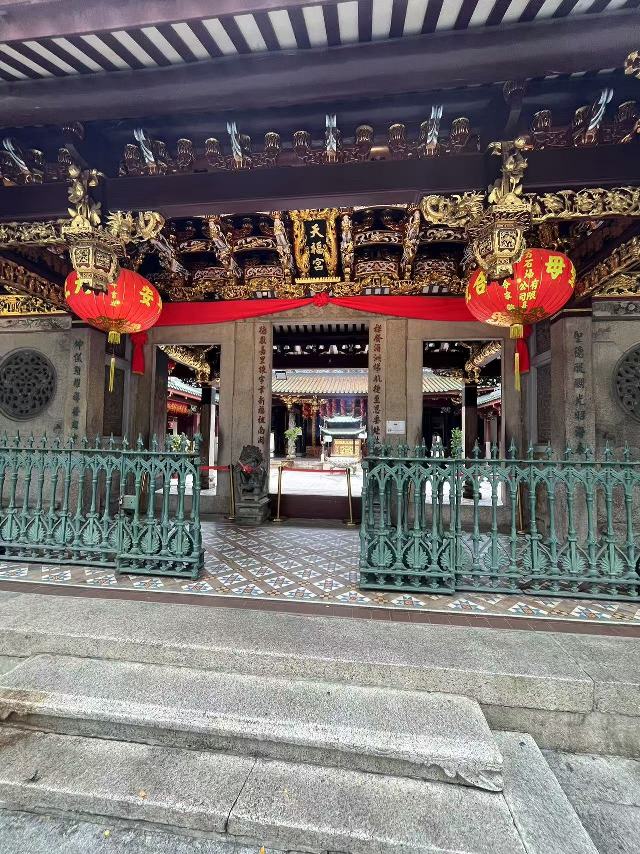
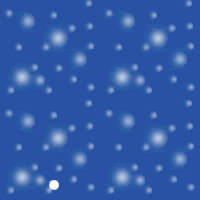

.jpg)
.jpg)
.jpg)
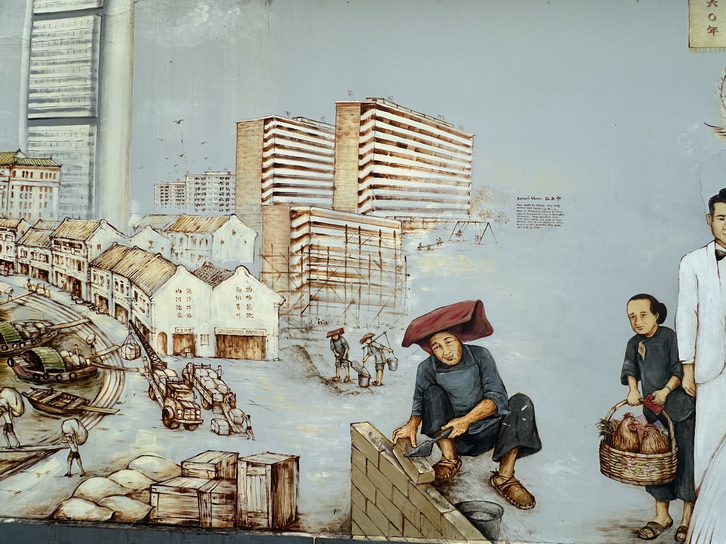
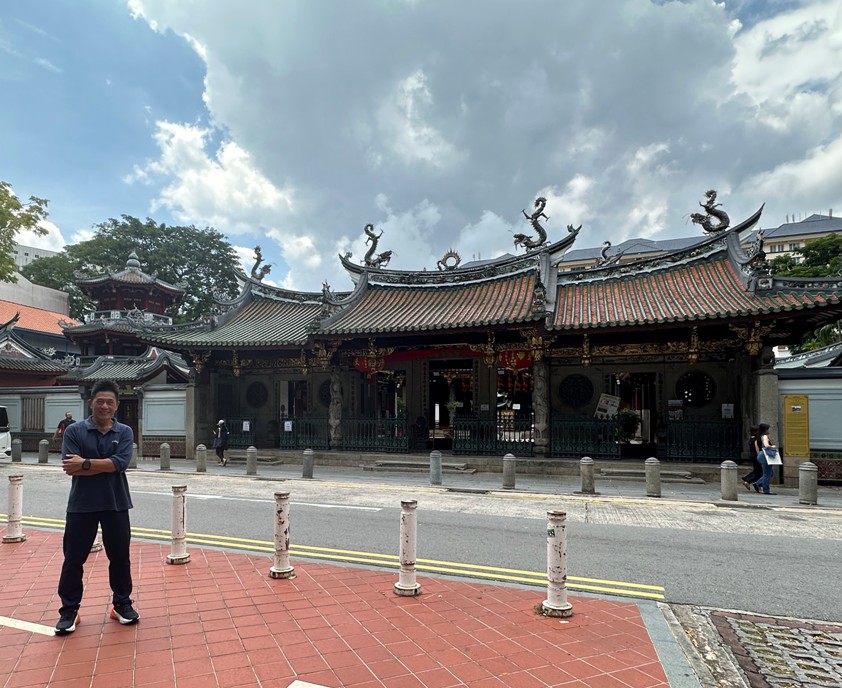
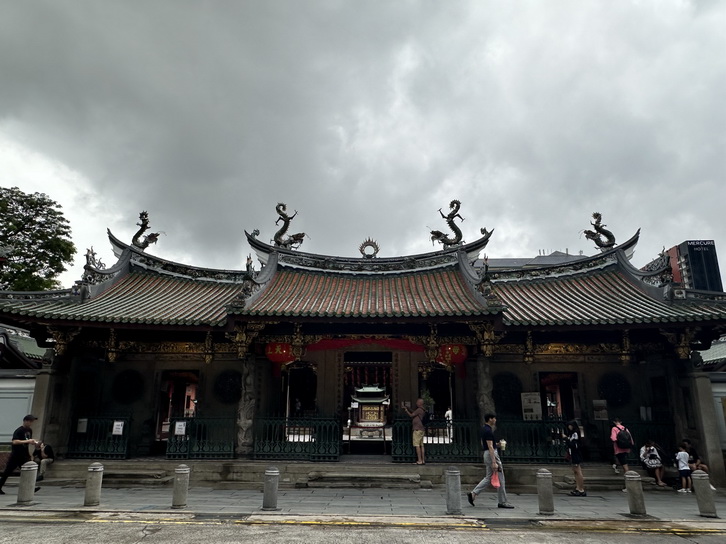
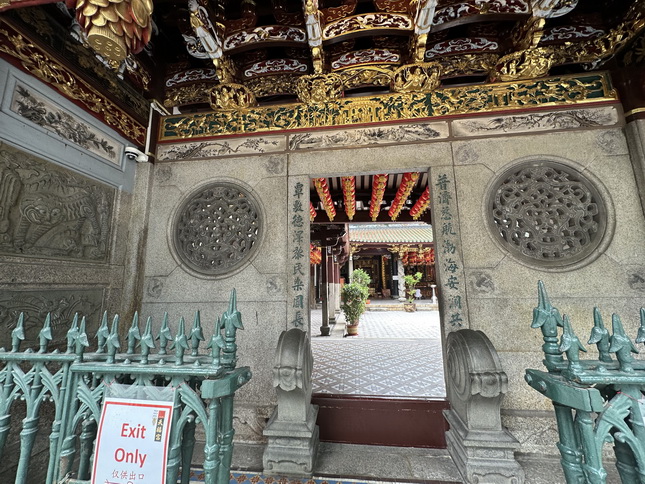
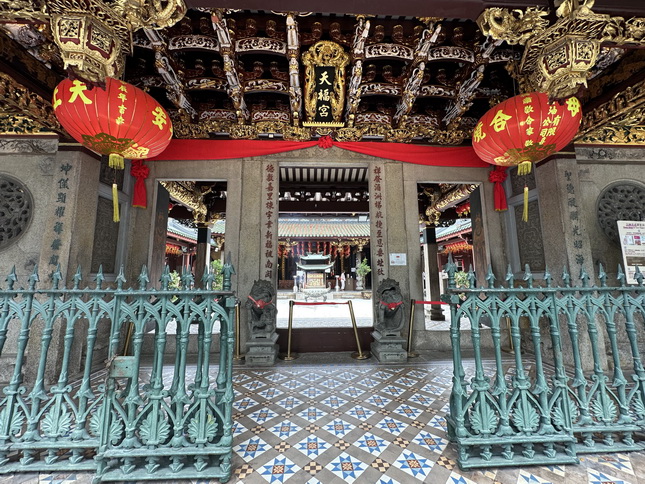
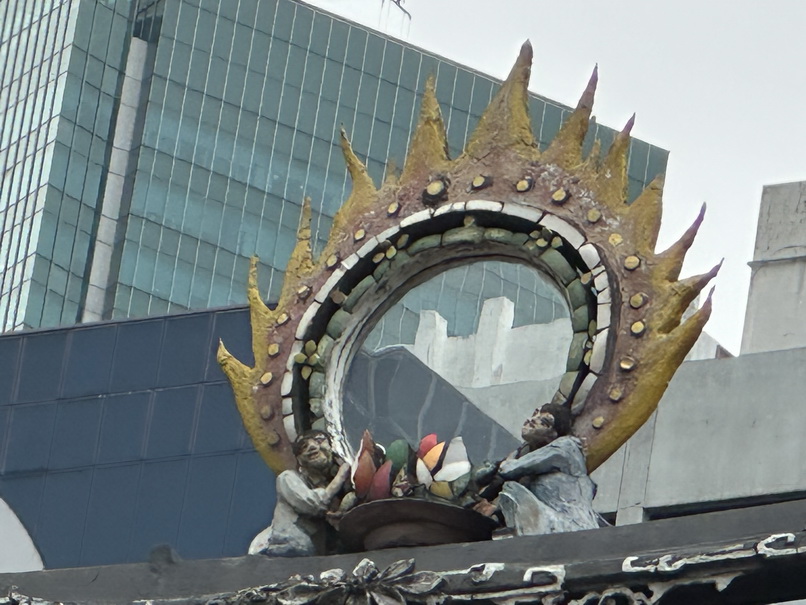
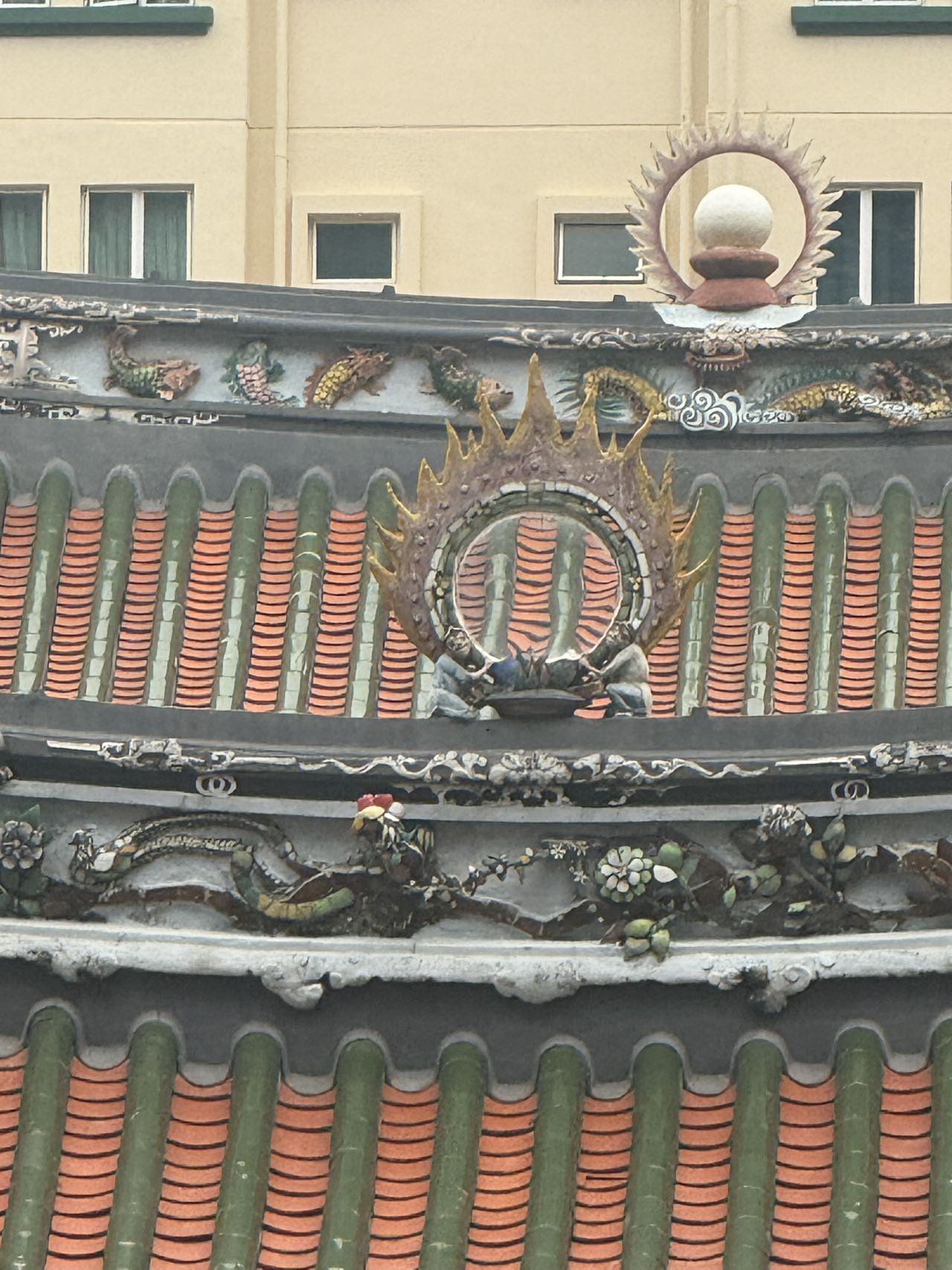 哼哈二将
哼哈二将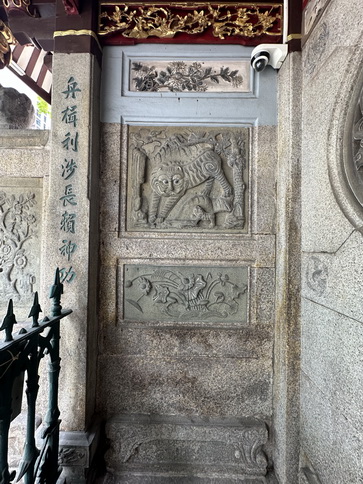
.jpg)
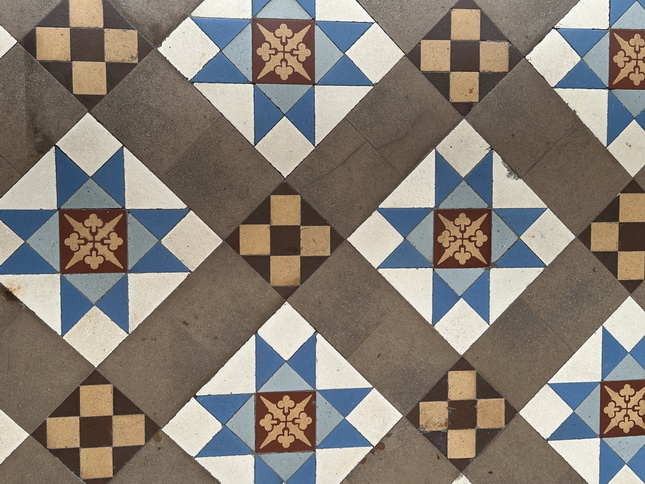

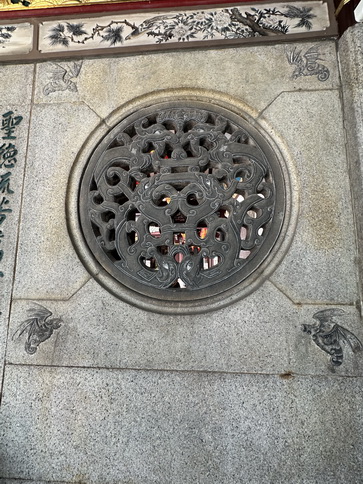

.jpg)
.jpg)
.jpg)
.jpg)
.jpg)
.jpg)
.jpg)
.jpg)
.jpg)
.jpg)
.jpg)
.jpg)
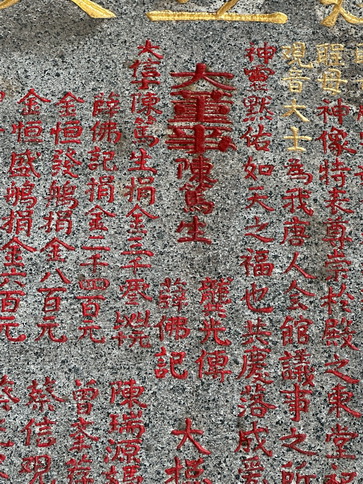
.jpg)
.jpg)
.jpg)
.jpg)
.jpg)

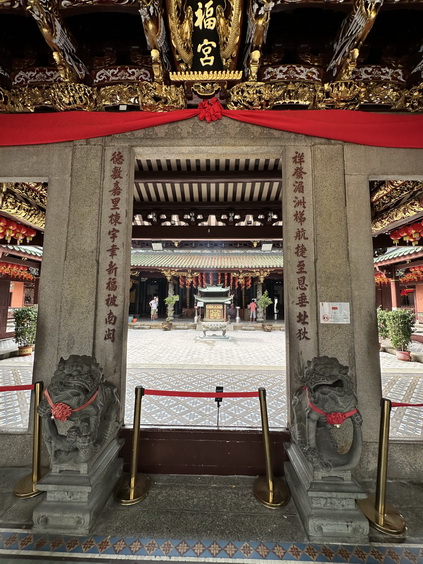
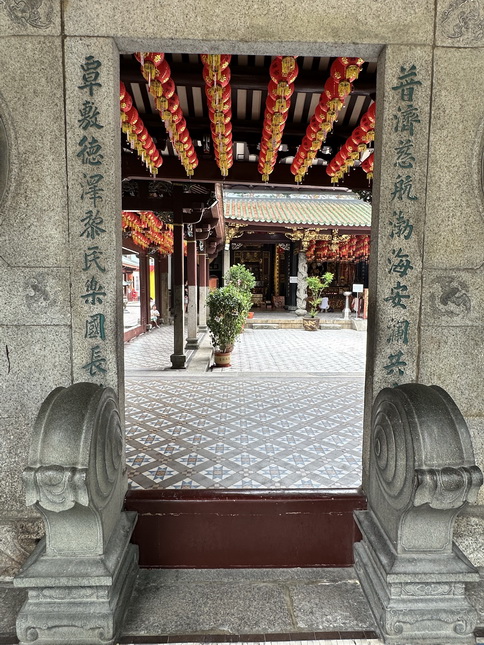
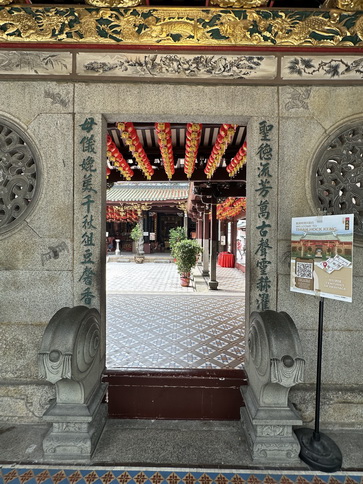
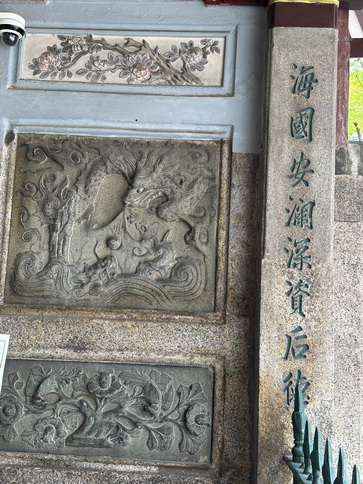
.jpg)
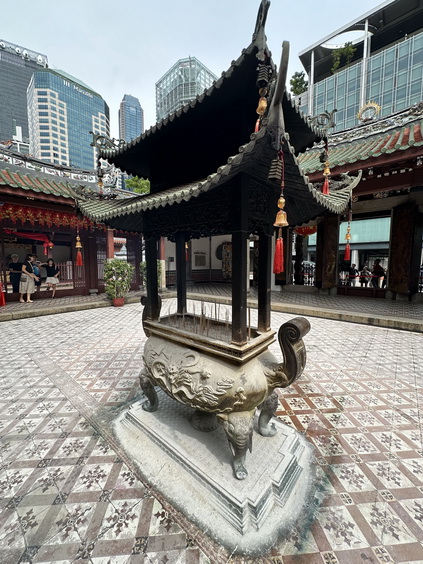
.jpg)
.jpg)
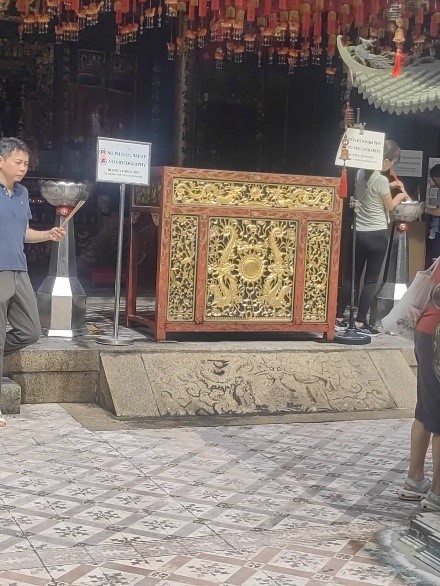
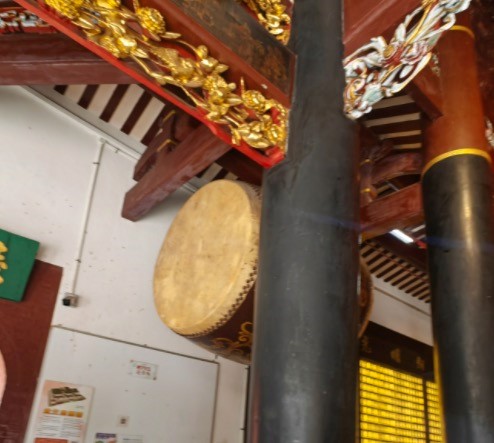
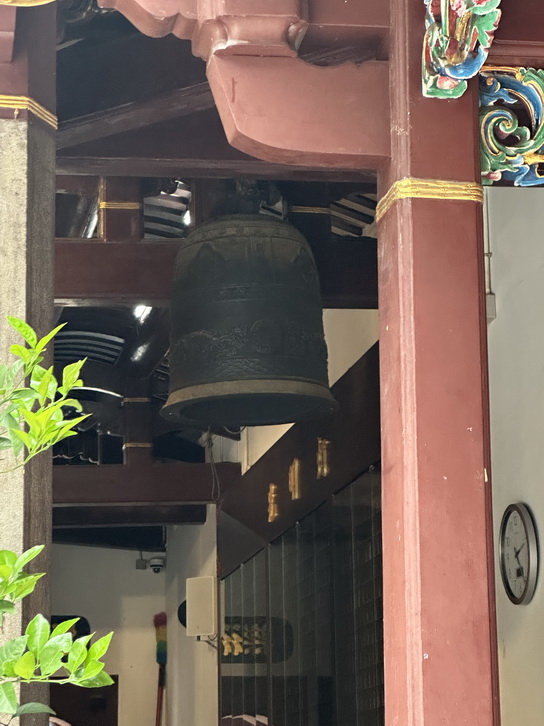
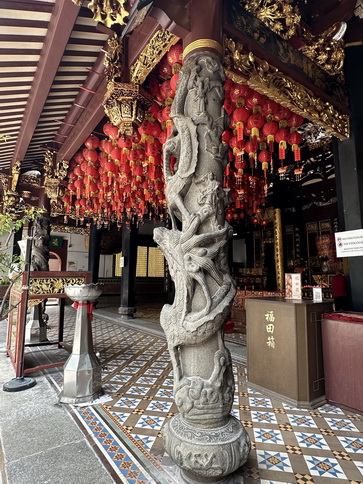
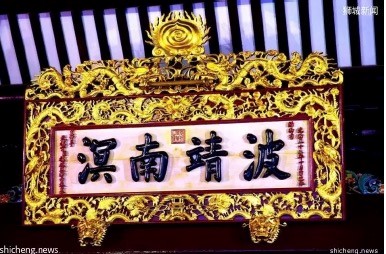
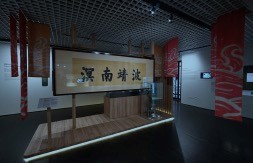
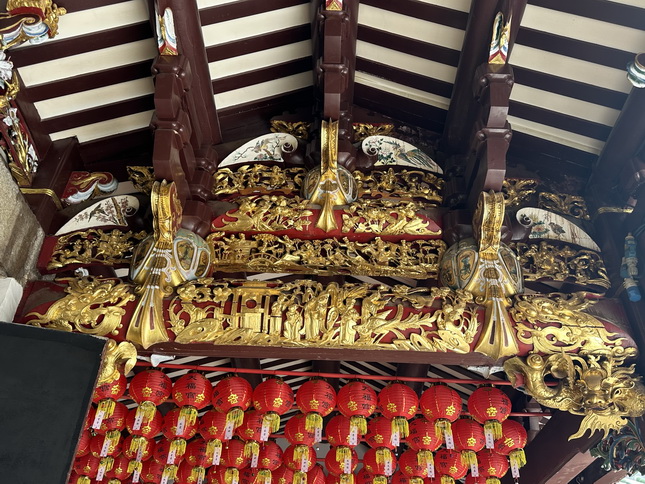
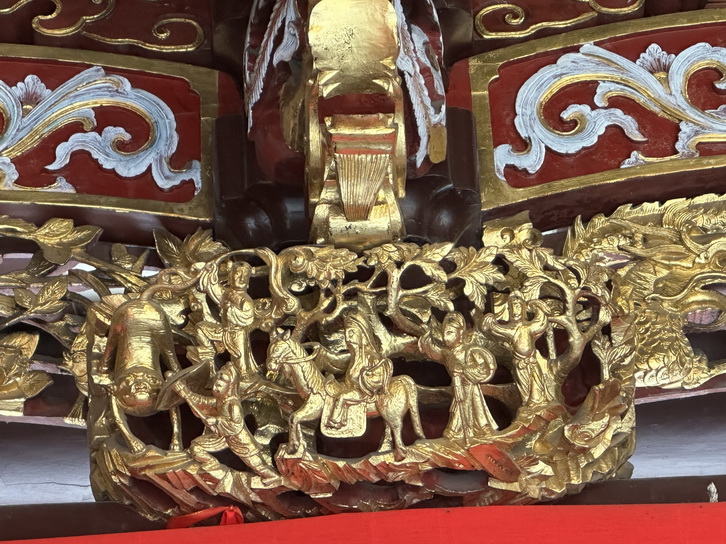
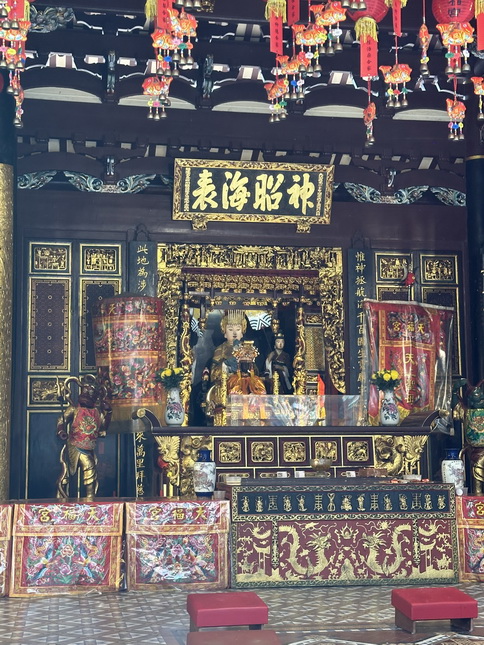
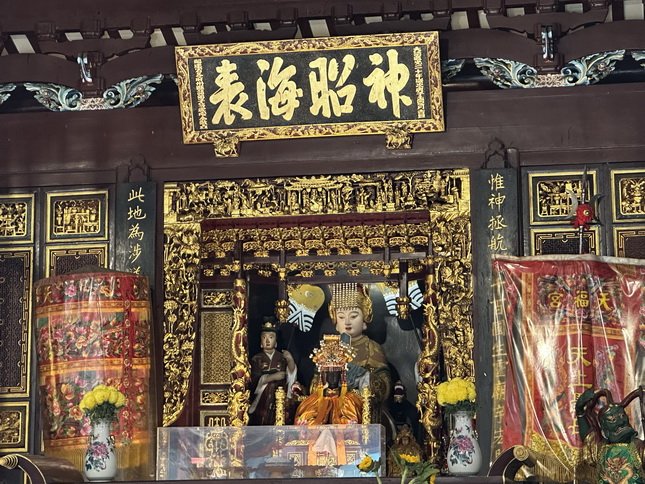
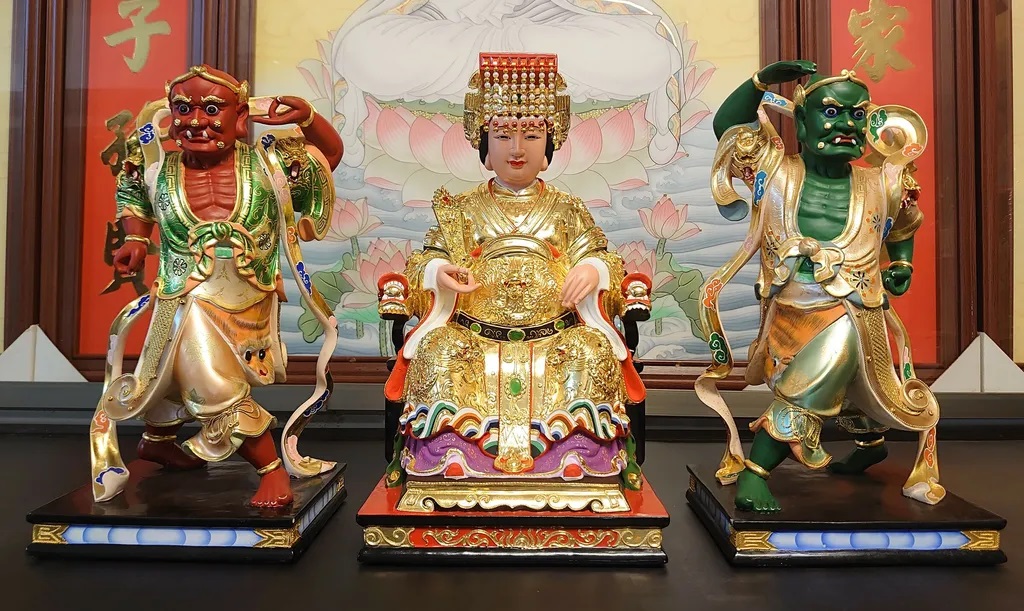
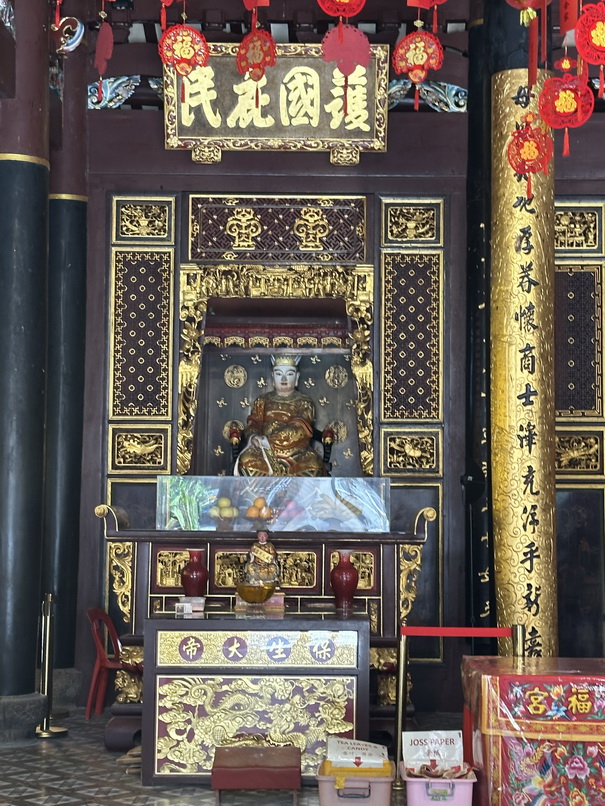
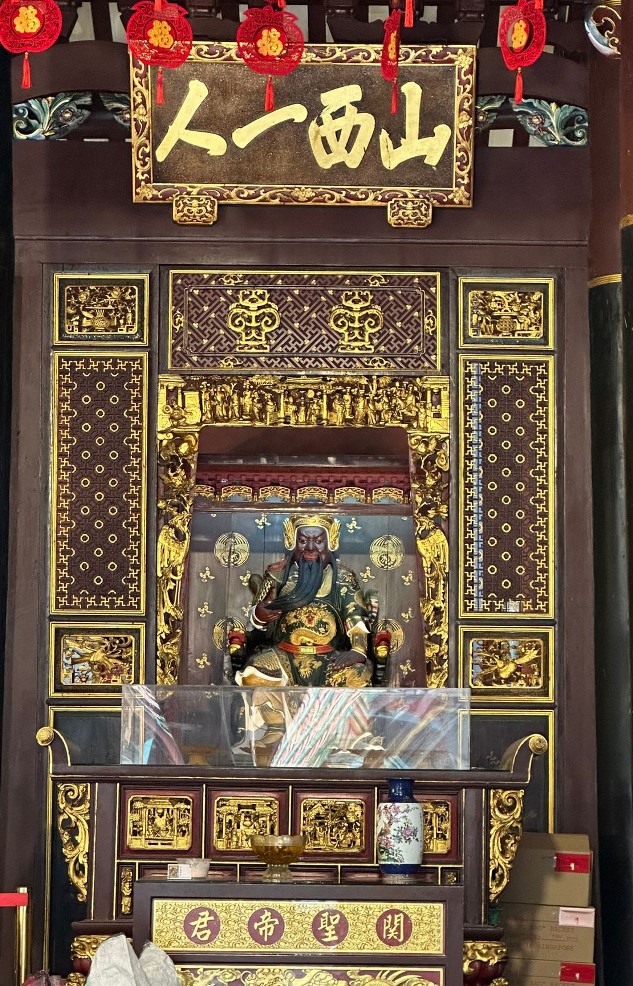
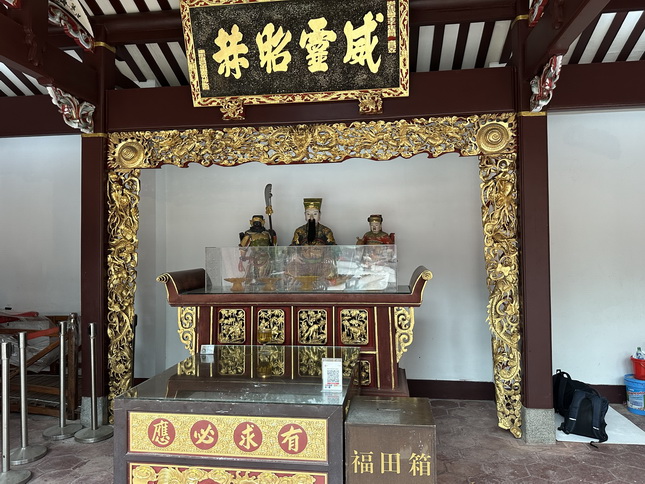
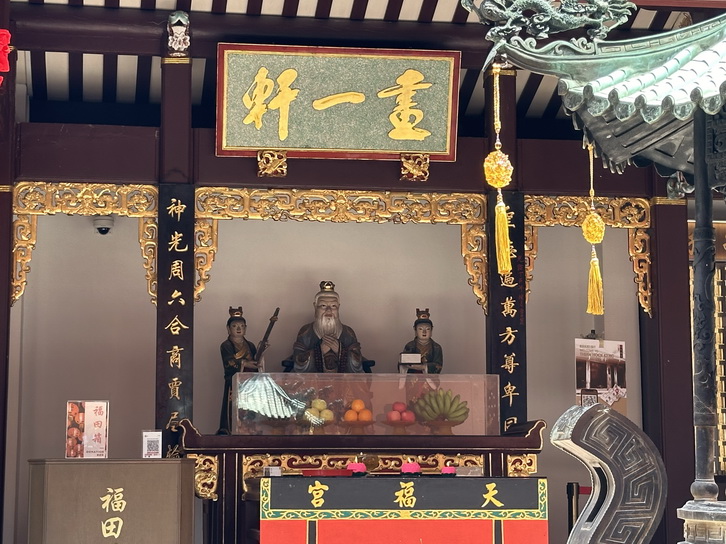
.jpg)
.jpg)
.jpg)
.jpg)
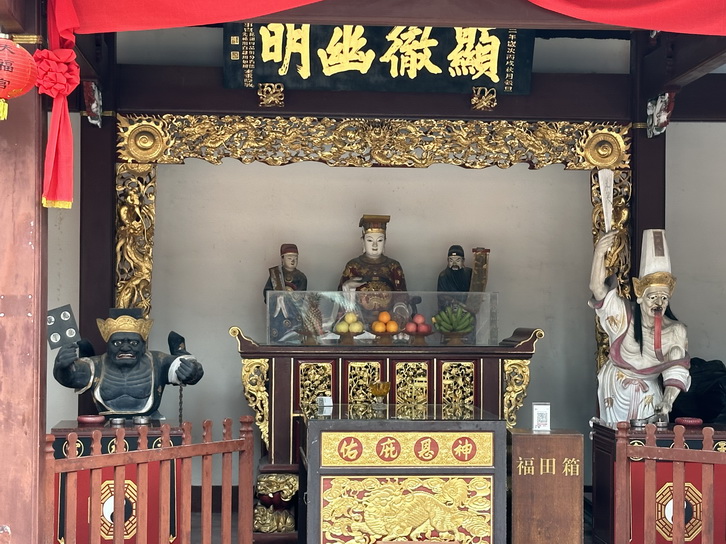
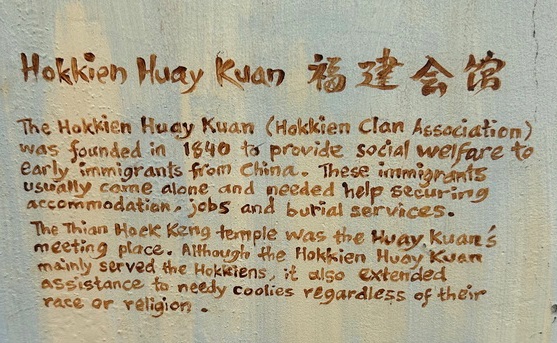
.jpg)
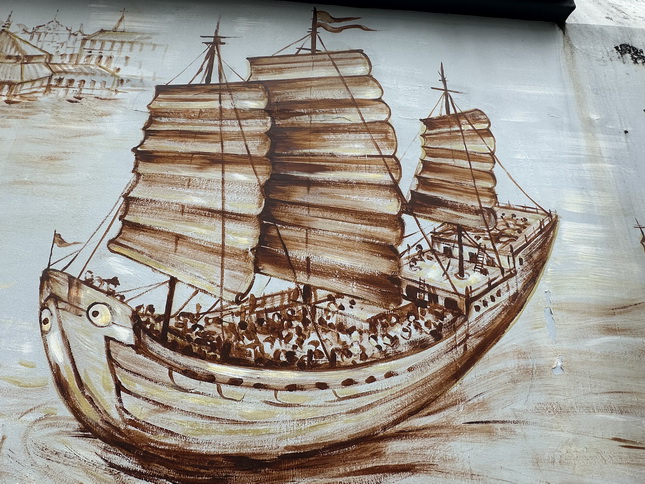
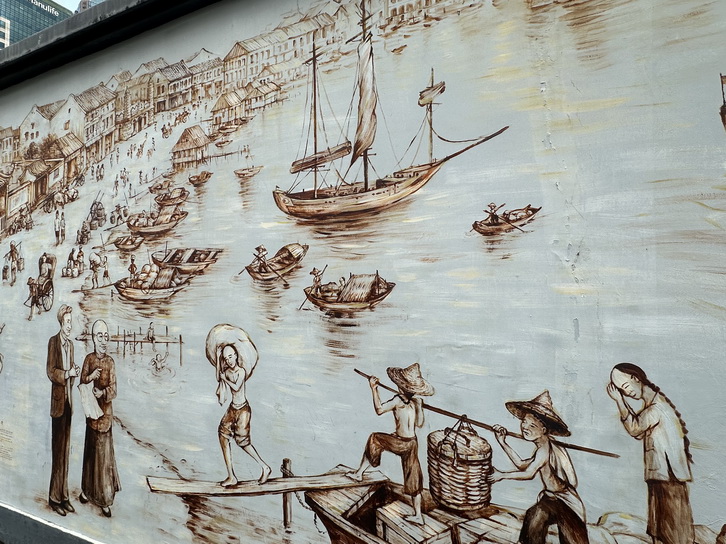
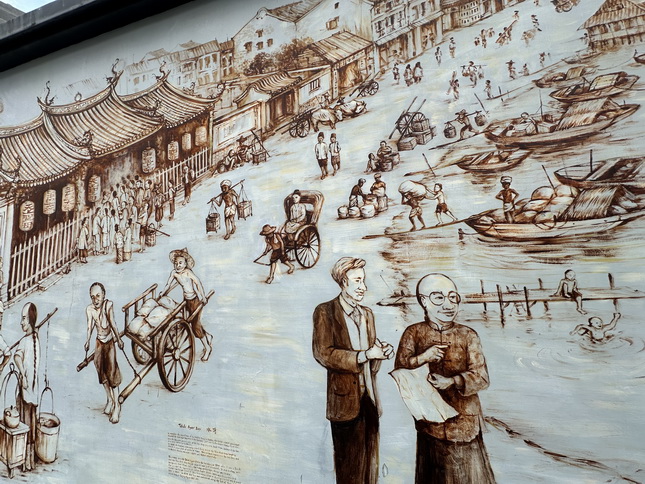
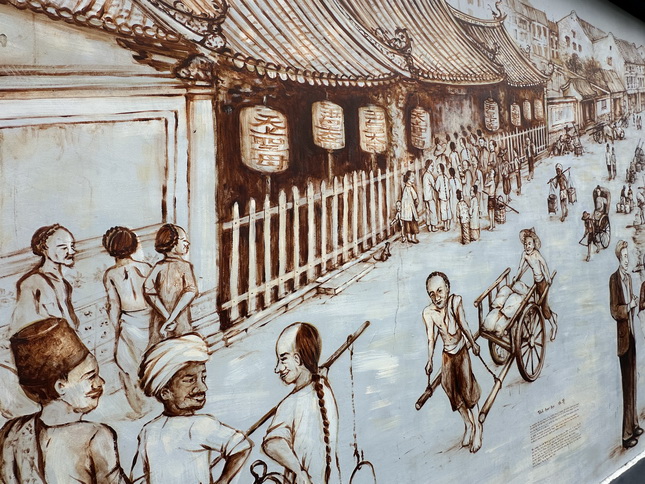
.jpg)
.jpg)
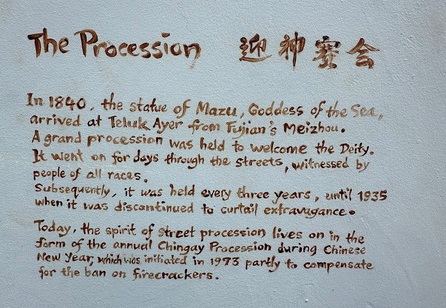
.jpg)
.jpg)
.jpg)
